SITXCOM002: Show Social and Cultural Sensitivity Assessment 2022
VerifiedAdded on 2022/09/17
|53
|6553
|26
AI Summary
Contribute Materials
Your contribution can guide someone’s learning journey. Share your
documents today.
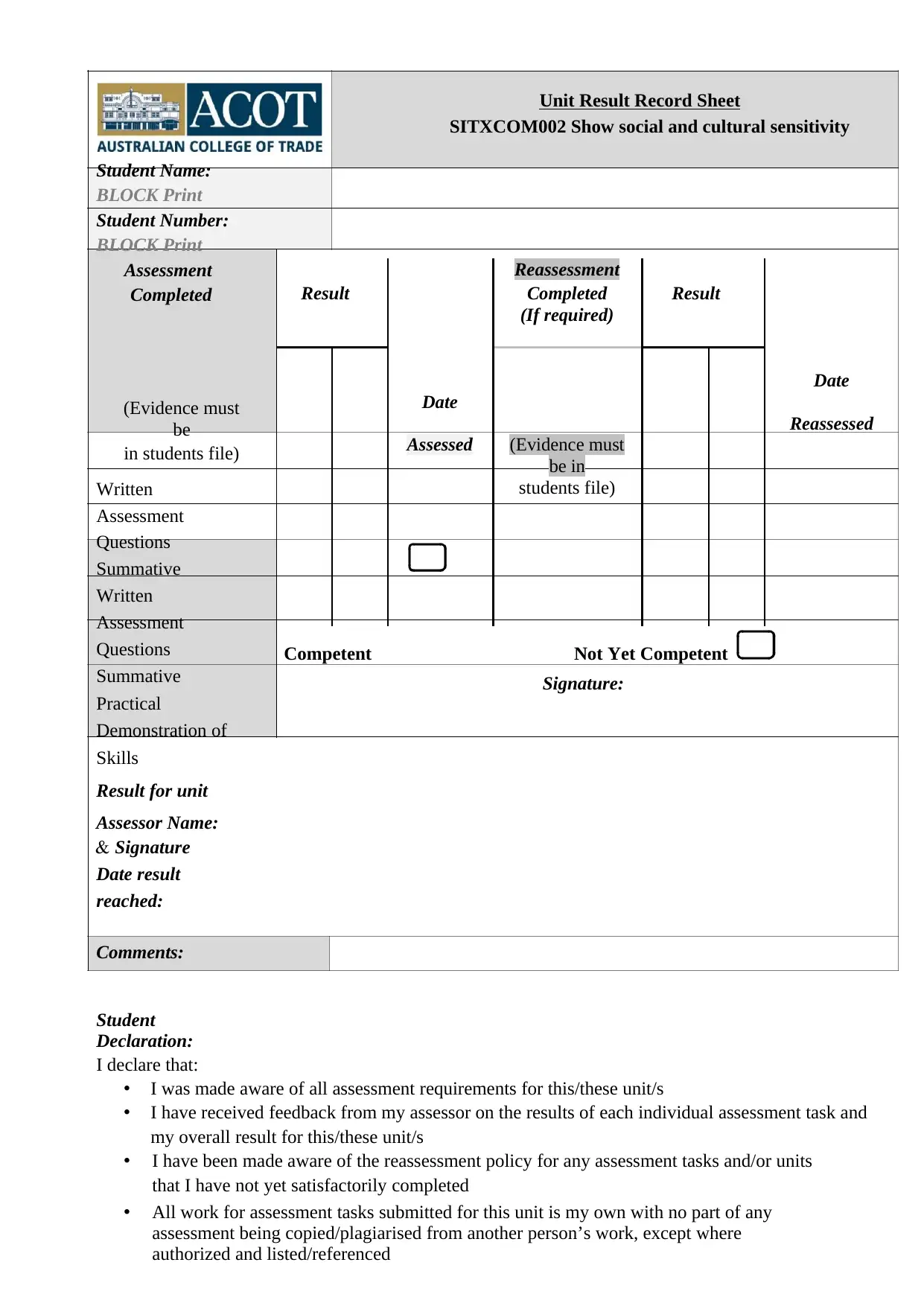
Unit Result Record Sheet
SITXCOM002 Show social and cultural sensitivity
Student Name:
BLOCK Print
Student Number:
BLOCK Print
Assessment
Completed
(Evidence must
be
in students file)
Written
Assessment
Questions
Summative
Written
Assessment
Questions
Summative
Practical
Demonstration of
Skills
Result for unit
Assessor Name:
& Signature
Date result
reached:
Comments:
Student
Declaration:
I declare that:
Reassessment
Result Completed Result
(If required)
Date
Date
Reassessed
Assessed (Evidence must
be in
students file)
Competent Not Yet Competent
Signature:
• I was made aware of all assessment requirements for this/these unit/s
• I have received feedback from my assessor on the results of each individual assessment task and
my overall result for this/these unit/s
• I have been made aware of the reassessment policy for any assessment tasks and/or units
that I have not yet satisfactorily completed
• All work for assessment tasks submitted for this unit is my own with no part of any
assessment being copied/plagiarised from another person’s work, except where
authorized and listed/referenced
SITXCOM002 Show social and cultural sensitivity
Student Name:
BLOCK Print
Student Number:
BLOCK Print
Assessment
Completed
(Evidence must
be
in students file)
Written
Assessment
Questions
Summative
Written
Assessment
Questions
Summative
Practical
Demonstration of
Skills
Result for unit
Assessor Name:
& Signature
Date result
reached:
Comments:
Student
Declaration:
I declare that:
Reassessment
Result Completed Result
(If required)
Date
Date
Reassessed
Assessed (Evidence must
be in
students file)
Competent Not Yet Competent
Signature:
• I was made aware of all assessment requirements for this/these unit/s
• I have received feedback from my assessor on the results of each individual assessment task and
my overall result for this/these unit/s
• I have been made aware of the reassessment policy for any assessment tasks and/or units
that I have not yet satisfactorily completed
• All work for assessment tasks submitted for this unit is my own with no part of any
assessment being copied/plagiarised from another person’s work, except where
authorized and listed/referenced
Secure Best Marks with AI Grader
Need help grading? Try our AI Grader for instant feedback on your assignments.
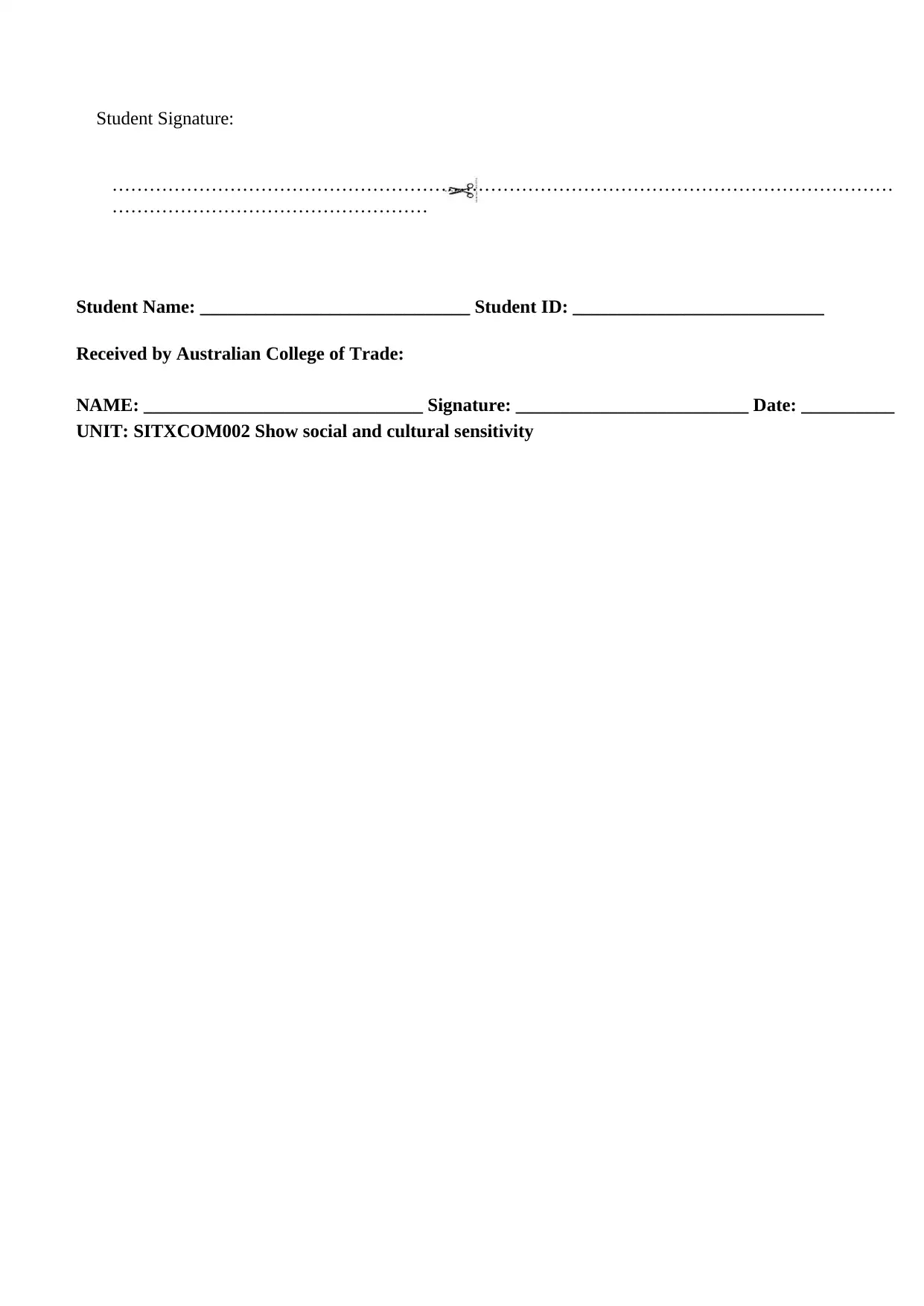
Student Signature:
………………………………………………………………………………………………………………
……………………………………………
Student Name: _____________________________ Student ID: ___________________________
Received by Australian College of Trade:
NAME: ______________________________ Signature: _________________________ Date: __________
UNIT: SITXCOM002 Show social and cultural sensitivity
………………………………………………………………………………………………………………
……………………………………………
Student Name: _____________________________ Student ID: ___________________________
Received by Australian College of Trade:
NAME: ______________________________ Signature: _________________________ Date: __________
UNIT: SITXCOM002 Show social and cultural sensitivity
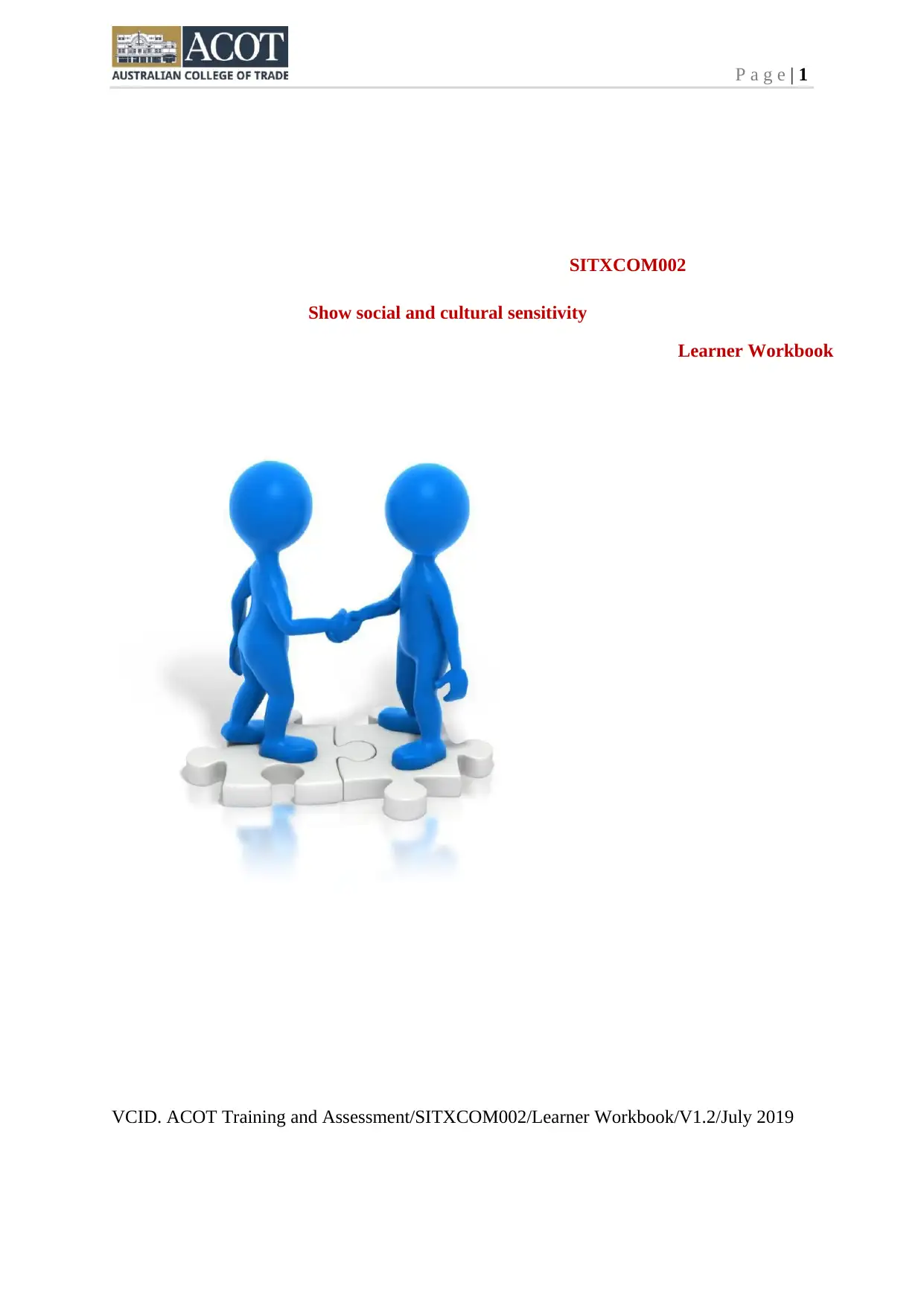
P a g e | 1
SITXCOM002
Show social and cultural sensitivity
Learner Workbook
VCID. ACOT Training and Assessment/SITXCOM002/Learner Workbook/V1.2/July 2019
SITXCOM002
Show social and cultural sensitivity
Learner Workbook
VCID. ACOT Training and Assessment/SITXCOM002/Learner Workbook/V1.2/July 2019
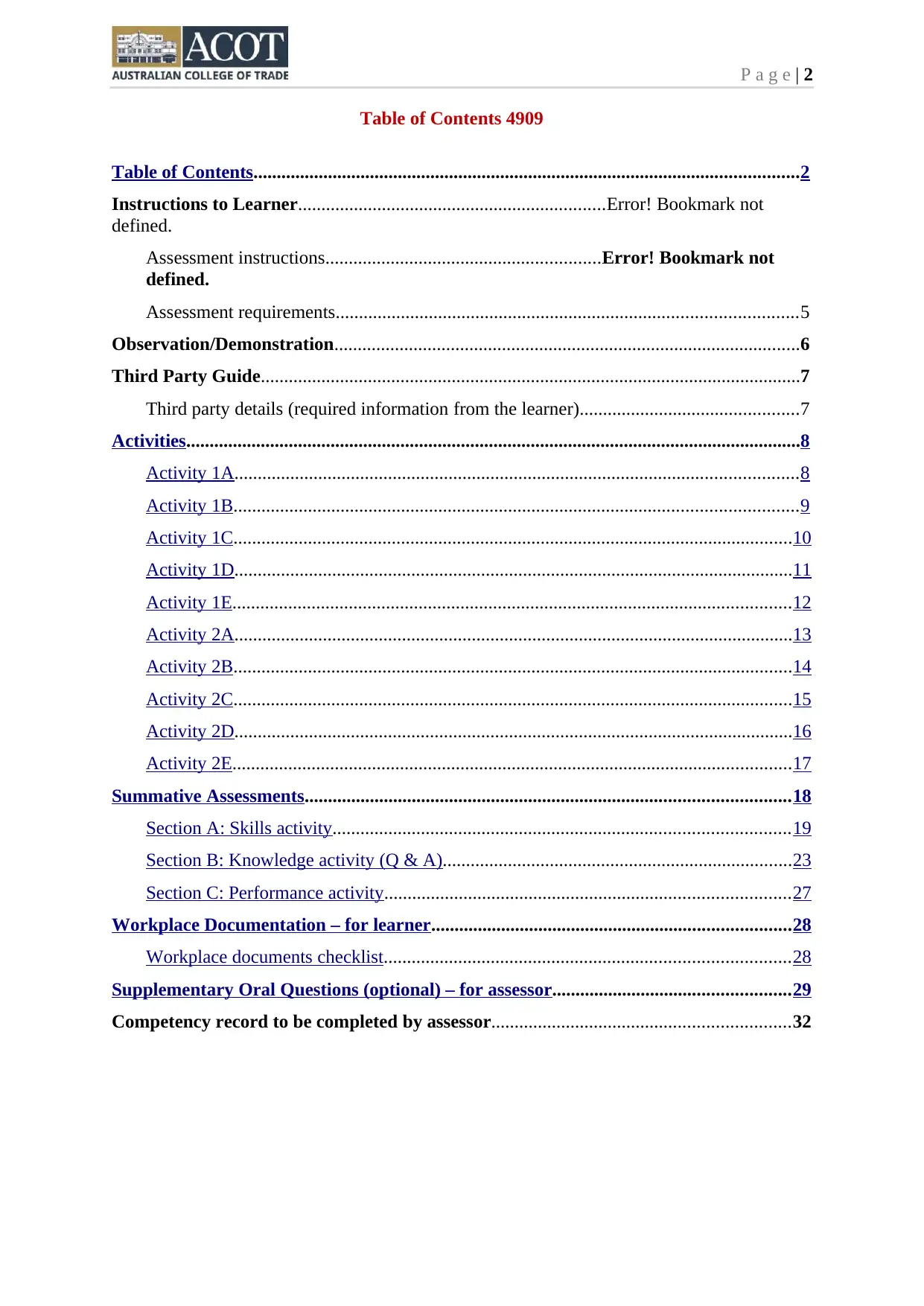
P a g e | 2
Table of Contents 4909
Table of Contents.....................................................................................................................2
Instructions to Learner..................................................................Error! Bookmark not
defined.
Assessment instructions...........................................................Error! Bookmark not
defined.
Assessment requirements...................................................................................................5
Observation/Demonstration....................................................................................................6
Third Party Guide....................................................................................................................7
Third party details (required information from the learner)...............................................7
Activities....................................................................................................................................8
Activity 1A.........................................................................................................................8
Activity 1B.........................................................................................................................9
Activity 1C........................................................................................................................10
Activity 1D........................................................................................................................11
Activity 1E........................................................................................................................12
Activity 2A........................................................................................................................13
Activity 2B........................................................................................................................14
Activity 2C........................................................................................................................15
Activity 2D........................................................................................................................16
Activity 2E........................................................................................................................17
Summative Assessments........................................................................................................18
Section A: Skills activity..................................................................................................19
Section B: Knowledge activity (Q & A)...........................................................................23
Section C: Performance activity.......................................................................................27
Workplace Documentation – for learner.............................................................................28
Workplace documents checklist.......................................................................................28
Supplementary Oral Questions (optional) – for assessor...................................................29
Competency record to be completed by assessor................................................................32
Table of Contents 4909
Table of Contents.....................................................................................................................2
Instructions to Learner..................................................................Error! Bookmark not
defined.
Assessment instructions...........................................................Error! Bookmark not
defined.
Assessment requirements...................................................................................................5
Observation/Demonstration....................................................................................................6
Third Party Guide....................................................................................................................7
Third party details (required information from the learner)...............................................7
Activities....................................................................................................................................8
Activity 1A.........................................................................................................................8
Activity 1B.........................................................................................................................9
Activity 1C........................................................................................................................10
Activity 1D........................................................................................................................11
Activity 1E........................................................................................................................12
Activity 2A........................................................................................................................13
Activity 2B........................................................................................................................14
Activity 2C........................................................................................................................15
Activity 2D........................................................................................................................16
Activity 2E........................................................................................................................17
Summative Assessments........................................................................................................18
Section A: Skills activity..................................................................................................19
Section B: Knowledge activity (Q & A)...........................................................................23
Section C: Performance activity.......................................................................................27
Workplace Documentation – for learner.............................................................................28
Workplace documents checklist.......................................................................................28
Supplementary Oral Questions (optional) – for assessor...................................................29
Competency record to be completed by assessor................................................................32
Secure Best Marks with AI Grader
Need help grading? Try our AI Grader for instant feedback on your assignments.

VCID. ACOT Training and Assessment/SITXCOM002/Learner Workbook/V1.2/July 2019
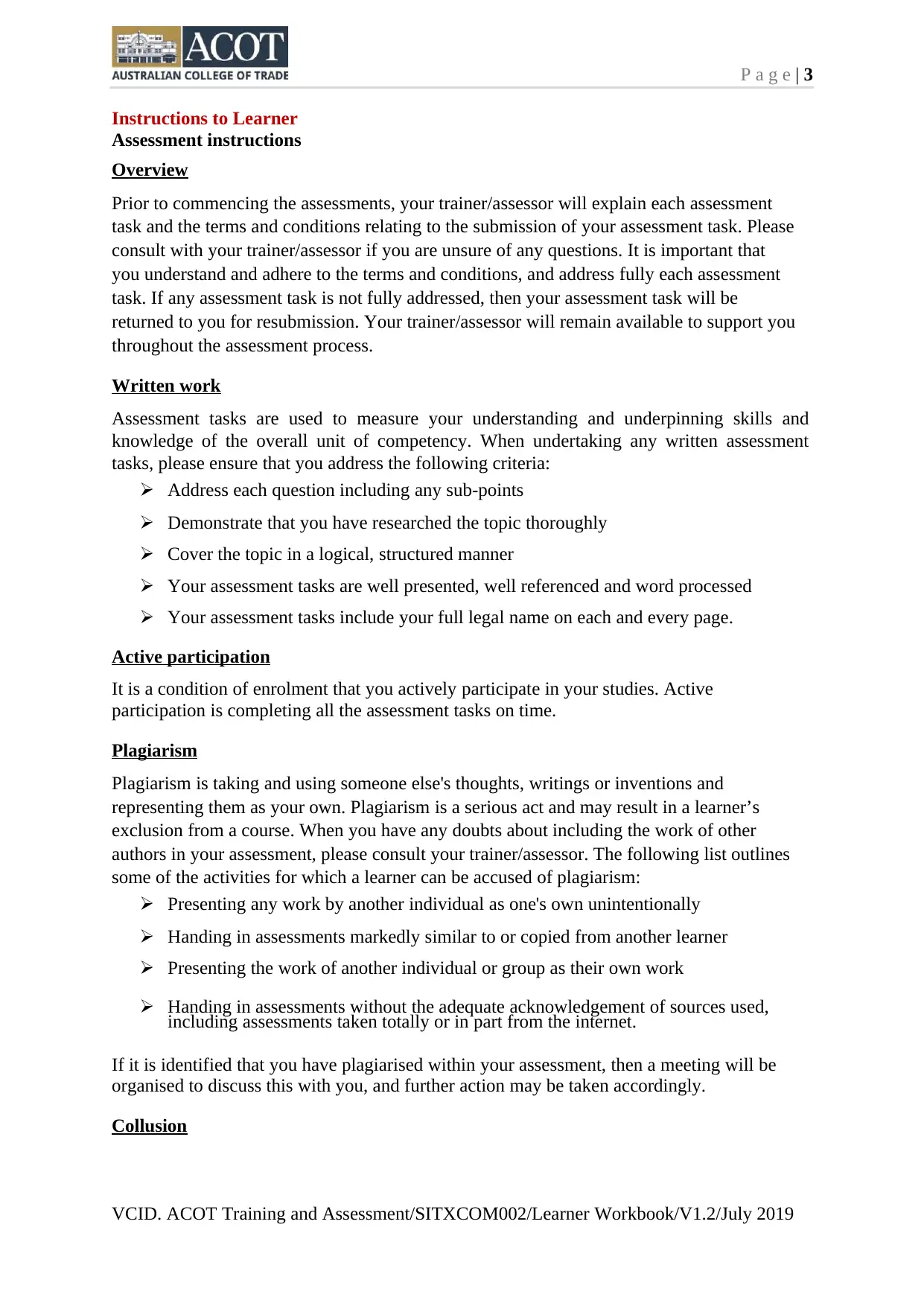
P a g e | 3
Instructions to Learner
Assessment instructions
Overview
Prior to commencing the assessments, your trainer/assessor will explain each assessment
task and the terms and conditions relating to the submission of your assessment task. Please
consult with your trainer/assessor if you are unsure of any questions. It is important that
you understand and adhere to the terms and conditions, and address fully each assessment
task. If any assessment task is not fully addressed, then your assessment task will be
returned to you for resubmission. Your trainer/assessor will remain available to support you
throughout the assessment process.
Written work
Assessment tasks are used to measure your understanding and underpinning skills and
knowledge of the overall unit of competency. When undertaking any written assessment
tasks, please ensure that you address the following criteria:
➢ Address each question including any sub-points
➢ Demonstrate that you have researched the topic thoroughly
➢ Cover the topic in a logical, structured manner
➢ Your assessment tasks are well presented, well referenced and word processed
➢ Your assessment tasks include your full legal name on each and every page.
Active participation
It is a condition of enrolment that you actively participate in your studies. Active
participation is completing all the assessment tasks on time.
Plagiarism
Plagiarism is taking and using someone else's thoughts, writings or inventions and
representing them as your own. Plagiarism is a serious act and may result in a learner’s
exclusion from a course. When you have any doubts about including the work of other
authors in your assessment, please consult your trainer/assessor. The following list outlines
some of the activities for which a learner can be accused of plagiarism:
➢ Presenting any work by another individual as one's own unintentionally
➢ Handing in assessments markedly similar to or copied from another learner
➢ Presenting the work of another individual or group as their own work
➢ Handing in assessments without the adequate acknowledgement of sources used,
including assessments taken totally or in part from the internet.
If it is identified that you have plagiarised within your assessment, then a meeting will be
organised to discuss this with you, and further action may be taken accordingly.
Collusion
VCID. ACOT Training and Assessment/SITXCOM002/Learner Workbook/V1.2/July 2019
Instructions to Learner
Assessment instructions
Overview
Prior to commencing the assessments, your trainer/assessor will explain each assessment
task and the terms and conditions relating to the submission of your assessment task. Please
consult with your trainer/assessor if you are unsure of any questions. It is important that
you understand and adhere to the terms and conditions, and address fully each assessment
task. If any assessment task is not fully addressed, then your assessment task will be
returned to you for resubmission. Your trainer/assessor will remain available to support you
throughout the assessment process.
Written work
Assessment tasks are used to measure your understanding and underpinning skills and
knowledge of the overall unit of competency. When undertaking any written assessment
tasks, please ensure that you address the following criteria:
➢ Address each question including any sub-points
➢ Demonstrate that you have researched the topic thoroughly
➢ Cover the topic in a logical, structured manner
➢ Your assessment tasks are well presented, well referenced and word processed
➢ Your assessment tasks include your full legal name on each and every page.
Active participation
It is a condition of enrolment that you actively participate in your studies. Active
participation is completing all the assessment tasks on time.
Plagiarism
Plagiarism is taking and using someone else's thoughts, writings or inventions and
representing them as your own. Plagiarism is a serious act and may result in a learner’s
exclusion from a course. When you have any doubts about including the work of other
authors in your assessment, please consult your trainer/assessor. The following list outlines
some of the activities for which a learner can be accused of plagiarism:
➢ Presenting any work by another individual as one's own unintentionally
➢ Handing in assessments markedly similar to or copied from another learner
➢ Presenting the work of another individual or group as their own work
➢ Handing in assessments without the adequate acknowledgement of sources used,
including assessments taken totally or in part from the internet.
If it is identified that you have plagiarised within your assessment, then a meeting will be
organised to discuss this with you, and further action may be taken accordingly.
Collusion
VCID. ACOT Training and Assessment/SITXCOM002/Learner Workbook/V1.2/July 2019
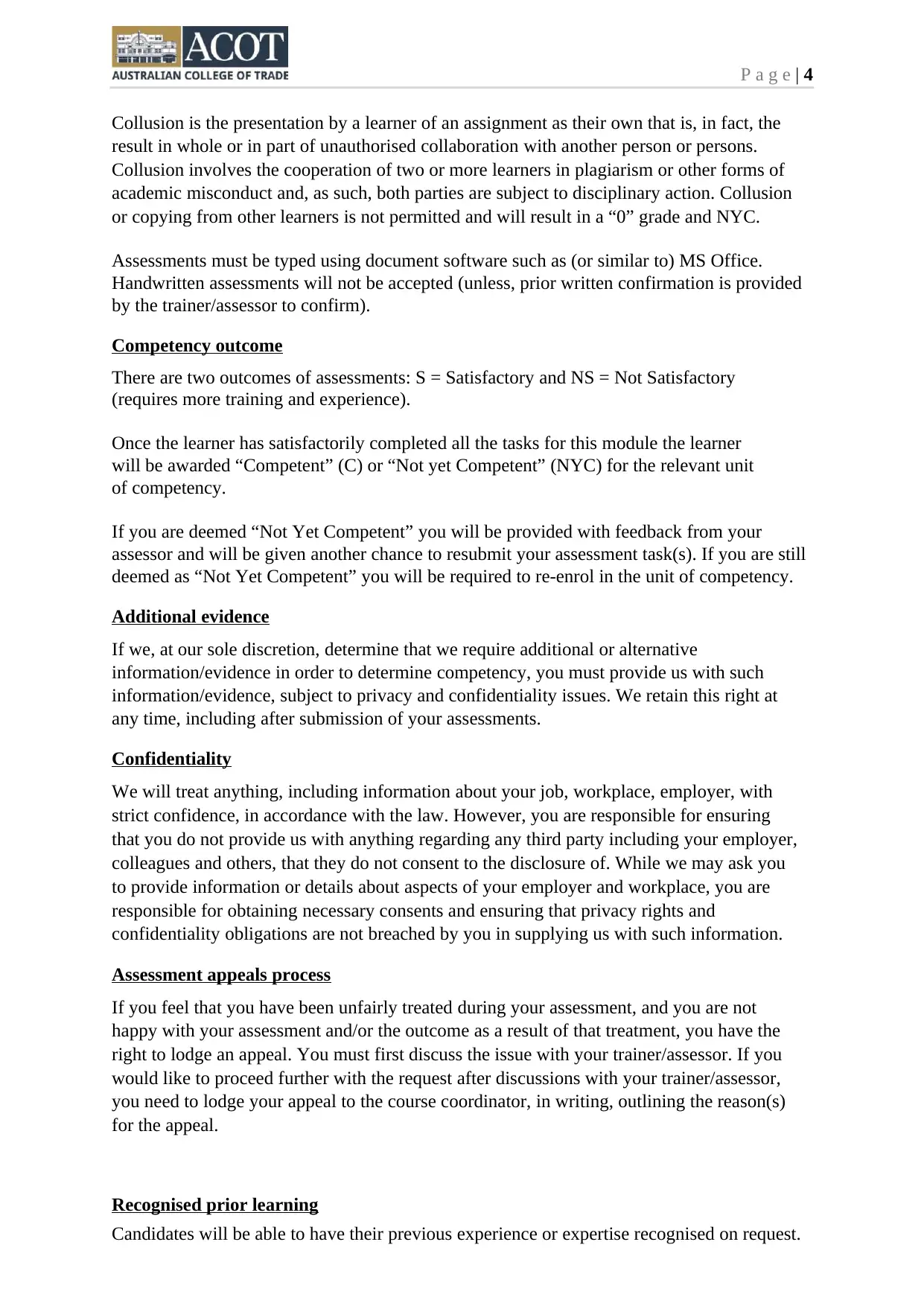
P a g e | 4
Collusion is the presentation by a learner of an assignment as their own that is, in fact, the
result in whole or in part of unauthorised collaboration with another person or persons.
Collusion involves the cooperation of two or more learners in plagiarism or other forms of
academic misconduct and, as such, both parties are subject to disciplinary action. Collusion
or copying from other learners is not permitted and will result in a “0” grade and NYC.
Assessments must be typed using document software such as (or similar to) MS Office.
Handwritten assessments will not be accepted (unless, prior written confirmation is provided
by the trainer/assessor to confirm).
Competency outcome
There are two outcomes of assessments: S = Satisfactory and NS = Not Satisfactory
(requires more training and experience).
Once the learner has satisfactorily completed all the tasks for this module the learner
will be awarded “Competent” (C) or “Not yet Competent” (NYC) for the relevant unit
of competency.
If you are deemed “Not Yet Competent” you will be provided with feedback from your
assessor and will be given another chance to resubmit your assessment task(s). If you are still
deemed as “Not Yet Competent” you will be required to re-enrol in the unit of competency.
Additional evidence
If we, at our sole discretion, determine that we require additional or alternative
information/evidence in order to determine competency, you must provide us with such
information/evidence, subject to privacy and confidentiality issues. We retain this right at
any time, including after submission of your assessments.
Confidentiality
We will treat anything, including information about your job, workplace, employer, with
strict confidence, in accordance with the law. However, you are responsible for ensuring
that you do not provide us with anything regarding any third party including your employer,
colleagues and others, that they do not consent to the disclosure of. While we may ask you
to provide information or details about aspects of your employer and workplace, you are
responsible for obtaining necessary consents and ensuring that privacy rights and
confidentiality obligations are not breached by you in supplying us with such information.
Assessment appeals process
If you feel that you have been unfairly treated during your assessment, and you are not
happy with your assessment and/or the outcome as a result of that treatment, you have the
right to lodge an appeal. You must first discuss the issue with your trainer/assessor. If you
would like to proceed further with the request after discussions with your trainer/assessor,
you need to lodge your appeal to the course coordinator, in writing, outlining the reason(s)
for the appeal.
Recognised prior learning
Candidates will be able to have their previous experience or expertise recognised on request.
Collusion is the presentation by a learner of an assignment as their own that is, in fact, the
result in whole or in part of unauthorised collaboration with another person or persons.
Collusion involves the cooperation of two or more learners in plagiarism or other forms of
academic misconduct and, as such, both parties are subject to disciplinary action. Collusion
or copying from other learners is not permitted and will result in a “0” grade and NYC.
Assessments must be typed using document software such as (or similar to) MS Office.
Handwritten assessments will not be accepted (unless, prior written confirmation is provided
by the trainer/assessor to confirm).
Competency outcome
There are two outcomes of assessments: S = Satisfactory and NS = Not Satisfactory
(requires more training and experience).
Once the learner has satisfactorily completed all the tasks for this module the learner
will be awarded “Competent” (C) or “Not yet Competent” (NYC) for the relevant unit
of competency.
If you are deemed “Not Yet Competent” you will be provided with feedback from your
assessor and will be given another chance to resubmit your assessment task(s). If you are still
deemed as “Not Yet Competent” you will be required to re-enrol in the unit of competency.
Additional evidence
If we, at our sole discretion, determine that we require additional or alternative
information/evidence in order to determine competency, you must provide us with such
information/evidence, subject to privacy and confidentiality issues. We retain this right at
any time, including after submission of your assessments.
Confidentiality
We will treat anything, including information about your job, workplace, employer, with
strict confidence, in accordance with the law. However, you are responsible for ensuring
that you do not provide us with anything regarding any third party including your employer,
colleagues and others, that they do not consent to the disclosure of. While we may ask you
to provide information or details about aspects of your employer and workplace, you are
responsible for obtaining necessary consents and ensuring that privacy rights and
confidentiality obligations are not breached by you in supplying us with such information.
Assessment appeals process
If you feel that you have been unfairly treated during your assessment, and you are not
happy with your assessment and/or the outcome as a result of that treatment, you have the
right to lodge an appeal. You must first discuss the issue with your trainer/assessor. If you
would like to proceed further with the request after discussions with your trainer/assessor,
you need to lodge your appeal to the course coordinator, in writing, outlining the reason(s)
for the appeal.
Recognised prior learning
Candidates will be able to have their previous experience or expertise recognised on request.
Paraphrase This Document
Need a fresh take? Get an instant paraphrase of this document with our AI Paraphraser

VCID. ACOT Training and Assessment/SITXCOM002/Learner Workbook/V1.2/July 2019
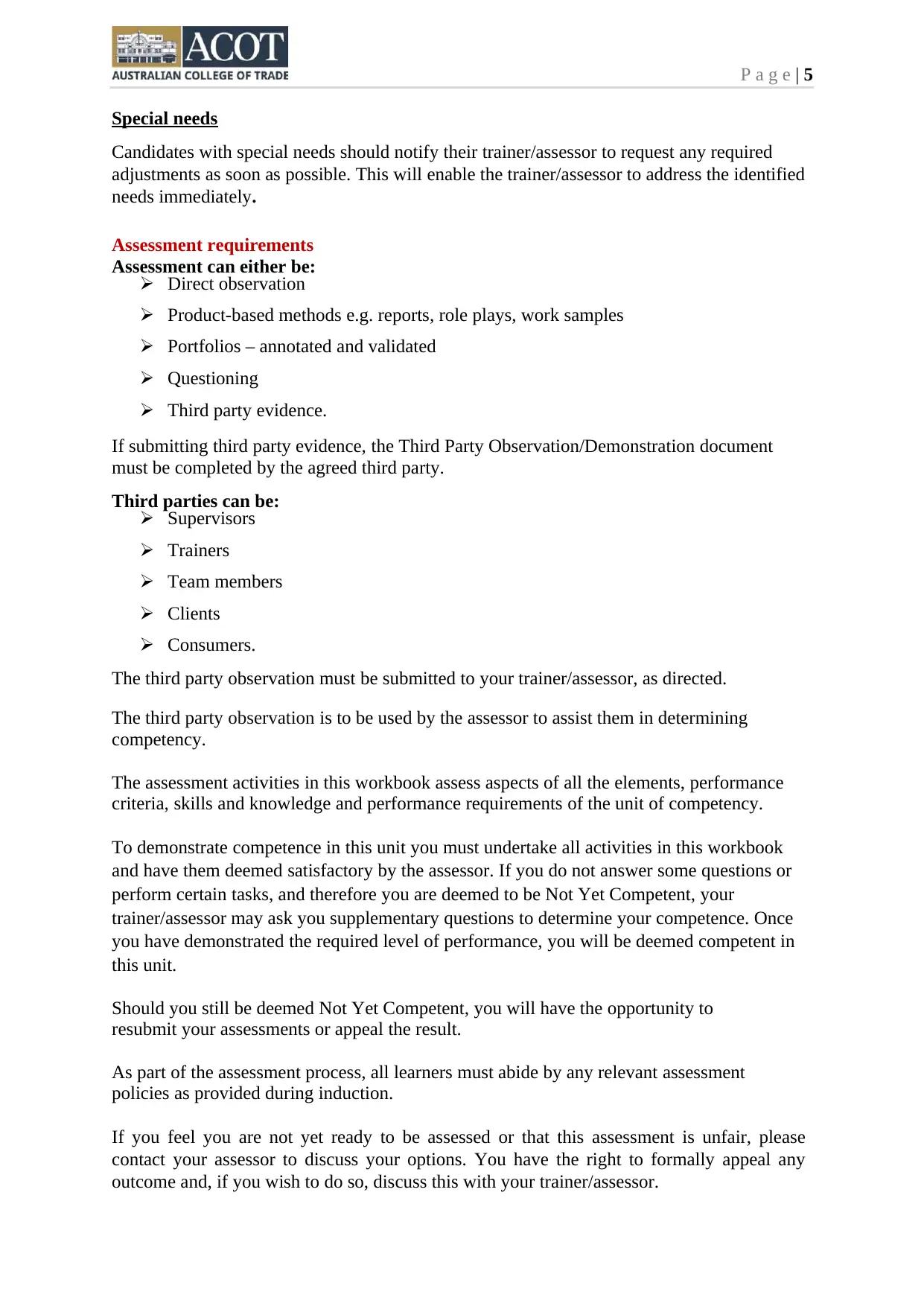
P a g e | 5
Special needs
Candidates with special needs should notify their trainer/assessor to request any required
adjustments as soon as possible. This will enable the trainer/assessor to address the identified
needs immediately.
Assessment requirements
Assessment can either be:
➢ Direct observation
➢ Product-based methods e.g. reports, role plays, work samples
➢ Portfolios – annotated and validated
➢ Questioning
➢ Third party evidence.
If submitting third party evidence, the Third Party Observation/Demonstration document
must be completed by the agreed third party.
Third parties can be:
➢ Supervisors
➢ Trainers
➢ Team members
➢ Clients
➢ Consumers.
The third party observation must be submitted to your trainer/assessor, as directed.
The third party observation is to be used by the assessor to assist them in determining
competency.
The assessment activities in this workbook assess aspects of all the elements, performance
criteria, skills and knowledge and performance requirements of the unit of competency.
To demonstrate competence in this unit you must undertake all activities in this workbook
and have them deemed satisfactory by the assessor. If you do not answer some questions or
perform certain tasks, and therefore you are deemed to be Not Yet Competent, your
trainer/assessor may ask you supplementary questions to determine your competence. Once
you have demonstrated the required level of performance, you will be deemed competent in
this unit.
Should you still be deemed Not Yet Competent, you will have the opportunity to
resubmit your assessments or appeal the result.
As part of the assessment process, all learners must abide by any relevant assessment
policies as provided during induction.
If you feel you are not yet ready to be assessed or that this assessment is unfair, please
contact your assessor to discuss your options. You have the right to formally appeal any
outcome and, if you wish to do so, discuss this with your trainer/assessor.
Special needs
Candidates with special needs should notify their trainer/assessor to request any required
adjustments as soon as possible. This will enable the trainer/assessor to address the identified
needs immediately.
Assessment requirements
Assessment can either be:
➢ Direct observation
➢ Product-based methods e.g. reports, role plays, work samples
➢ Portfolios – annotated and validated
➢ Questioning
➢ Third party evidence.
If submitting third party evidence, the Third Party Observation/Demonstration document
must be completed by the agreed third party.
Third parties can be:
➢ Supervisors
➢ Trainers
➢ Team members
➢ Clients
➢ Consumers.
The third party observation must be submitted to your trainer/assessor, as directed.
The third party observation is to be used by the assessor to assist them in determining
competency.
The assessment activities in this workbook assess aspects of all the elements, performance
criteria, skills and knowledge and performance requirements of the unit of competency.
To demonstrate competence in this unit you must undertake all activities in this workbook
and have them deemed satisfactory by the assessor. If you do not answer some questions or
perform certain tasks, and therefore you are deemed to be Not Yet Competent, your
trainer/assessor may ask you supplementary questions to determine your competence. Once
you have demonstrated the required level of performance, you will be deemed competent in
this unit.
Should you still be deemed Not Yet Competent, you will have the opportunity to
resubmit your assessments or appeal the result.
As part of the assessment process, all learners must abide by any relevant assessment
policies as provided during induction.
If you feel you are not yet ready to be assessed or that this assessment is unfair, please
contact your assessor to discuss your options. You have the right to formally appeal any
outcome and, if you wish to do so, discuss this with your trainer/assessor.

VCID. ACOT Training and Assessment/SITXCOM002/Learner Workbook/V1.2/July 2019
Secure Best Marks with AI Grader
Need help grading? Try our AI Grader for instant feedback on your assignments.
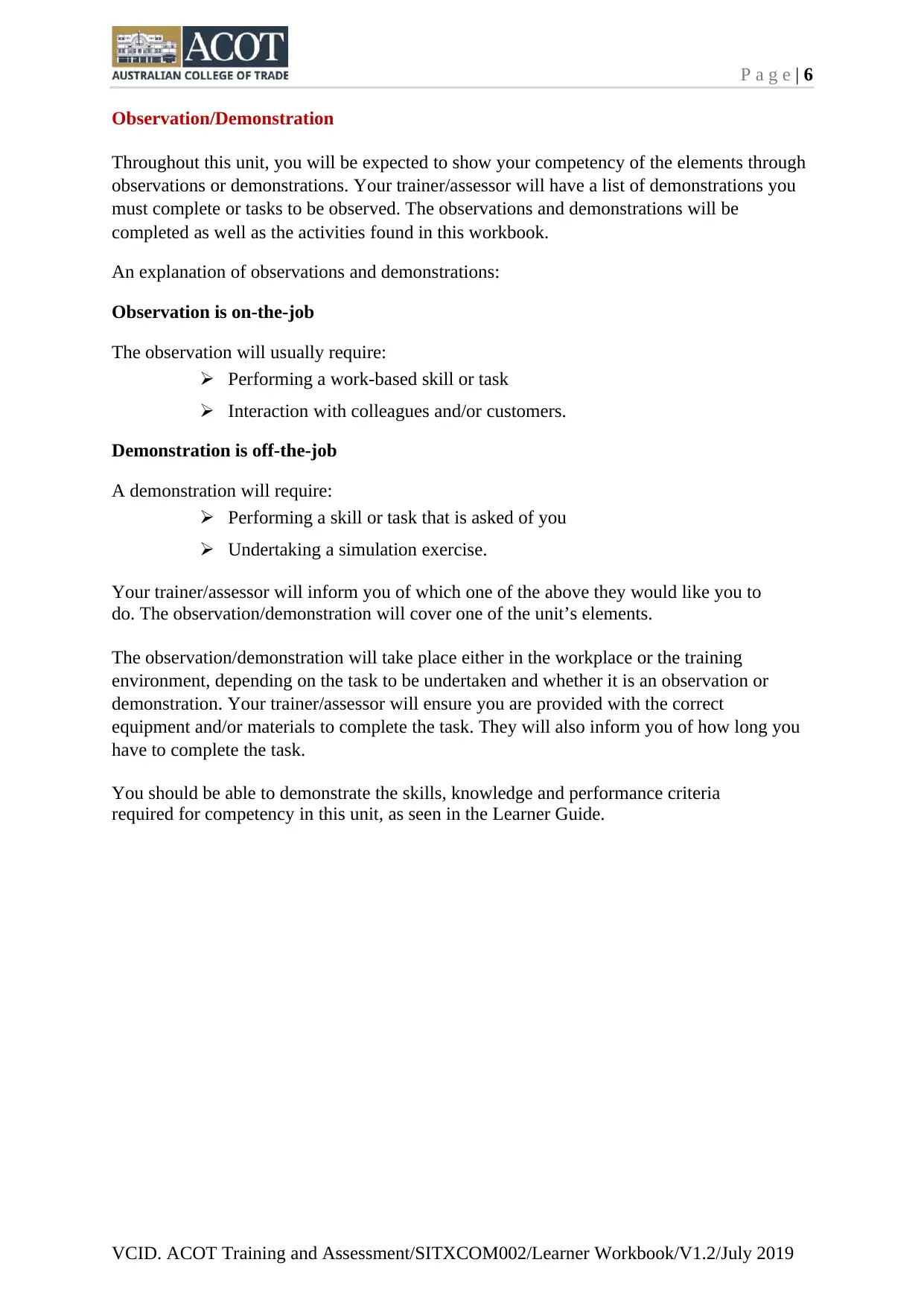
P a g e | 6
Observation/Demonstration
Throughout this unit, you will be expected to show your competency of the elements through
observations or demonstrations. Your trainer/assessor will have a list of demonstrations you
must complete or tasks to be observed. The observations and demonstrations will be
completed as well as the activities found in this workbook.
An explanation of observations and demonstrations:
Observation is on-the-job
The observation will usually require:
➢ Performing a work-based skill or task
➢ Interaction with colleagues and/or customers.
Demonstration is off-the-job
A demonstration will require:
➢ Performing a skill or task that is asked of you
➢ Undertaking a simulation exercise.
Your trainer/assessor will inform you of which one of the above they would like you to
do. The observation/demonstration will cover one of the unit’s elements.
The observation/demonstration will take place either in the workplace or the training
environment, depending on the task to be undertaken and whether it is an observation or
demonstration. Your trainer/assessor will ensure you are provided with the correct
equipment and/or materials to complete the task. They will also inform you of how long you
have to complete the task.
You should be able to demonstrate the skills, knowledge and performance criteria
required for competency in this unit, as seen in the Learner Guide.
VCID. ACOT Training and Assessment/SITXCOM002/Learner Workbook/V1.2/July 2019
Observation/Demonstration
Throughout this unit, you will be expected to show your competency of the elements through
observations or demonstrations. Your trainer/assessor will have a list of demonstrations you
must complete or tasks to be observed. The observations and demonstrations will be
completed as well as the activities found in this workbook.
An explanation of observations and demonstrations:
Observation is on-the-job
The observation will usually require:
➢ Performing a work-based skill or task
➢ Interaction with colleagues and/or customers.
Demonstration is off-the-job
A demonstration will require:
➢ Performing a skill or task that is asked of you
➢ Undertaking a simulation exercise.
Your trainer/assessor will inform you of which one of the above they would like you to
do. The observation/demonstration will cover one of the unit’s elements.
The observation/demonstration will take place either in the workplace or the training
environment, depending on the task to be undertaken and whether it is an observation or
demonstration. Your trainer/assessor will ensure you are provided with the correct
equipment and/or materials to complete the task. They will also inform you of how long you
have to complete the task.
You should be able to demonstrate the skills, knowledge and performance criteria
required for competency in this unit, as seen in the Learner Guide.
VCID. ACOT Training and Assessment/SITXCOM002/Learner Workbook/V1.2/July 2019
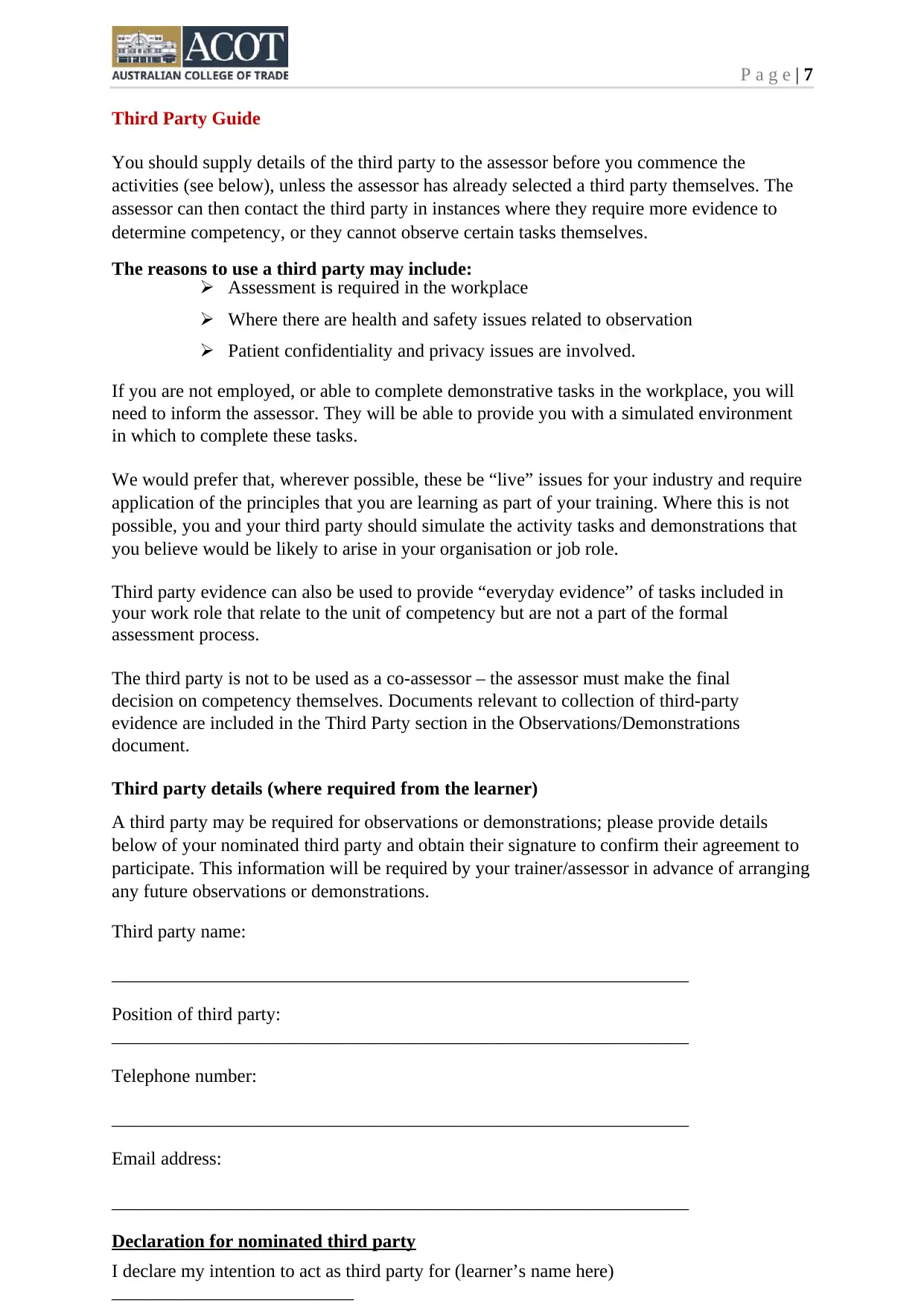
P a g e | 7
Third Party Guide
You should supply details of the third party to the assessor before you commence the
activities (see below), unless the assessor has already selected a third party themselves. The
assessor can then contact the third party in instances where they require more evidence to
determine competency, or they cannot observe certain tasks themselves.
The reasons to use a third party may include:
➢ Assessment is required in the workplace
➢ Where there are health and safety issues related to observation
➢ Patient confidentiality and privacy issues are involved.
If you are not employed, or able to complete demonstrative tasks in the workplace, you will
need to inform the assessor. They will be able to provide you with a simulated environment
in which to complete these tasks.
We would prefer that, wherever possible, these be “live” issues for your industry and require
application of the principles that you are learning as part of your training. Where this is not
possible, you and your third party should simulate the activity tasks and demonstrations that
you believe would be likely to arise in your organisation or job role.
Third party evidence can also be used to provide “everyday evidence” of tasks included in
your work role that relate to the unit of competency but are not a part of the formal
assessment process.
The third party is not to be used as a co-assessor – the assessor must make the final
decision on competency themselves. Documents relevant to collection of third-party
evidence are included in the Third Party section in the Observations/Demonstrations
document.
Third party details (where required from the learner)
A third party may be required for observations or demonstrations; please provide details
below of your nominated third party and obtain their signature to confirm their agreement to
participate. This information will be required by your trainer/assessor in advance of arranging
any future observations or demonstrations.
Third party name:
______________________________________________________________
Position of third party:
______________________________________________________________
Telephone number:
______________________________________________________________
Email address:
______________________________________________________________
Declaration for nominated third party
I declare my intention to act as third party for (learner’s name here)
__________________________
Third Party Guide
You should supply details of the third party to the assessor before you commence the
activities (see below), unless the assessor has already selected a third party themselves. The
assessor can then contact the third party in instances where they require more evidence to
determine competency, or they cannot observe certain tasks themselves.
The reasons to use a third party may include:
➢ Assessment is required in the workplace
➢ Where there are health and safety issues related to observation
➢ Patient confidentiality and privacy issues are involved.
If you are not employed, or able to complete demonstrative tasks in the workplace, you will
need to inform the assessor. They will be able to provide you with a simulated environment
in which to complete these tasks.
We would prefer that, wherever possible, these be “live” issues for your industry and require
application of the principles that you are learning as part of your training. Where this is not
possible, you and your third party should simulate the activity tasks and demonstrations that
you believe would be likely to arise in your organisation or job role.
Third party evidence can also be used to provide “everyday evidence” of tasks included in
your work role that relate to the unit of competency but are not a part of the formal
assessment process.
The third party is not to be used as a co-assessor – the assessor must make the final
decision on competency themselves. Documents relevant to collection of third-party
evidence are included in the Third Party section in the Observations/Demonstrations
document.
Third party details (where required from the learner)
A third party may be required for observations or demonstrations; please provide details
below of your nominated third party and obtain their signature to confirm their agreement to
participate. This information will be required by your trainer/assessor in advance of arranging
any future observations or demonstrations.
Third party name:
______________________________________________________________
Position of third party:
______________________________________________________________
Telephone number:
______________________________________________________________
Email address:
______________________________________________________________
Declaration for nominated third party
I declare my intention to act as third party for (learner’s name here)
__________________________

Third party signature: _____________________________________ Date:
___________________
VCID. ACOT Training and Assessment/SITXCOM002/Learner Workbook/V1.2/July 2019
___________________
VCID. ACOT Training and Assessment/SITXCOM002/Learner Workbook/V1.2/July 2019
Paraphrase This Document
Need a fresh take? Get an instant paraphrase of this document with our AI Paraphraser
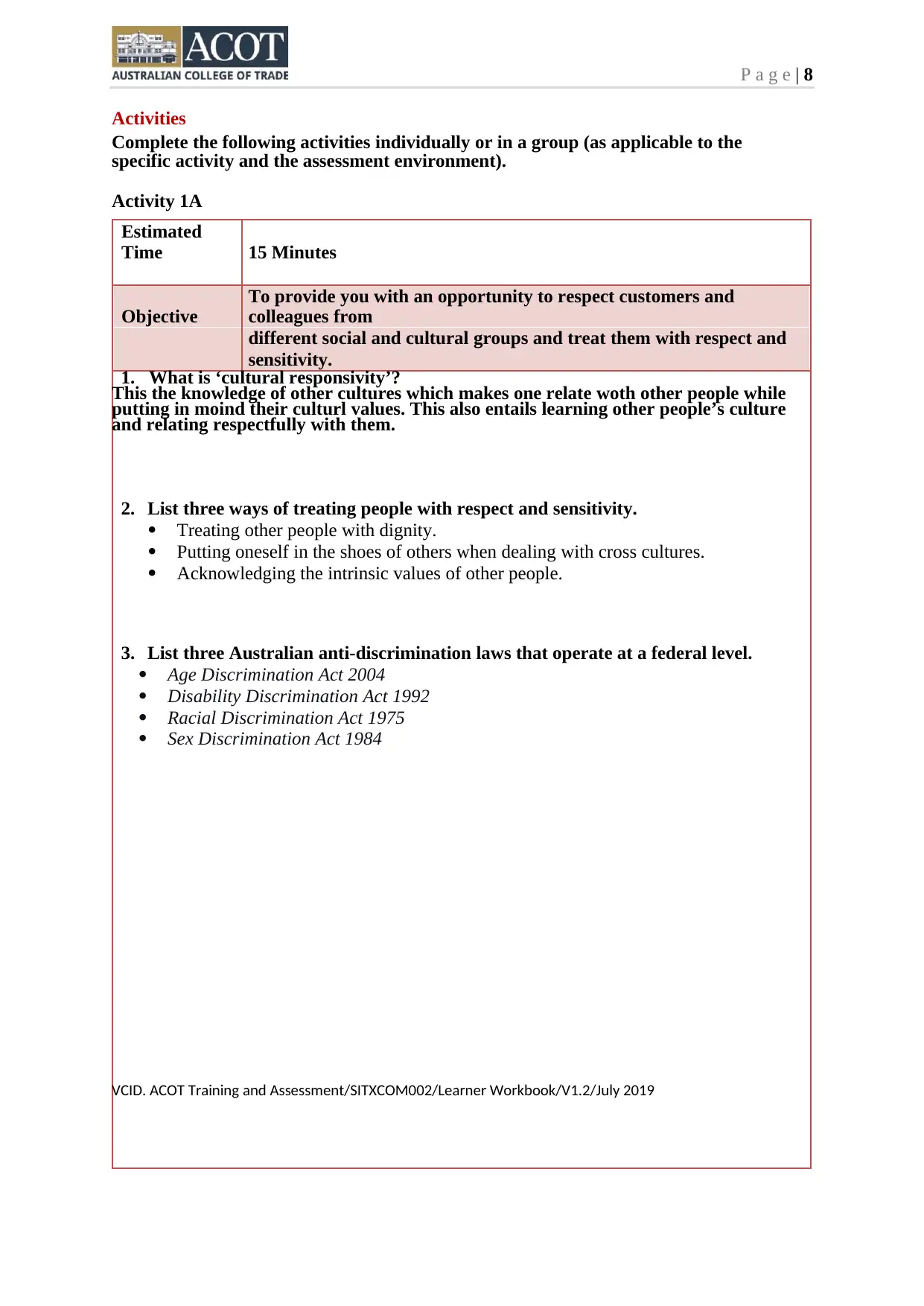
P a g e | 8
Activities
Complete the following activities individually or in a group (as applicable to the
specific activity and the assessment environment).
Activity 1A
Estimated
Time 15 Minutes
Objective
To provide you with an opportunity to respect customers and
colleagues from
different social and cultural groups and treat them with respect and
sensitivity.
1. What is ‘cultural responsivity’?
This the knowledge of other cultures which makes one relate woth other people while
putting in moind their culturl values. This also entails learning other people’s culture
and relating respectfully with them.
2. List three ways of treating people with respect and sensitivity.
Treating other people with dignity.
Putting oneself in the shoes of others when dealing with cross cultures.
Acknowledging the intrinsic values of other people.
3. List three Australian anti-discrimination laws that operate at a federal level.
Age Discrimination Act 2004
Disability Discrimination Act 1992
Racial Discrimination Act 1975
Sex Discrimination Act 1984
VCID. ACOT Training and Assessment/SITXCOM002/Learner Workbook/V1.2/July 2019
Activities
Complete the following activities individually or in a group (as applicable to the
specific activity and the assessment environment).
Activity 1A
Estimated
Time 15 Minutes
Objective
To provide you with an opportunity to respect customers and
colleagues from
different social and cultural groups and treat them with respect and
sensitivity.
1. What is ‘cultural responsivity’?
This the knowledge of other cultures which makes one relate woth other people while
putting in moind their culturl values. This also entails learning other people’s culture
and relating respectfully with them.
2. List three ways of treating people with respect and sensitivity.
Treating other people with dignity.
Putting oneself in the shoes of others when dealing with cross cultures.
Acknowledging the intrinsic values of other people.
3. List three Australian anti-discrimination laws that operate at a federal level.
Age Discrimination Act 2004
Disability Discrimination Act 1992
Racial Discrimination Act 1975
Sex Discrimination Act 1984
VCID. ACOT Training and Assessment/SITXCOM002/Learner Workbook/V1.2/July 2019
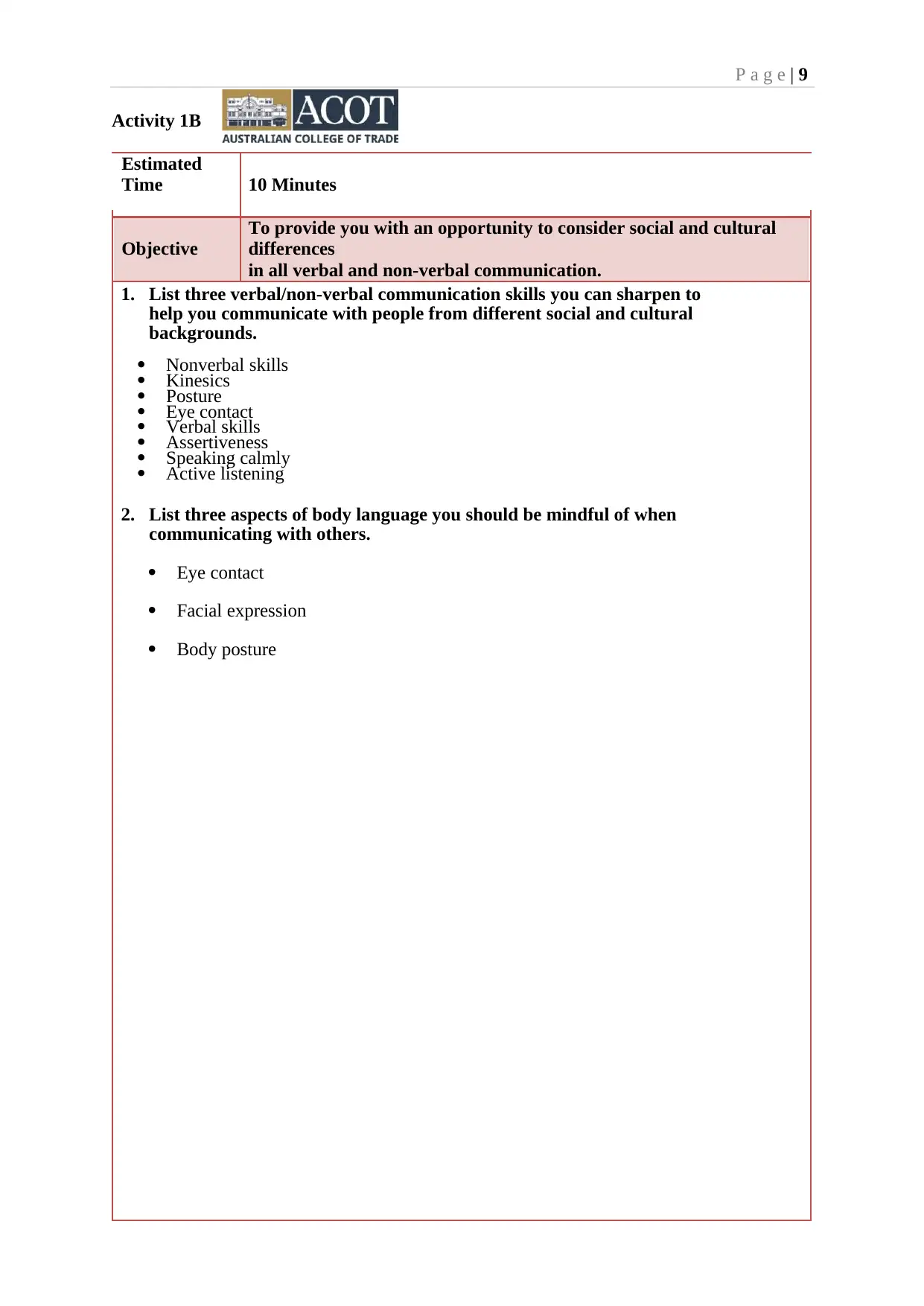
P a g e | 9
Activity 1B
Estimated
Time 10 Minutes
Objective
To provide you with an opportunity to consider social and cultural
differences
in all verbal and non-verbal communication.
1. List three verbal/non-verbal communication skills you can sharpen to
help you communicate with people from different social and cultural
backgrounds.
Nonverbal skills
Kinesics
Posture
Eye contact
Verbal skills
Assertiveness
Speaking calmly
Active listening
2. List three aspects of body language you should be mindful of when
communicating with others.
Eye contact
Facial expression
Body posture
Activity 1B
Estimated
Time 10 Minutes
Objective
To provide you with an opportunity to consider social and cultural
differences
in all verbal and non-verbal communication.
1. List three verbal/non-verbal communication skills you can sharpen to
help you communicate with people from different social and cultural
backgrounds.
Nonverbal skills
Kinesics
Posture
Eye contact
Verbal skills
Assertiveness
Speaking calmly
Active listening
2. List three aspects of body language you should be mindful of when
communicating with others.
Eye contact
Facial expression
Body posture
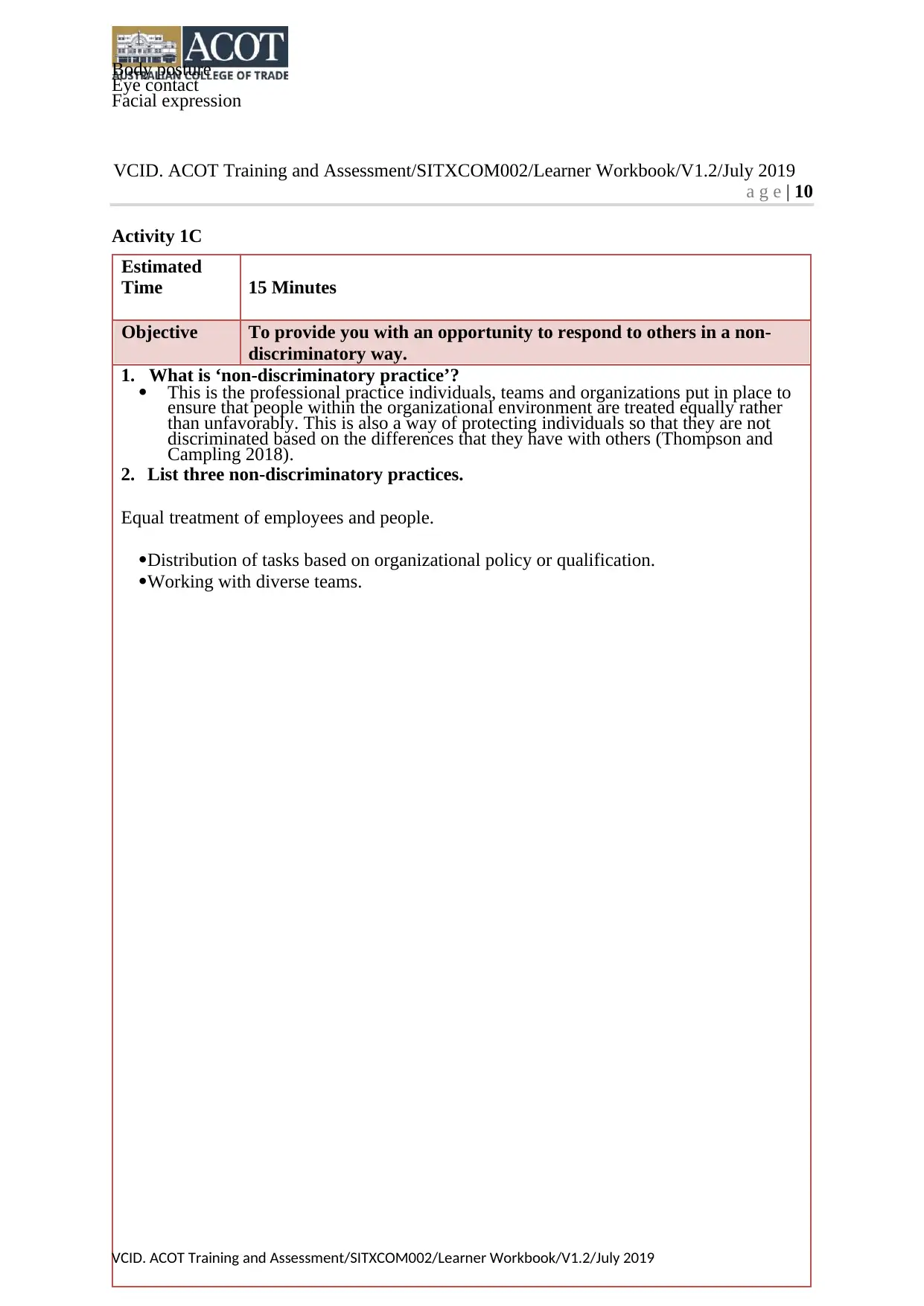
Body posture
Eye contact
Facial expression
VCID. ACOT Training and Assessment/SITXCOM002/Learner Workbook/V1.2/July 2019
a g e | 10
Activity 1C
Estimated
Time 15 Minutes
Objective To provide you with an opportunity to respond to others in a non-
discriminatory way.
1. What is ‘non-discriminatory practice’?
This is the professional practice individuals, teams and organizations put in place to
ensure that people within the organizational environment are treated equally rather
than unfavorably. This is also a way of protecting individuals so that they are not
discriminated based on the differences that they have with others (Thompson and
Campling 2018).
2. List three non-discriminatory practices.
Equal treatment of employees and people.
Distribution of tasks based on organizational policy or qualification.
Working with diverse teams.
VCID. ACOT Training and Assessment/SITXCOM002/Learner Workbook/V1.2/July 2019
Eye contact
Facial expression
VCID. ACOT Training and Assessment/SITXCOM002/Learner Workbook/V1.2/July 2019
a g e | 10
Activity 1C
Estimated
Time 15 Minutes
Objective To provide you with an opportunity to respond to others in a non-
discriminatory way.
1. What is ‘non-discriminatory practice’?
This is the professional practice individuals, teams and organizations put in place to
ensure that people within the organizational environment are treated equally rather
than unfavorably. This is also a way of protecting individuals so that they are not
discriminated based on the differences that they have with others (Thompson and
Campling 2018).
2. List three non-discriminatory practices.
Equal treatment of employees and people.
Distribution of tasks based on organizational policy or qualification.
Working with diverse teams.
VCID. ACOT Training and Assessment/SITXCOM002/Learner Workbook/V1.2/July 2019
Secure Best Marks with AI Grader
Need help grading? Try our AI Grader for instant feedback on your assignments.
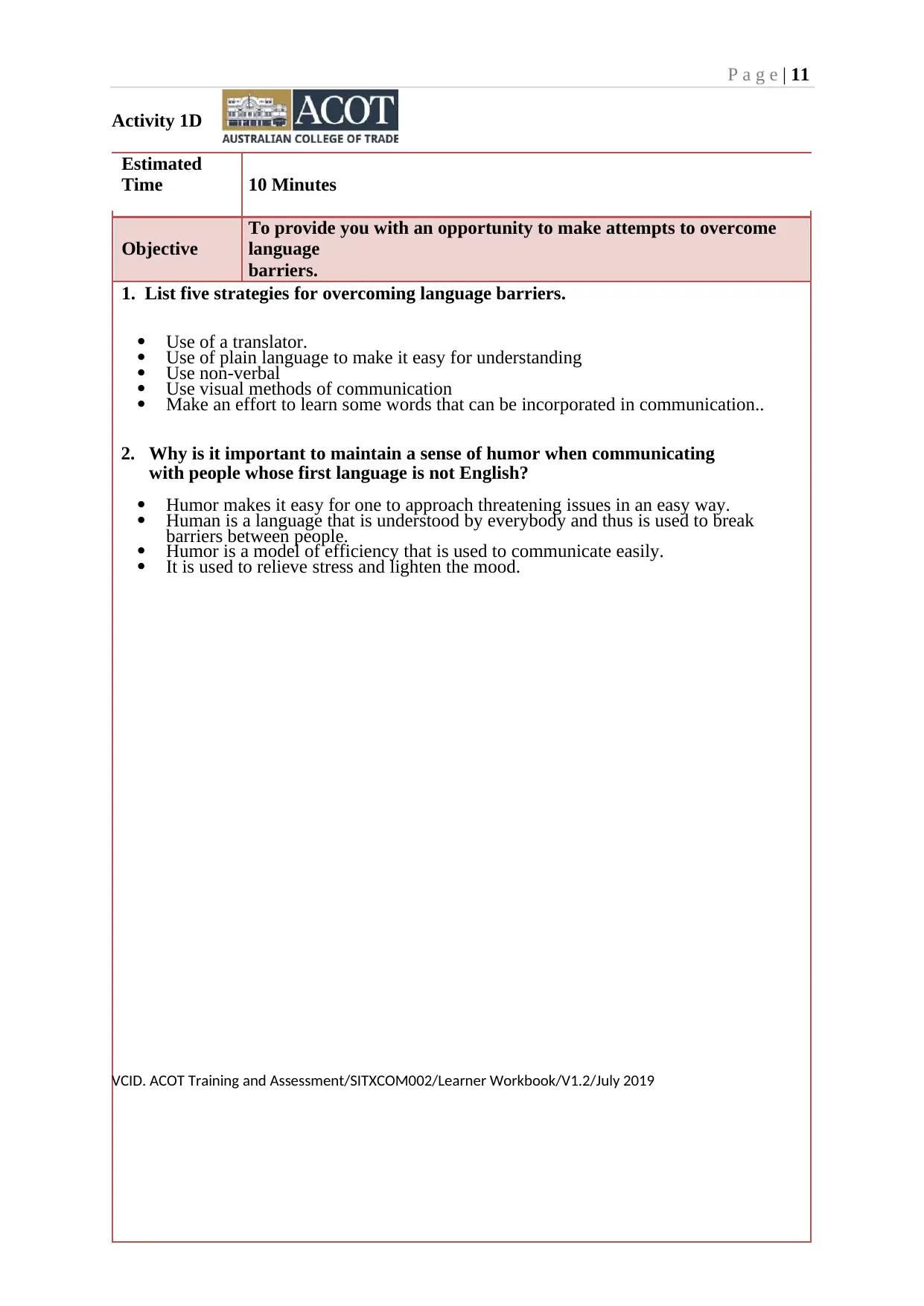
P a g e | 11
Activity 1D
Estimated
Time 10 Minutes
Objective
To provide you with an opportunity to make attempts to overcome
language
barriers.
1. List five strategies for overcoming language barriers.
Use of a translator.
Use of plain language to make it easy for understanding
Use non-verbal
Use visual methods of communication
Make an effort to learn some words that can be incorporated in communication..
2. Why is it important to maintain a sense of humor when communicating
with people whose first language is not English?
Humor makes it easy for one to approach threatening issues in an easy way.
Human is a language that is understood by everybody and thus is used to break
barriers between people.
Humor is a model of efficiency that is used to communicate easily.
It is used to relieve stress and lighten the mood.
VCID. ACOT Training and Assessment/SITXCOM002/Learner Workbook/V1.2/July 2019
Activity 1D
Estimated
Time 10 Minutes
Objective
To provide you with an opportunity to make attempts to overcome
language
barriers.
1. List five strategies for overcoming language barriers.
Use of a translator.
Use of plain language to make it easy for understanding
Use non-verbal
Use visual methods of communication
Make an effort to learn some words that can be incorporated in communication..
2. Why is it important to maintain a sense of humor when communicating
with people whose first language is not English?
Humor makes it easy for one to approach threatening issues in an easy way.
Human is a language that is understood by everybody and thus is used to break
barriers between people.
Humor is a model of efficiency that is used to communicate easily.
It is used to relieve stress and lighten the mood.
VCID. ACOT Training and Assessment/SITXCOM002/Learner Workbook/V1.2/July 2019
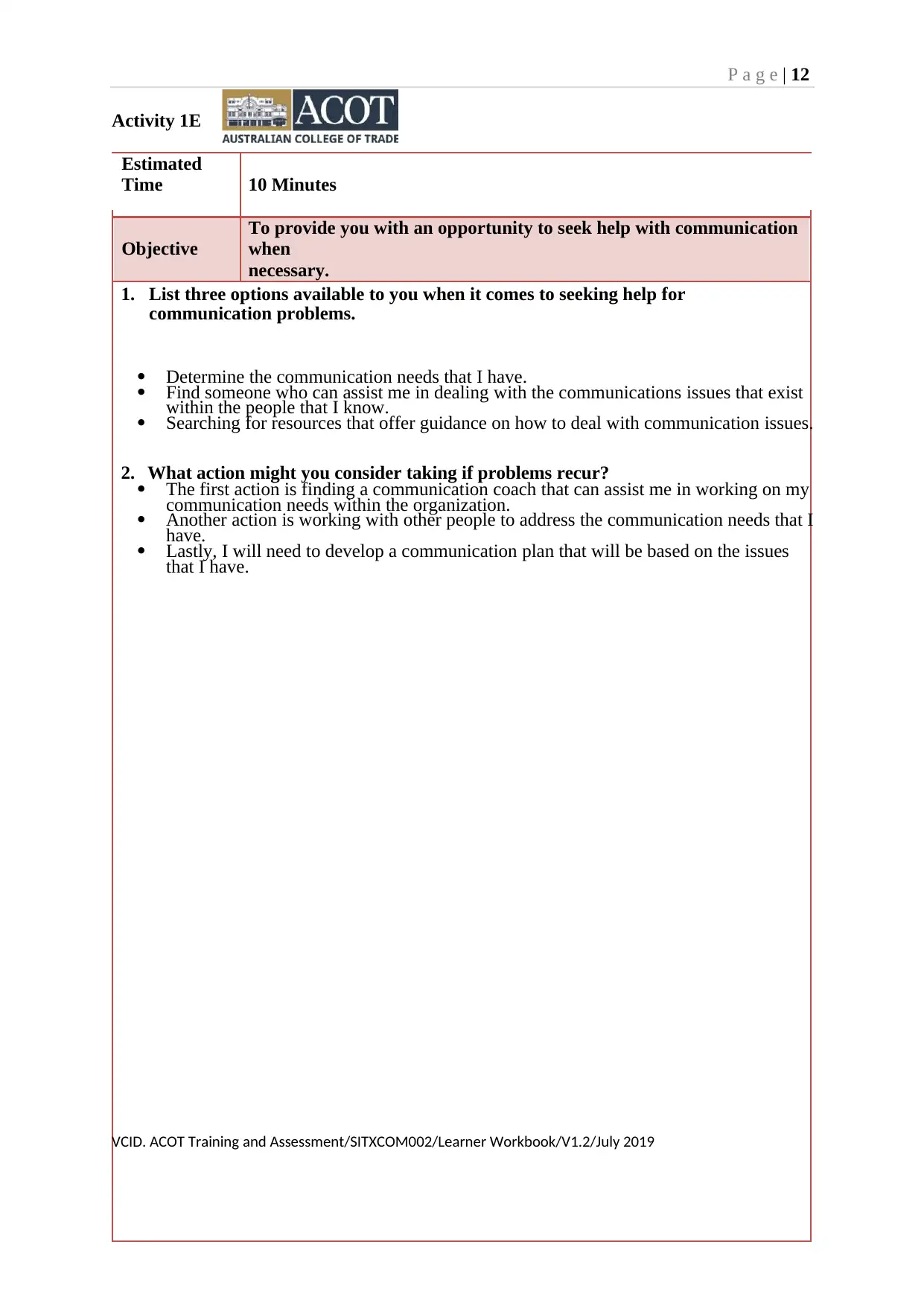
P a g e | 12
Activity 1E
Estimated
Time 10 Minutes
Objective
To provide you with an opportunity to seek help with communication
when
necessary.
1. List three options available to you when it comes to seeking help for
communication problems.
Determine the communication needs that I have.
Find someone who can assist me in dealing with the communications issues that exist
within the people that I know.
Searching for resources that offer guidance on how to deal with communication issues.
2. What action might you consider taking if problems recur?
The first action is finding a communication coach that can assist me in working on my
communication needs within the organization.
Another action is working with other people to address the communication needs that I
have.
Lastly, I will need to develop a communication plan that will be based on the issues
that I have.
VCID. ACOT Training and Assessment/SITXCOM002/Learner Workbook/V1.2/July 2019
Activity 1E
Estimated
Time 10 Minutes
Objective
To provide you with an opportunity to seek help with communication
when
necessary.
1. List three options available to you when it comes to seeking help for
communication problems.
Determine the communication needs that I have.
Find someone who can assist me in dealing with the communications issues that exist
within the people that I know.
Searching for resources that offer guidance on how to deal with communication issues.
2. What action might you consider taking if problems recur?
The first action is finding a communication coach that can assist me in working on my
communication needs within the organization.
Another action is working with other people to address the communication needs that I
have.
Lastly, I will need to develop a communication plan that will be based on the issues
that I have.
VCID. ACOT Training and Assessment/SITXCOM002/Learner Workbook/V1.2/July 2019
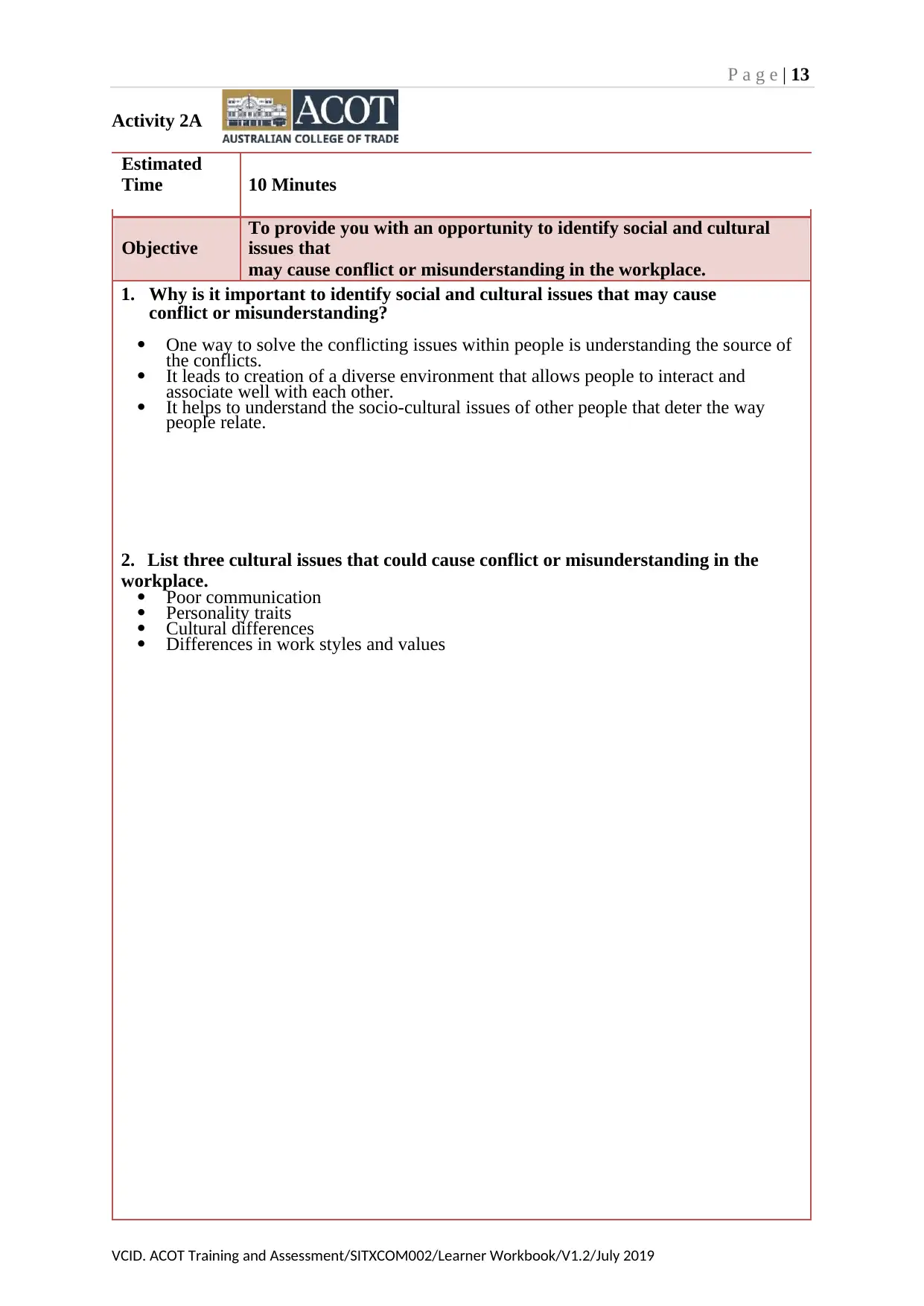
P a g e | 13
Activity 2A
Estimated
Time 10 Minutes
Objective
To provide you with an opportunity to identify social and cultural
issues that
may cause conflict or misunderstanding in the workplace.
1. Why is it important to identify social and cultural issues that may cause
conflict or misunderstanding?
One way to solve the conflicting issues within people is understanding the source of
the conflicts.
It leads to creation of a diverse environment that allows people to interact and
associate well with each other.
It helps to understand the socio-cultural issues of other people that deter the way
people relate.
2. List three cultural issues that could cause conflict or misunderstanding in the
workplace.
Poor communication
Personality traits
Cultural differences
Differences in work styles and values
VCID. ACOT Training and Assessment/SITXCOM002/Learner Workbook/V1.2/July 2019
Activity 2A
Estimated
Time 10 Minutes
Objective
To provide you with an opportunity to identify social and cultural
issues that
may cause conflict or misunderstanding in the workplace.
1. Why is it important to identify social and cultural issues that may cause
conflict or misunderstanding?
One way to solve the conflicting issues within people is understanding the source of
the conflicts.
It leads to creation of a diverse environment that allows people to interact and
associate well with each other.
It helps to understand the socio-cultural issues of other people that deter the way
people relate.
2. List three cultural issues that could cause conflict or misunderstanding in the
workplace.
Poor communication
Personality traits
Cultural differences
Differences in work styles and values
VCID. ACOT Training and Assessment/SITXCOM002/Learner Workbook/V1.2/July 2019
Paraphrase This Document
Need a fresh take? Get an instant paraphrase of this document with our AI Paraphraser
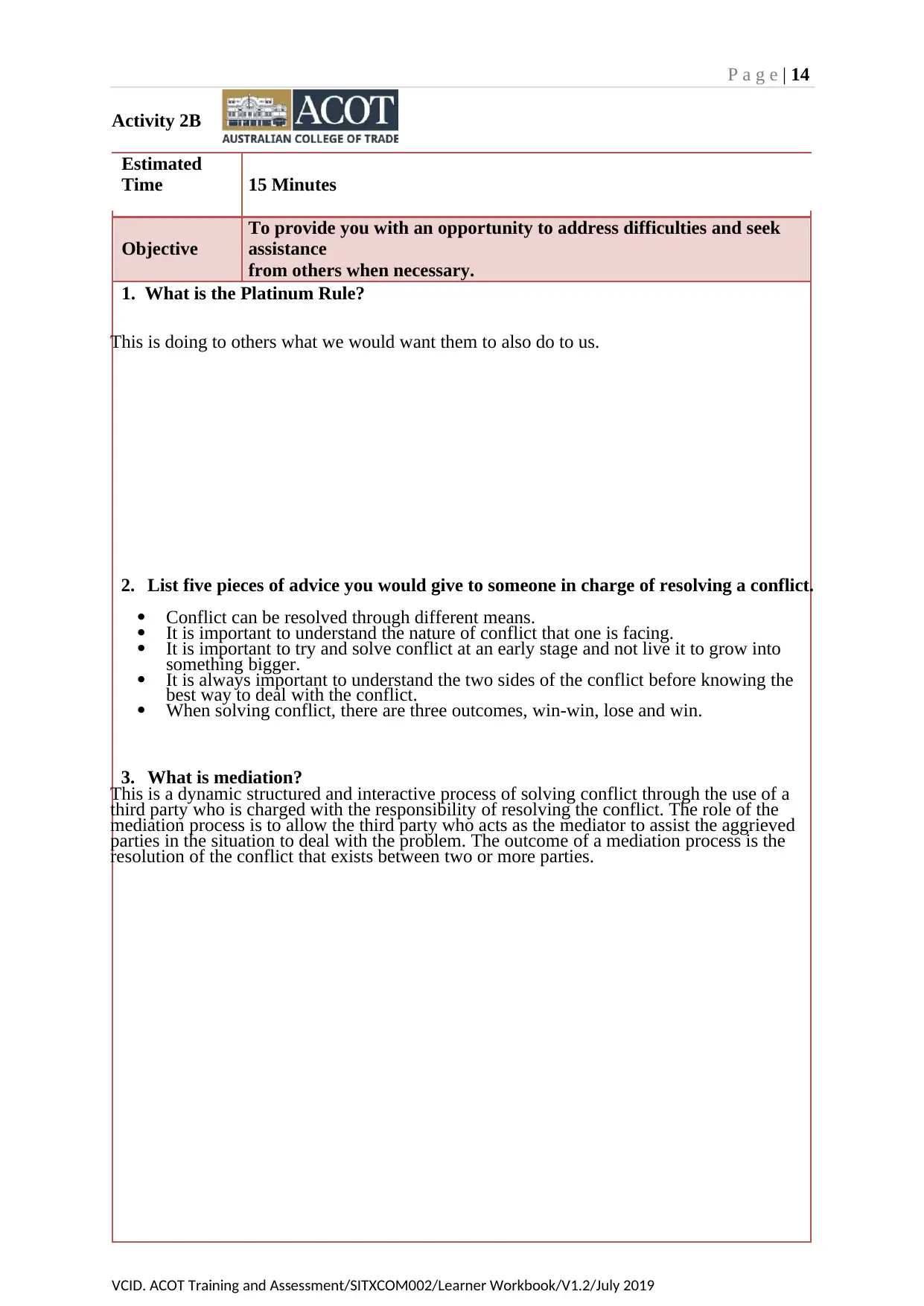
P a g e | 14
Activity 2B
Estimated
Time 15 Minutes
Objective
To provide you with an opportunity to address difficulties and seek
assistance
from others when necessary.
1. What is the Platinum Rule?
This is doing to others what we would want them to also do to us.
2. List five pieces of advice you would give to someone in charge of resolving a conflict.
Conflict can be resolved through different means.
It is important to understand the nature of conflict that one is facing.
It is important to try and solve conflict at an early stage and not live it to grow into
something bigger.
It is always important to understand the two sides of the conflict before knowing the
best way to deal with the conflict.
When solving conflict, there are three outcomes, win-win, lose and win.
3. What is mediation?
This is a dynamic structured and interactive process of solving conflict through the use of a
third party who is charged with the responsibility of resolving the conflict. The role of the
mediation process is to allow the third party who acts as the mediator to assist the aggrieved
parties in the situation to deal with the problem. The outcome of a mediation process is the
resolution of the conflict that exists between two or more parties.
VCID. ACOT Training and Assessment/SITXCOM002/Learner Workbook/V1.2/July 2019
Activity 2B
Estimated
Time 15 Minutes
Objective
To provide you with an opportunity to address difficulties and seek
assistance
from others when necessary.
1. What is the Platinum Rule?
This is doing to others what we would want them to also do to us.
2. List five pieces of advice you would give to someone in charge of resolving a conflict.
Conflict can be resolved through different means.
It is important to understand the nature of conflict that one is facing.
It is important to try and solve conflict at an early stage and not live it to grow into
something bigger.
It is always important to understand the two sides of the conflict before knowing the
best way to deal with the conflict.
When solving conflict, there are three outcomes, win-win, lose and win.
3. What is mediation?
This is a dynamic structured and interactive process of solving conflict through the use of a
third party who is charged with the responsibility of resolving the conflict. The role of the
mediation process is to allow the third party who acts as the mediator to assist the aggrieved
parties in the situation to deal with the problem. The outcome of a mediation process is the
resolution of the conflict that exists between two or more parties.
VCID. ACOT Training and Assessment/SITXCOM002/Learner Workbook/V1.2/July 2019
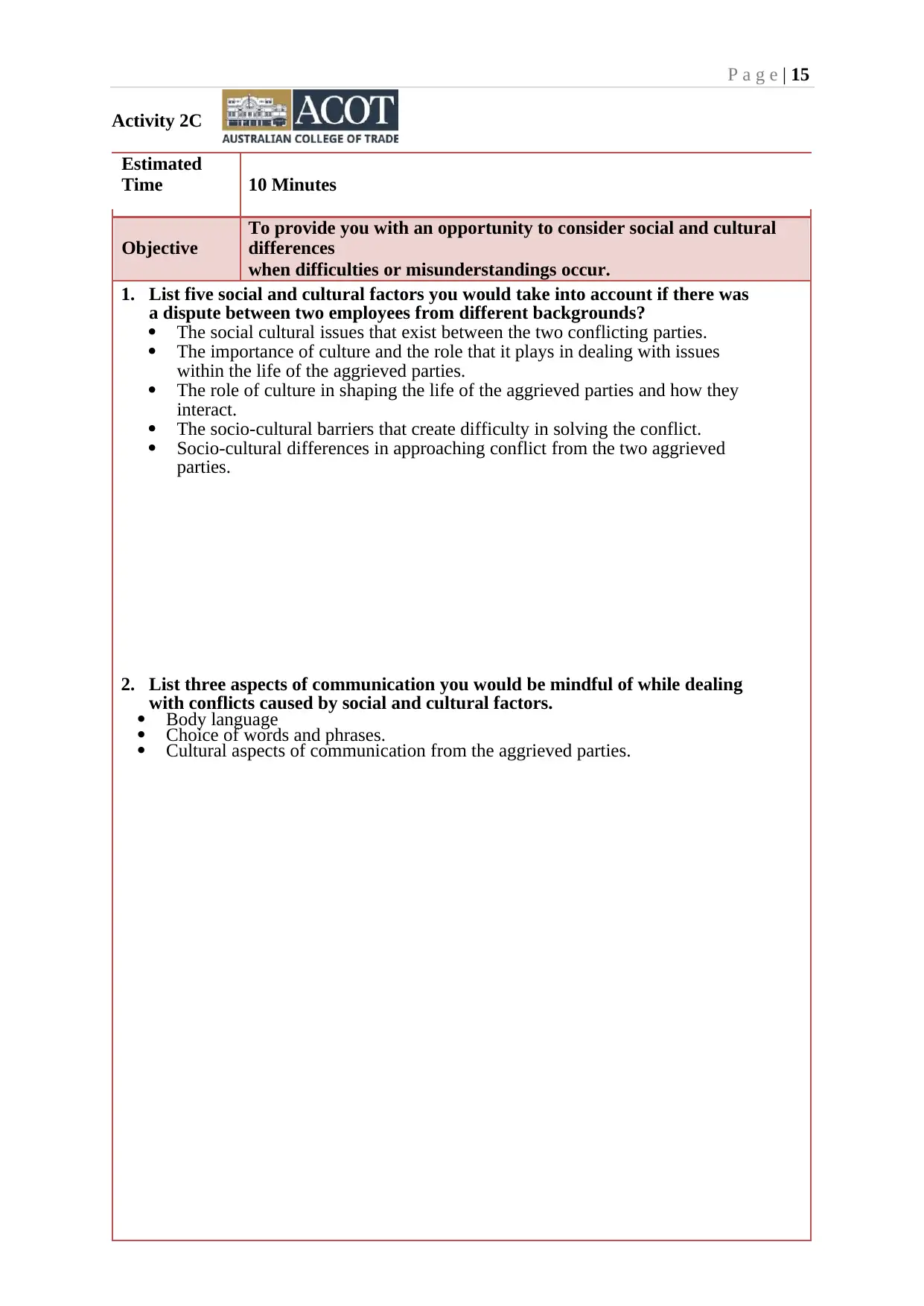
P a g e | 15
Activity 2C
Estimated
Time 10 Minutes
Objective
To provide you with an opportunity to consider social and cultural
differences
when difficulties or misunderstandings occur.
1. List five social and cultural factors you would take into account if there was
a dispute between two employees from different backgrounds?
The social cultural issues that exist between the two conflicting parties.
The importance of culture and the role that it plays in dealing with issues
within the life of the aggrieved parties.
The role of culture in shaping the life of the aggrieved parties and how they
interact.
The socio-cultural barriers that create difficulty in solving the conflict.
Socio-cultural differences in approaching conflict from the two aggrieved
parties.
2. List three aspects of communication you would be mindful of while dealing
with conflicts caused by social and cultural factors.
Body language
Choice of words and phrases.
Cultural aspects of communication from the aggrieved parties.
Activity 2C
Estimated
Time 10 Minutes
Objective
To provide you with an opportunity to consider social and cultural
differences
when difficulties or misunderstandings occur.
1. List five social and cultural factors you would take into account if there was
a dispute between two employees from different backgrounds?
The social cultural issues that exist between the two conflicting parties.
The importance of culture and the role that it plays in dealing with issues
within the life of the aggrieved parties.
The role of culture in shaping the life of the aggrieved parties and how they
interact.
The socio-cultural barriers that create difficulty in solving the conflict.
Socio-cultural differences in approaching conflict from the two aggrieved
parties.
2. List three aspects of communication you would be mindful of while dealing
with conflicts caused by social and cultural factors.
Body language
Choice of words and phrases.
Cultural aspects of communication from the aggrieved parties.

VCID. ACOT Training and Assessment/SITXCOM002/Learner Workbook/V1.2/July 2019
Secure Best Marks with AI Grader
Need help grading? Try our AI Grader for instant feedback on your assignments.
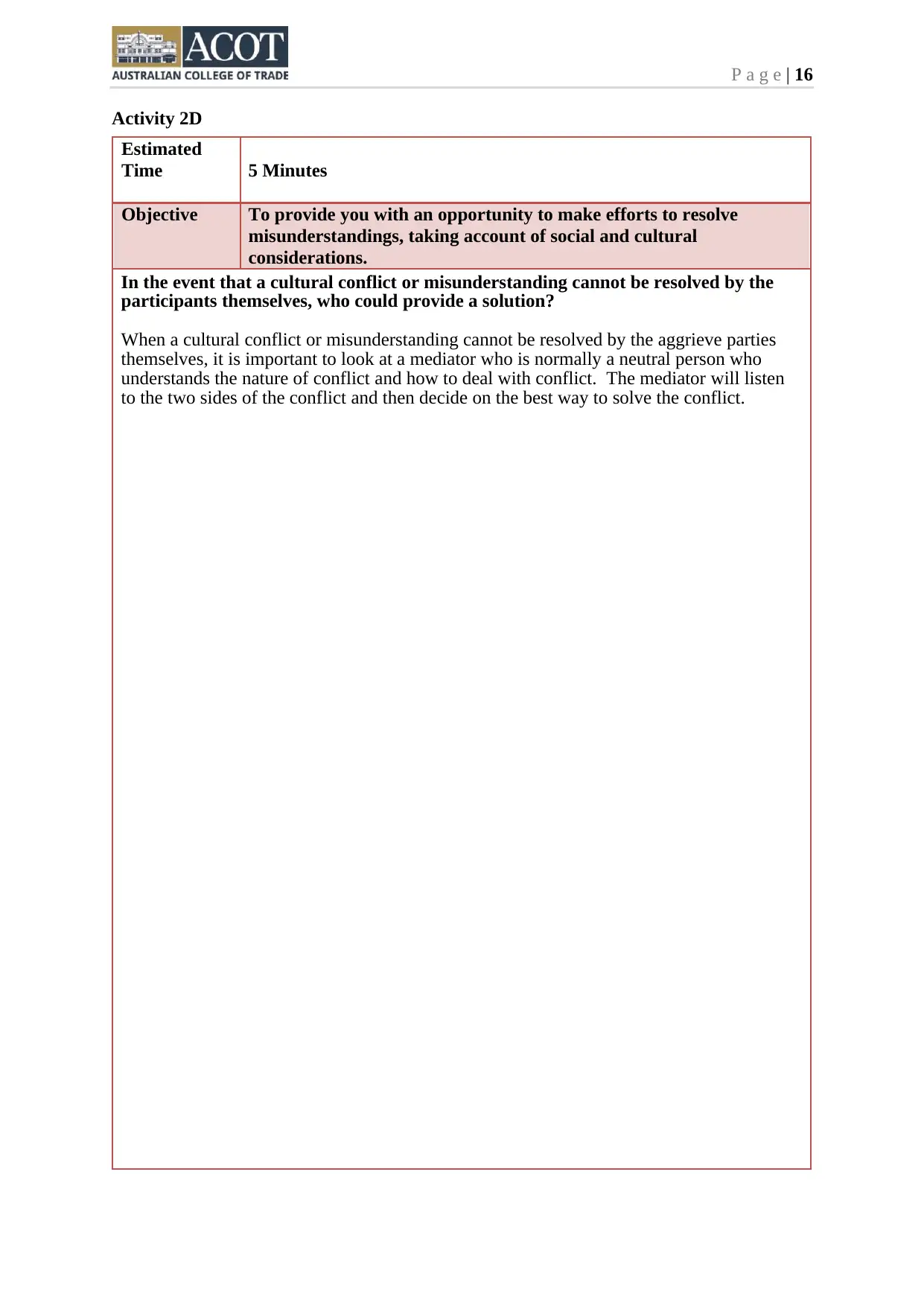
P a g e | 16
Activity 2D
Estimated
Time 5 Minutes
Objective To provide you with an opportunity to make efforts to resolve
misunderstandings, taking account of social and cultural
considerations.
In the event that a cultural conflict or misunderstanding cannot be resolved by the
participants themselves, who could provide a solution?
When a cultural conflict or misunderstanding cannot be resolved by the aggrieve parties
themselves, it is important to look at a mediator who is normally a neutral person who
understands the nature of conflict and how to deal with conflict. The mediator will listen
to the two sides of the conflict and then decide on the best way to solve the conflict.
Activity 2D
Estimated
Time 5 Minutes
Objective To provide you with an opportunity to make efforts to resolve
misunderstandings, taking account of social and cultural
considerations.
In the event that a cultural conflict or misunderstanding cannot be resolved by the
participants themselves, who could provide a solution?
When a cultural conflict or misunderstanding cannot be resolved by the aggrieve parties
themselves, it is important to look at a mediator who is normally a neutral person who
understands the nature of conflict and how to deal with conflict. The mediator will listen
to the two sides of the conflict and then decide on the best way to solve the conflict.

VCID. ACOT Training and Assessment/SITXCOM002/Learner Workbook/V1.2/July 2019
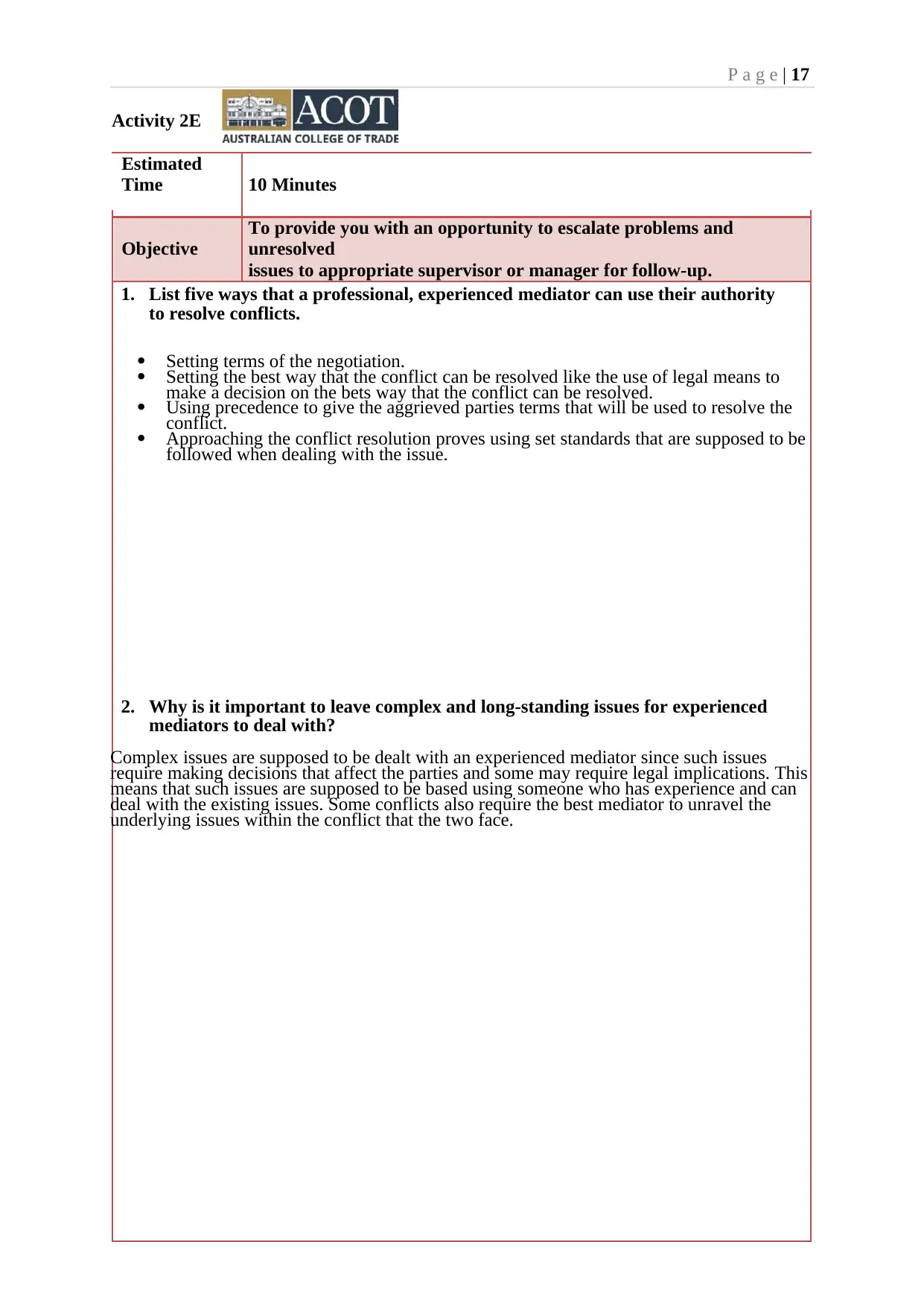
P a g e | 17
Activity 2E
Estimated
Time 10 Minutes
Objective
To provide you with an opportunity to escalate problems and
unresolved
issues to appropriate supervisor or manager for follow-up.
1. List five ways that a professional, experienced mediator can use their authority
to resolve conflicts.
Setting terms of the negotiation.
Setting the best way that the conflict can be resolved like the use of legal means to
make a decision on the bets way that the conflict can be resolved.
Using precedence to give the aggrieved parties terms that will be used to resolve the
conflict.
Approaching the conflict resolution proves using set standards that are supposed to be
followed when dealing with the issue.
2. Why is it important to leave complex and long-standing issues for experienced
mediators to deal with?
Complex issues are supposed to be dealt with an experienced mediator since such issues
require making decisions that affect the parties and some may require legal implications. This
means that such issues are supposed to be based using someone who has experience and can
deal with the existing issues. Some conflicts also require the best mediator to unravel the
underlying issues within the conflict that the two face.
Activity 2E
Estimated
Time 10 Minutes
Objective
To provide you with an opportunity to escalate problems and
unresolved
issues to appropriate supervisor or manager for follow-up.
1. List five ways that a professional, experienced mediator can use their authority
to resolve conflicts.
Setting terms of the negotiation.
Setting the best way that the conflict can be resolved like the use of legal means to
make a decision on the bets way that the conflict can be resolved.
Using precedence to give the aggrieved parties terms that will be used to resolve the
conflict.
Approaching the conflict resolution proves using set standards that are supposed to be
followed when dealing with the issue.
2. Why is it important to leave complex and long-standing issues for experienced
mediators to deal with?
Complex issues are supposed to be dealt with an experienced mediator since such issues
require making decisions that affect the parties and some may require legal implications. This
means that such issues are supposed to be based using someone who has experience and can
deal with the existing issues. Some conflicts also require the best mediator to unravel the
underlying issues within the conflict that the two face.
Paraphrase This Document
Need a fresh take? Get an instant paraphrase of this document with our AI Paraphraser

VCID. ACOT Training and Assessment/SITXCOM002/Learner Workbook/V1.2/July 2019
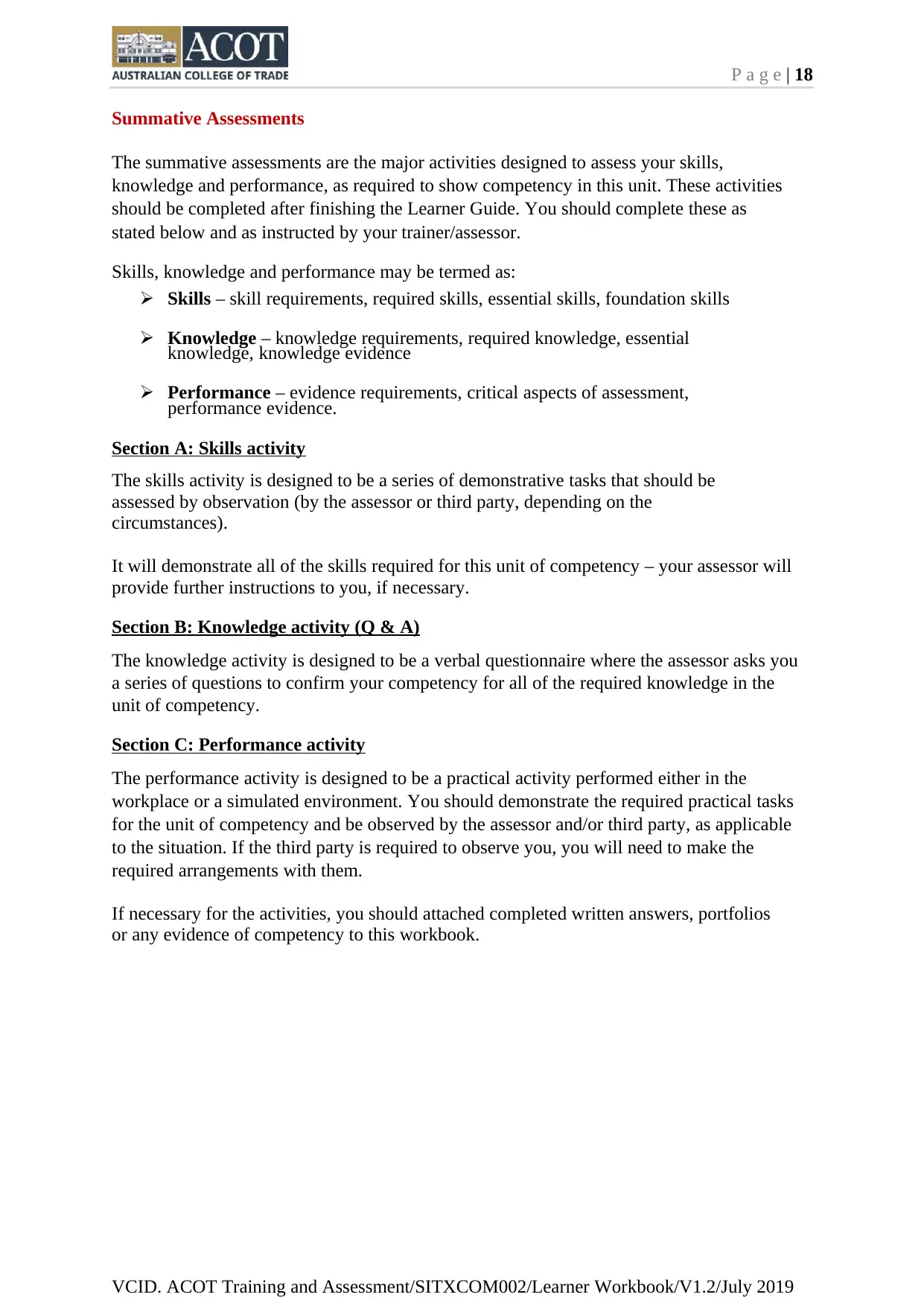
P a g e | 18
Summative Assessments
The summative assessments are the major activities designed to assess your skills,
knowledge and performance, as required to show competency in this unit. These activities
should be completed after finishing the Learner Guide. You should complete these as
stated below and as instructed by your trainer/assessor.
Skills, knowledge and performance may be termed as:
➢ Skills – skill requirements, required skills, essential skills, foundation skills
➢ Knowledge – knowledge requirements, required knowledge, essential
knowledge, knowledge evidence
➢ Performance – evidence requirements, critical aspects of assessment,
performance evidence.
Section A: Skills activity
The skills activity is designed to be a series of demonstrative tasks that should be
assessed by observation (by the assessor or third party, depending on the
circumstances).
It will demonstrate all of the skills required for this unit of competency – your assessor will
provide further instructions to you, if necessary.
Section B: Knowledge activity (Q & A)
The knowledge activity is designed to be a verbal questionnaire where the assessor asks you
a series of questions to confirm your competency for all of the required knowledge in the
unit of competency.
Section C: Performance activity
The performance activity is designed to be a practical activity performed either in the
workplace or a simulated environment. You should demonstrate the required practical tasks
for the unit of competency and be observed by the assessor and/or third party, as applicable
to the situation. If the third party is required to observe you, you will need to make the
required arrangements with them.
If necessary for the activities, you should attached completed written answers, portfolios
or any evidence of competency to this workbook.
VCID. ACOT Training and Assessment/SITXCOM002/Learner Workbook/V1.2/July 2019
Summative Assessments
The summative assessments are the major activities designed to assess your skills,
knowledge and performance, as required to show competency in this unit. These activities
should be completed after finishing the Learner Guide. You should complete these as
stated below and as instructed by your trainer/assessor.
Skills, knowledge and performance may be termed as:
➢ Skills – skill requirements, required skills, essential skills, foundation skills
➢ Knowledge – knowledge requirements, required knowledge, essential
knowledge, knowledge evidence
➢ Performance – evidence requirements, critical aspects of assessment,
performance evidence.
Section A: Skills activity
The skills activity is designed to be a series of demonstrative tasks that should be
assessed by observation (by the assessor or third party, depending on the
circumstances).
It will demonstrate all of the skills required for this unit of competency – your assessor will
provide further instructions to you, if necessary.
Section B: Knowledge activity (Q & A)
The knowledge activity is designed to be a verbal questionnaire where the assessor asks you
a series of questions to confirm your competency for all of the required knowledge in the
unit of competency.
Section C: Performance activity
The performance activity is designed to be a practical activity performed either in the
workplace or a simulated environment. You should demonstrate the required practical tasks
for the unit of competency and be observed by the assessor and/or third party, as applicable
to the situation. If the third party is required to observe you, you will need to make the
required arrangements with them.
If necessary for the activities, you should attached completed written answers, portfolios
or any evidence of competency to this workbook.
VCID. ACOT Training and Assessment/SITXCOM002/Learner Workbook/V1.2/July 2019
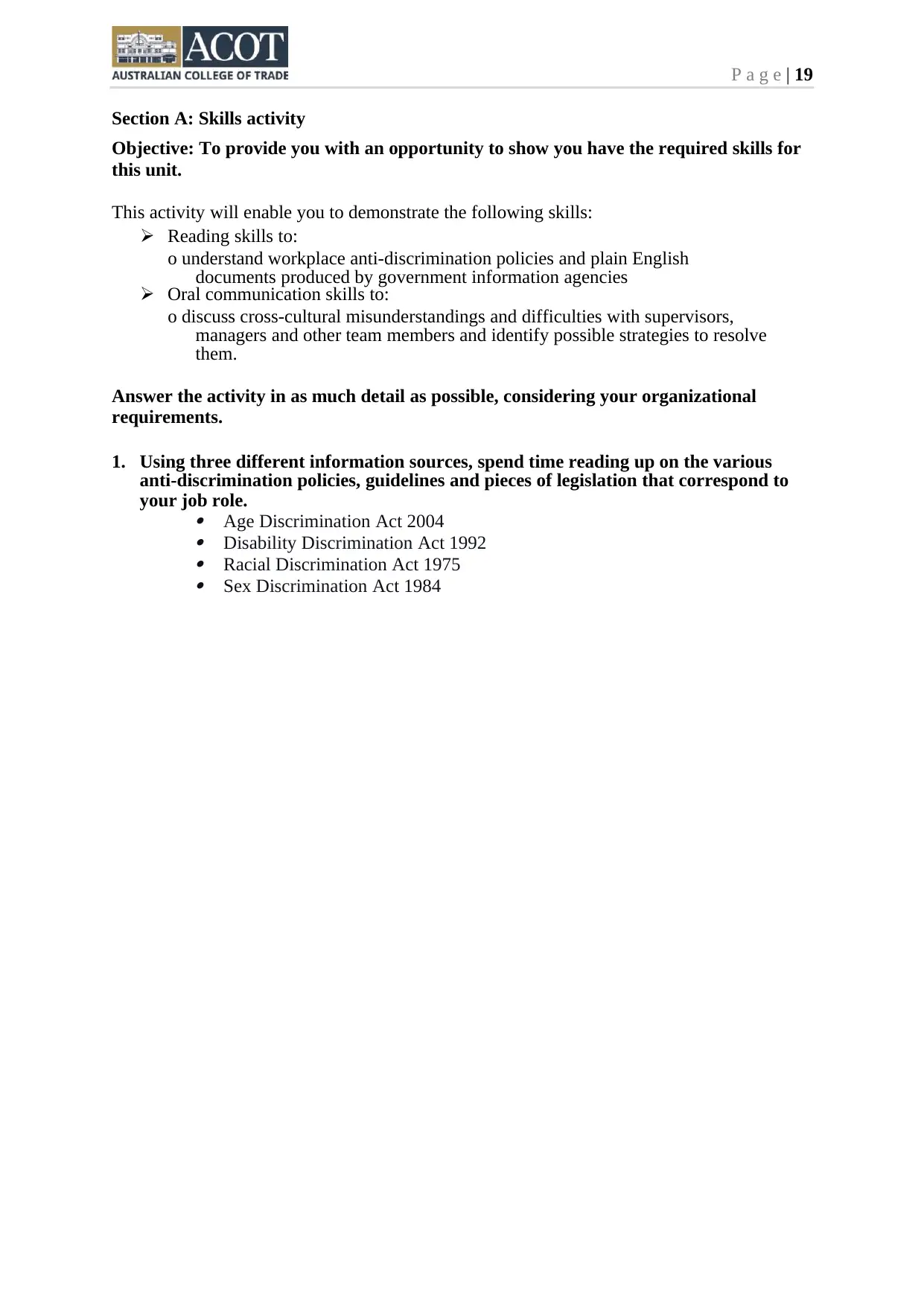
P a g e | 19
Section A: Skills activity
Objective: To provide you with an opportunity to show you have the required skills for
this unit.
This activity will enable you to demonstrate the following skills:
➢ Reading skills to:
o understand workplace anti-discrimination policies and plain English
documents produced by government information agencies
➢ Oral communication skills to:
o discuss cross-cultural misunderstandings and difficulties with supervisors,
managers and other team members and identify possible strategies to resolve
them.
Answer the activity in as much detail as possible, considering your organizational
requirements.
1. Using three different information sources, spend time reading up on the various
anti-discrimination policies, guidelines and pieces of legislation that correspond to
your job role.
Age Discrimination Act 2004
Disability Discrimination Act 1992
Racial Discrimination Act 1975
Sex Discrimination Act 1984
Section A: Skills activity
Objective: To provide you with an opportunity to show you have the required skills for
this unit.
This activity will enable you to demonstrate the following skills:
➢ Reading skills to:
o understand workplace anti-discrimination policies and plain English
documents produced by government information agencies
➢ Oral communication skills to:
o discuss cross-cultural misunderstandings and difficulties with supervisors,
managers and other team members and identify possible strategies to resolve
them.
Answer the activity in as much detail as possible, considering your organizational
requirements.
1. Using three different information sources, spend time reading up on the various
anti-discrimination policies, guidelines and pieces of legislation that correspond to
your job role.
Age Discrimination Act 2004
Disability Discrimination Act 1992
Racial Discrimination Act 1975
Sex Discrimination Act 1984
Secure Best Marks with AI Grader
Need help grading? Try our AI Grader for instant feedback on your assignments.
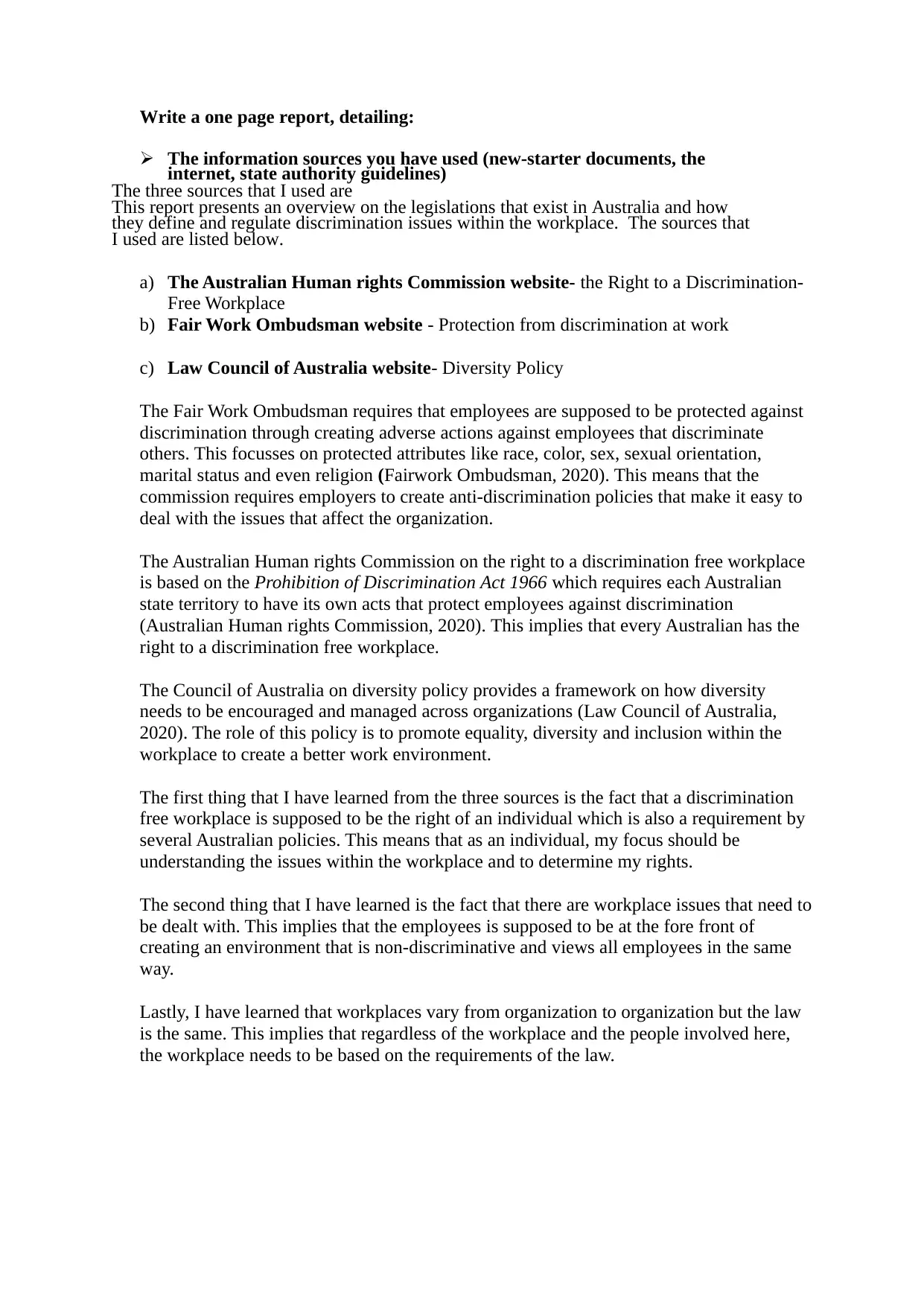
Write a one page report, detailing:
➢ The information sources you have used (new-starter documents, the
internet, state authority guidelines)
The three sources that I used are
This report presents an overview on the legislations that exist in Australia and how
they define and regulate discrimination issues within the workplace. The sources that
I used are listed below.
a) The Australian Human rights Commission website- the Right to a Discrimination-
Free Workplace
b) Fair Work Ombudsman website - Protection from discrimination at work
c) Law Council of Australia website- Diversity Policy
The Fair Work Ombudsman requires that employees are supposed to be protected against
discrimination through creating adverse actions against employees that discriminate
others. This focusses on protected attributes like race, color, sex, sexual orientation,
marital status and even religion (Fairwork Ombudsman, 2020). This means that the
commission requires employers to create anti-discrimination policies that make it easy to
deal with the issues that affect the organization.
The Australian Human rights Commission on the right to a discrimination free workplace
is based on the Prohibition of Discrimination Act 1966 which requires each Australian
state territory to have its own acts that protect employees against discrimination
(Australian Human rights Commission, 2020). This implies that every Australian has the
right to a discrimination free workplace.
The Council of Australia on diversity policy provides a framework on how diversity
needs to be encouraged and managed across organizations (Law Council of Australia,
2020). The role of this policy is to promote equality, diversity and inclusion within the
workplace to create a better work environment.
The first thing that I have learned from the three sources is the fact that a discrimination
free workplace is supposed to be the right of an individual which is also a requirement by
several Australian policies. This means that as an individual, my focus should be
understanding the issues within the workplace and to determine my rights.
The second thing that I have learned is the fact that there are workplace issues that need to
be dealt with. This implies that the employees is supposed to be at the fore front of
creating an environment that is non-discriminative and views all employees in the same
way.
Lastly, I have learned that workplaces vary from organization to organization but the law
is the same. This implies that regardless of the workplace and the people involved here,
the workplace needs to be based on the requirements of the law.
➢ The information sources you have used (new-starter documents, the
internet, state authority guidelines)
The three sources that I used are
This report presents an overview on the legislations that exist in Australia and how
they define and regulate discrimination issues within the workplace. The sources that
I used are listed below.
a) The Australian Human rights Commission website- the Right to a Discrimination-
Free Workplace
b) Fair Work Ombudsman website - Protection from discrimination at work
c) Law Council of Australia website- Diversity Policy
The Fair Work Ombudsman requires that employees are supposed to be protected against
discrimination through creating adverse actions against employees that discriminate
others. This focusses on protected attributes like race, color, sex, sexual orientation,
marital status and even religion (Fairwork Ombudsman, 2020). This means that the
commission requires employers to create anti-discrimination policies that make it easy to
deal with the issues that affect the organization.
The Australian Human rights Commission on the right to a discrimination free workplace
is based on the Prohibition of Discrimination Act 1966 which requires each Australian
state territory to have its own acts that protect employees against discrimination
(Australian Human rights Commission, 2020). This implies that every Australian has the
right to a discrimination free workplace.
The Council of Australia on diversity policy provides a framework on how diversity
needs to be encouraged and managed across organizations (Law Council of Australia,
2020). The role of this policy is to promote equality, diversity and inclusion within the
workplace to create a better work environment.
The first thing that I have learned from the three sources is the fact that a discrimination
free workplace is supposed to be the right of an individual which is also a requirement by
several Australian policies. This means that as an individual, my focus should be
understanding the issues within the workplace and to determine my rights.
The second thing that I have learned is the fact that there are workplace issues that need to
be dealt with. This implies that the employees is supposed to be at the fore front of
creating an environment that is non-discriminative and views all employees in the same
way.
Lastly, I have learned that workplaces vary from organization to organization but the law
is the same. This implies that regardless of the workplace and the people involved here,
the workplace needs to be based on the requirements of the law.
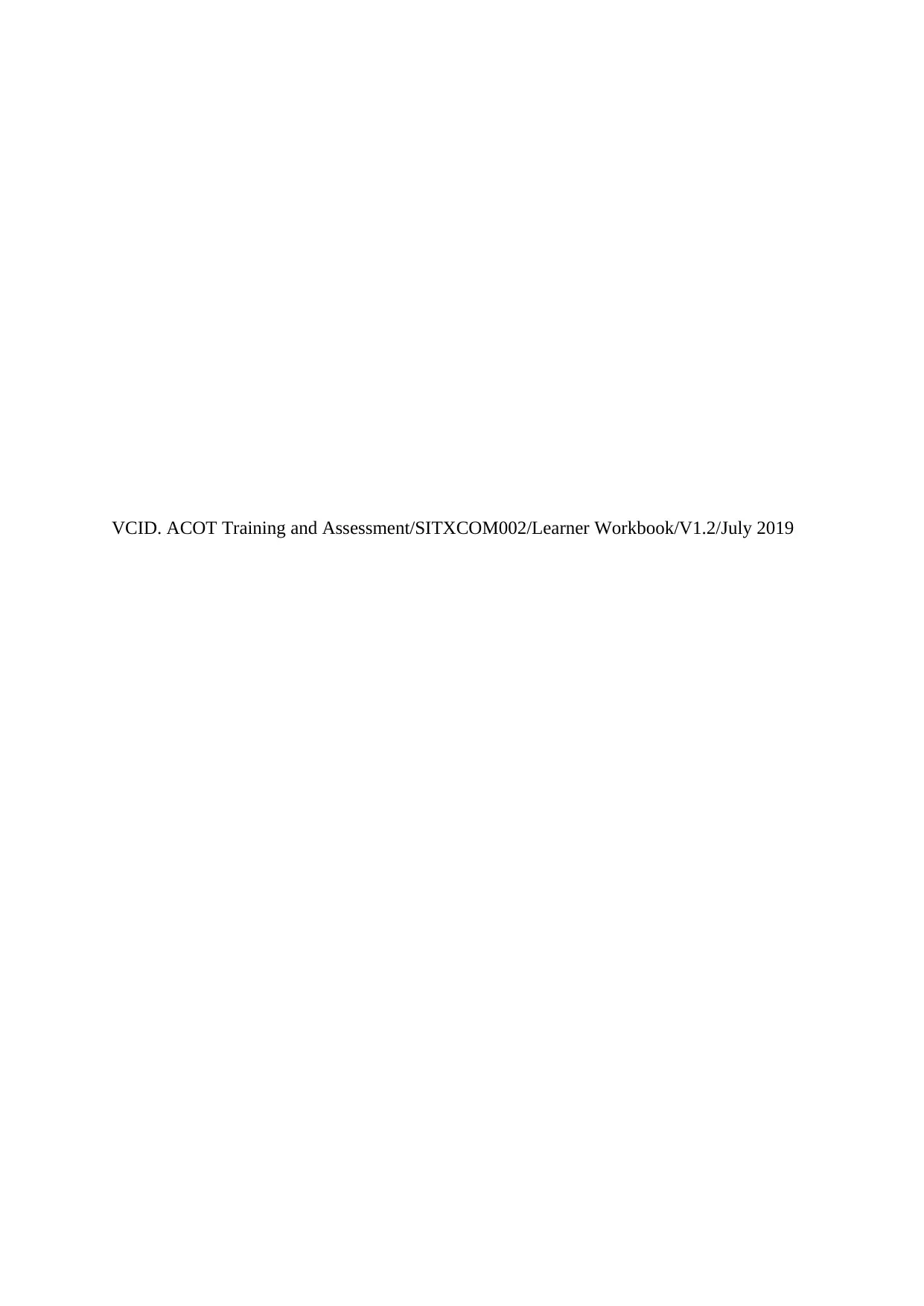
VCID. ACOT Training and Assessment/SITXCOM002/Learner Workbook/V1.2/July 2019
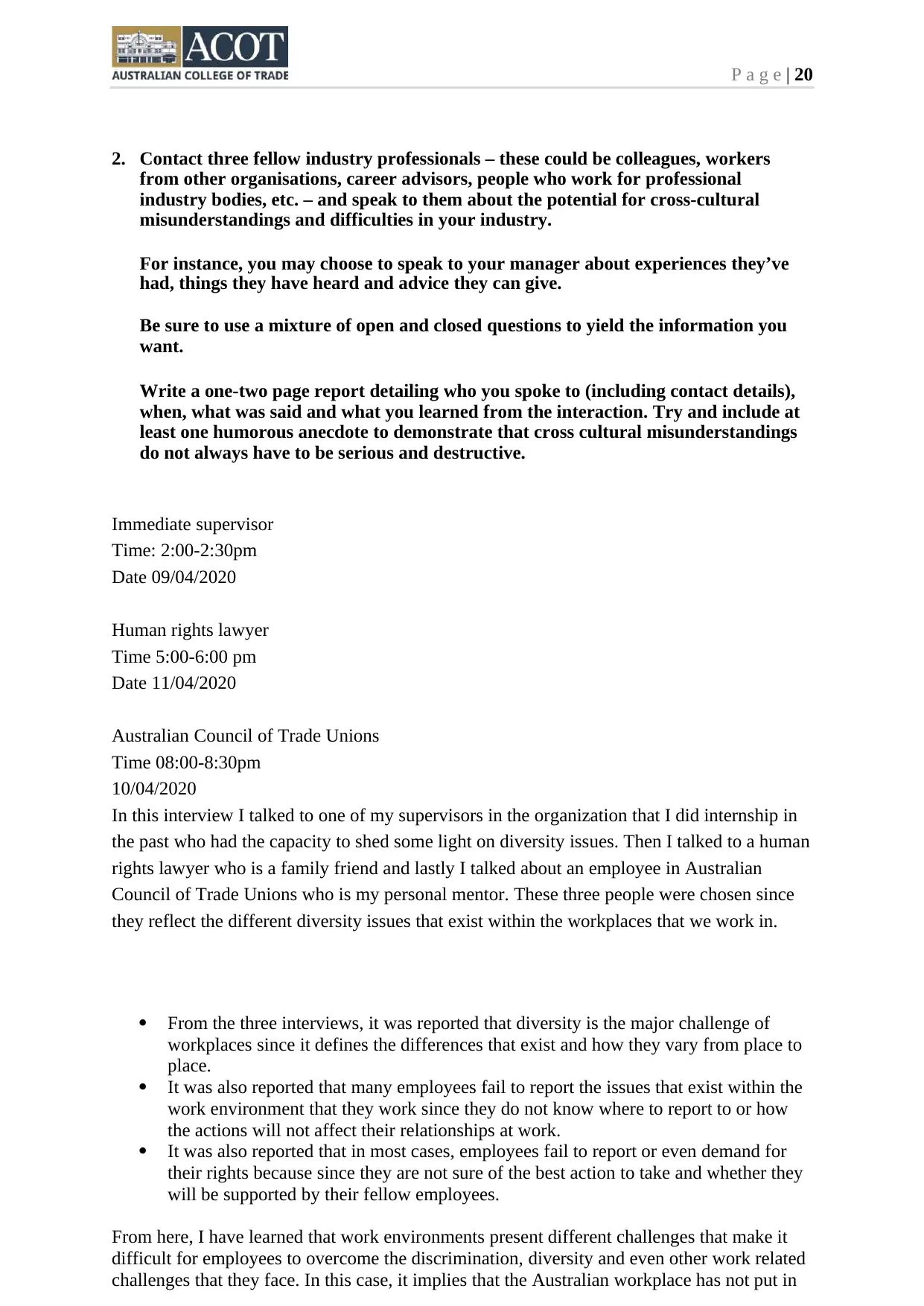
P a g e | 20
2. Contact three fellow industry professionals – these could be colleagues, workers
from other organisations, career advisors, people who work for professional
industry bodies, etc. – and speak to them about the potential for cross-cultural
misunderstandings and difficulties in your industry.
For instance, you may choose to speak to your manager about experiences they’ve
had, things they have heard and advice they can give.
Be sure to use a mixture of open and closed questions to yield the information you
want.
Write a one-two page report detailing who you spoke to (including contact details),
when, what was said and what you learned from the interaction. Try and include at
least one humorous anecdote to demonstrate that cross cultural misunderstandings
do not always have to be serious and destructive.
Immediate supervisor
Time: 2:00-2:30pm
Date 09/04/2020
Human rights lawyer
Time 5:00-6:00 pm
Date 11/04/2020
Australian Council of Trade Unions
Time 08:00-8:30pm
10/04/2020
In this interview I talked to one of my supervisors in the organization that I did internship in
the past who had the capacity to shed some light on diversity issues. Then I talked to a human
rights lawyer who is a family friend and lastly I talked about an employee in Australian
Council of Trade Unions who is my personal mentor. These three people were chosen since
they reflect the different diversity issues that exist within the workplaces that we work in.
From the three interviews, it was reported that diversity is the major challenge of
workplaces since it defines the differences that exist and how they vary from place to
place.
It was also reported that many employees fail to report the issues that exist within the
work environment that they work since they do not know where to report to or how
the actions will not affect their relationships at work.
It was also reported that in most cases, employees fail to report or even demand for
their rights because since they are not sure of the best action to take and whether they
will be supported by their fellow employees.
From here, I have learned that work environments present different challenges that make it
difficult for employees to overcome the discrimination, diversity and even other work related
challenges that they face. In this case, it implies that the Australian workplace has not put in
2. Contact three fellow industry professionals – these could be colleagues, workers
from other organisations, career advisors, people who work for professional
industry bodies, etc. – and speak to them about the potential for cross-cultural
misunderstandings and difficulties in your industry.
For instance, you may choose to speak to your manager about experiences they’ve
had, things they have heard and advice they can give.
Be sure to use a mixture of open and closed questions to yield the information you
want.
Write a one-two page report detailing who you spoke to (including contact details),
when, what was said and what you learned from the interaction. Try and include at
least one humorous anecdote to demonstrate that cross cultural misunderstandings
do not always have to be serious and destructive.
Immediate supervisor
Time: 2:00-2:30pm
Date 09/04/2020
Human rights lawyer
Time 5:00-6:00 pm
Date 11/04/2020
Australian Council of Trade Unions
Time 08:00-8:30pm
10/04/2020
In this interview I talked to one of my supervisors in the organization that I did internship in
the past who had the capacity to shed some light on diversity issues. Then I talked to a human
rights lawyer who is a family friend and lastly I talked about an employee in Australian
Council of Trade Unions who is my personal mentor. These three people were chosen since
they reflect the different diversity issues that exist within the workplaces that we work in.
From the three interviews, it was reported that diversity is the major challenge of
workplaces since it defines the differences that exist and how they vary from place to
place.
It was also reported that many employees fail to report the issues that exist within the
work environment that they work since they do not know where to report to or how
the actions will not affect their relationships at work.
It was also reported that in most cases, employees fail to report or even demand for
their rights because since they are not sure of the best action to take and whether they
will be supported by their fellow employees.
From here, I have learned that work environments present different challenges that make it
difficult for employees to overcome the discrimination, diversity and even other work related
challenges that they face. In this case, it implies that the Australian workplace has not put in
Paraphrase This Document
Need a fresh take? Get an instant paraphrase of this document with our AI Paraphraser

much effort to enlighten employees on the best course of action if when it is there right to
work in an environment that is discrimination free.
Secondly, despite the fact that there are laws that define how people are supposed to relate
with each other, most employees suffer the challenges of discriminatory work places.
Therefore it is important for employees to be assisted to understand their rights and how they
can respond to the issues that affect them.
work in an environment that is discrimination free.
Secondly, despite the fact that there are laws that define how people are supposed to relate
with each other, most employees suffer the challenges of discriminatory work places.
Therefore it is important for employees to be assisted to understand their rights and how they
can respond to the issues that affect them.
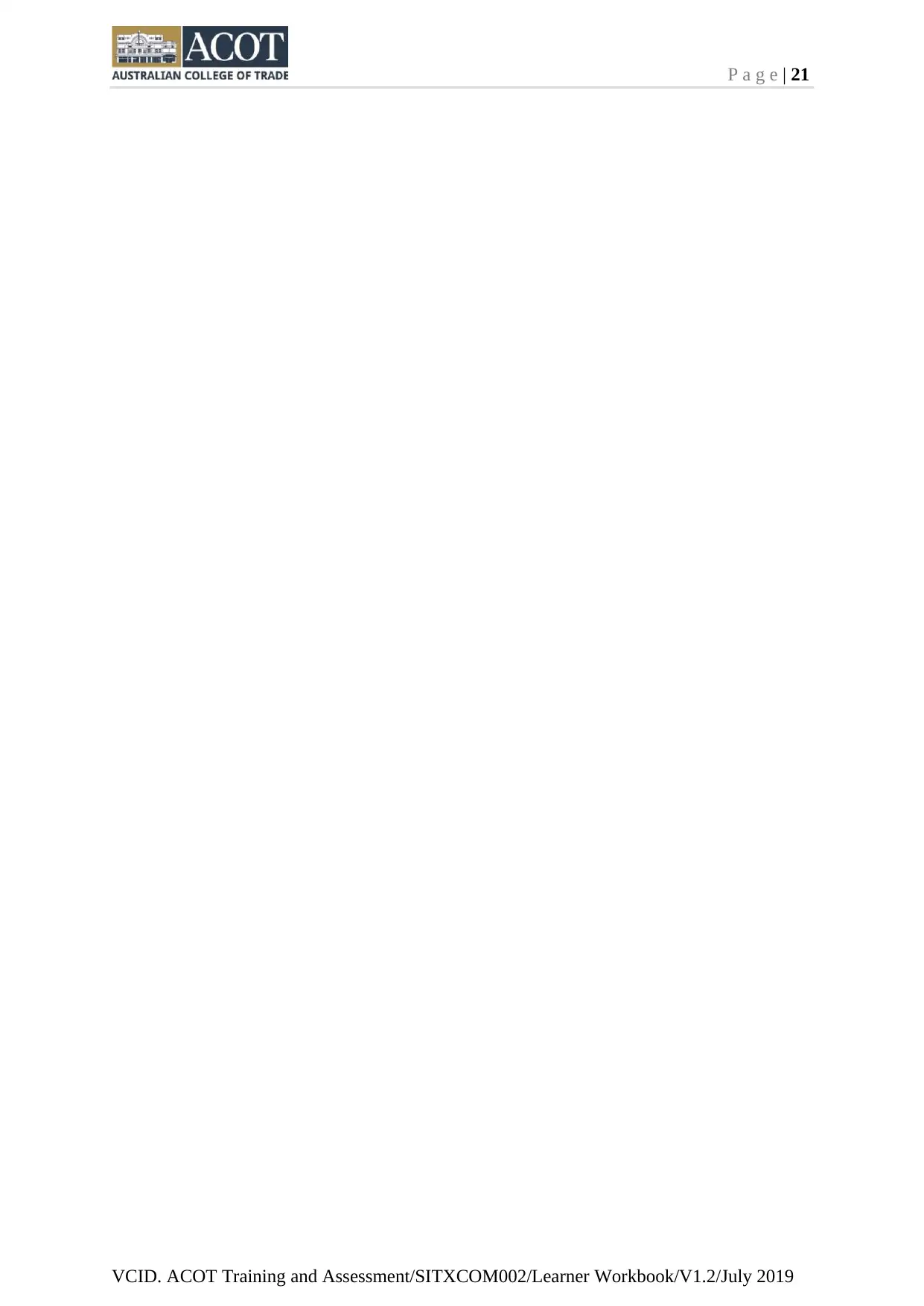
P a g e | 21
VCID. ACOT Training and Assessment/SITXCOM002/Learner Workbook/V1.2/July 2019
VCID. ACOT Training and Assessment/SITXCOM002/Learner Workbook/V1.2/July 2019
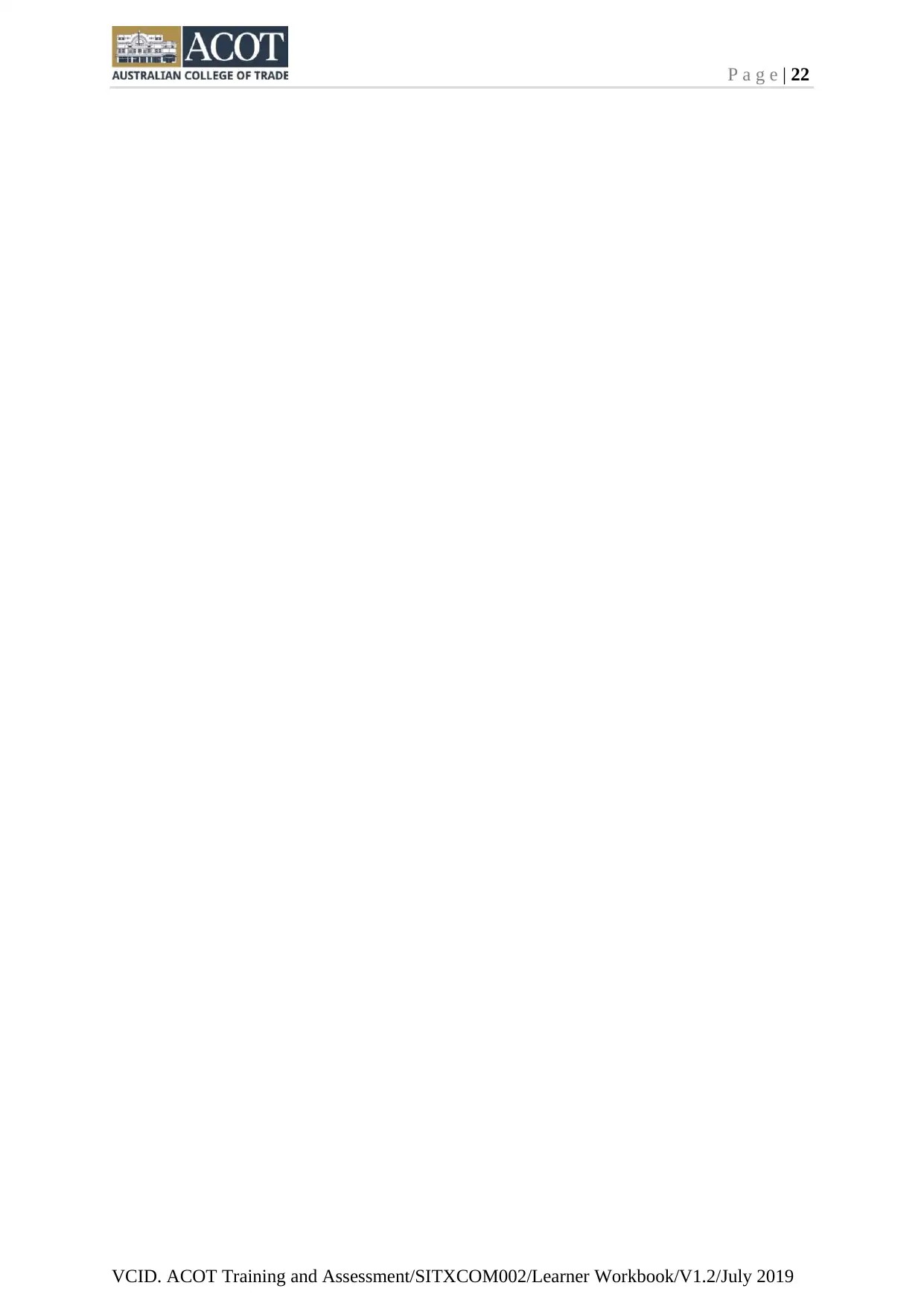
P a g e | 22
VCID. ACOT Training and Assessment/SITXCOM002/Learner Workbook/V1.2/July 2019
VCID. ACOT Training and Assessment/SITXCOM002/Learner Workbook/V1.2/July 2019
Secure Best Marks with AI Grader
Need help grading? Try our AI Grader for instant feedback on your assignments.
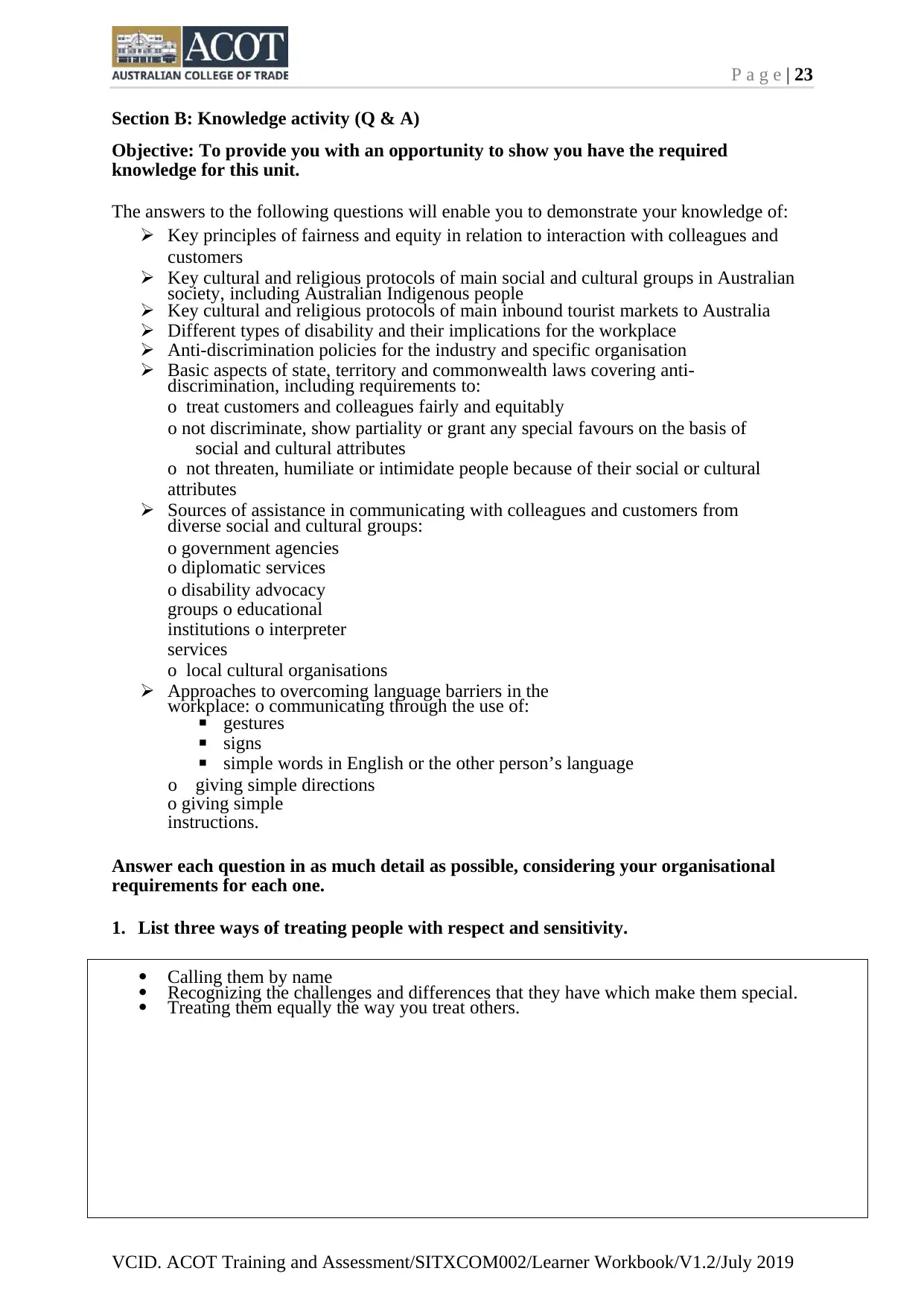
P a g e | 23
Section B: Knowledge activity (Q & A)
Objective: To provide you with an opportunity to show you have the required
knowledge for this unit.
The answers to the following questions will enable you to demonstrate your knowledge of:
➢ Key principles of fairness and equity in relation to interaction with colleagues and
customers
➢ Key cultural and religious protocols of main social and cultural groups in Australian
society, including Australian Indigenous people
➢ Key cultural and religious protocols of main inbound tourist markets to Australia
➢ Different types of disability and their implications for the workplace
➢ Anti-discrimination policies for the industry and specific organisation
➢ Basic aspects of state, territory and commonwealth laws covering anti-
discrimination, including requirements to:
o treat customers and colleagues fairly and equitably
o not discriminate, show partiality or grant any special favours on the basis of
social and cultural attributes
o not threaten, humiliate or intimidate people because of their social or cultural
attributes
➢ Sources of assistance in communicating with colleagues and customers from
diverse social and cultural groups:
o government agencies
o diplomatic services
o disability advocacy
groups o educational
institutions o interpreter
services
o local cultural organisations
➢ Approaches to overcoming language barriers in the
workplace: o communicating through the use of:
▪ gestures
▪ signs
▪ simple words in English or the other person’s language
o giving simple directions
o giving simple
instructions.
Answer each question in as much detail as possible, considering your organisational
requirements for each one.
1. List three ways of treating people with respect and sensitivity.
Calling them by name
Recognizing the challenges and differences that they have which make them special.
Treating them equally the way you treat others.
VCID. ACOT Training and Assessment/SITXCOM002/Learner Workbook/V1.2/July 2019
Section B: Knowledge activity (Q & A)
Objective: To provide you with an opportunity to show you have the required
knowledge for this unit.
The answers to the following questions will enable you to demonstrate your knowledge of:
➢ Key principles of fairness and equity in relation to interaction with colleagues and
customers
➢ Key cultural and religious protocols of main social and cultural groups in Australian
society, including Australian Indigenous people
➢ Key cultural and religious protocols of main inbound tourist markets to Australia
➢ Different types of disability and their implications for the workplace
➢ Anti-discrimination policies for the industry and specific organisation
➢ Basic aspects of state, territory and commonwealth laws covering anti-
discrimination, including requirements to:
o treat customers and colleagues fairly and equitably
o not discriminate, show partiality or grant any special favours on the basis of
social and cultural attributes
o not threaten, humiliate or intimidate people because of their social or cultural
attributes
➢ Sources of assistance in communicating with colleagues and customers from
diverse social and cultural groups:
o government agencies
o diplomatic services
o disability advocacy
groups o educational
institutions o interpreter
services
o local cultural organisations
➢ Approaches to overcoming language barriers in the
workplace: o communicating through the use of:
▪ gestures
▪ signs
▪ simple words in English or the other person’s language
o giving simple directions
o giving simple
instructions.
Answer each question in as much detail as possible, considering your organisational
requirements for each one.
1. List three ways of treating people with respect and sensitivity.
Calling them by name
Recognizing the challenges and differences that they have which make them special.
Treating them equally the way you treat others.
VCID. ACOT Training and Assessment/SITXCOM002/Learner Workbook/V1.2/July 2019
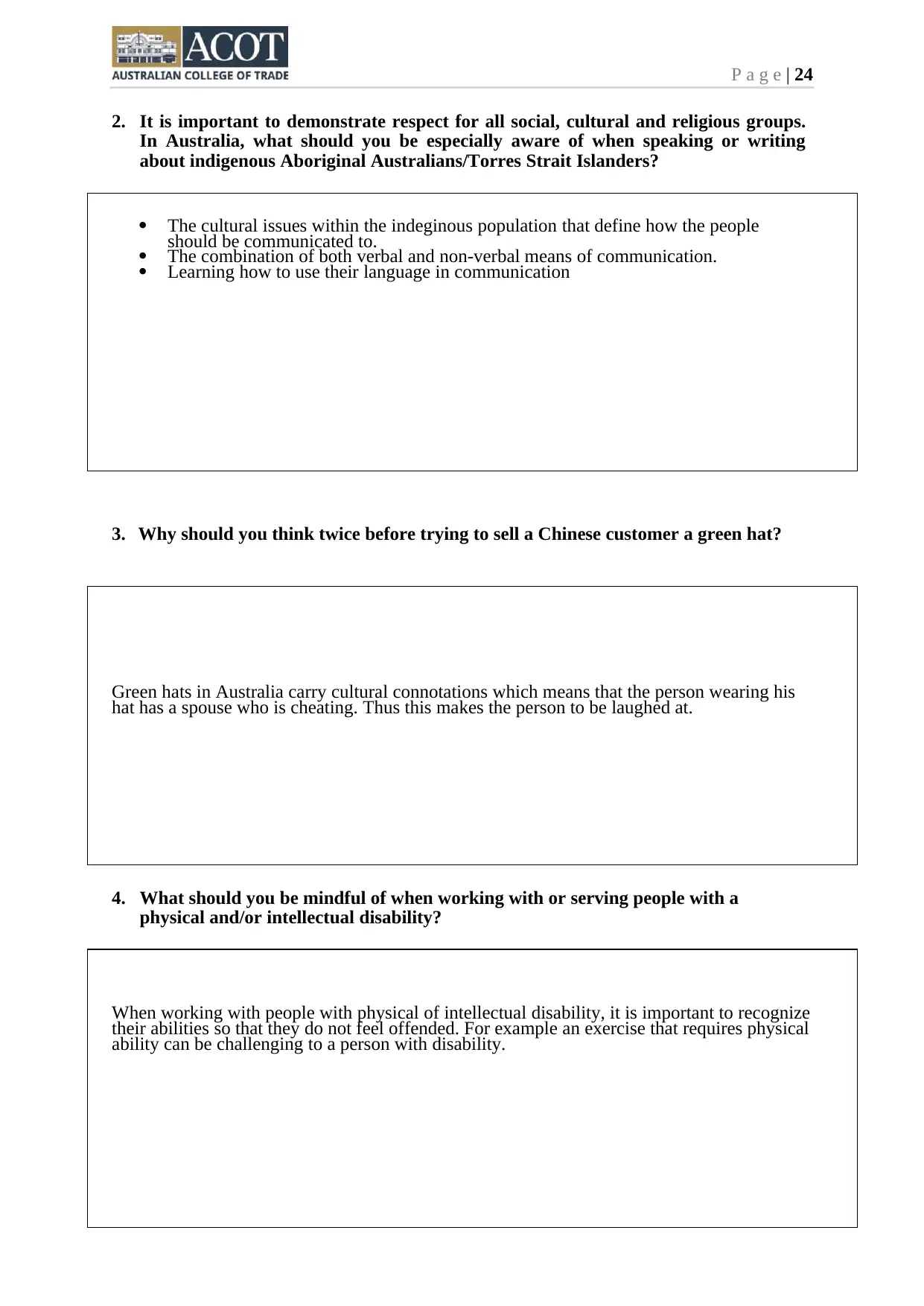
P a g e | 24
2. It is important to demonstrate respect for all social, cultural and religious groups.
In Australia, what should you be especially aware of when speaking or writing
about indigenous Aboriginal Australians/Torres Strait Islanders?
The cultural issues within the indeginous population that define how the people
should be communicated to.
The combination of both verbal and non-verbal means of communication.
Learning how to use their language in communication
3. Why should you think twice before trying to sell a Chinese customer a green hat?
Green hats in Australia carry cultural connotations which means that the person wearing his
hat has a spouse who is cheating. Thus this makes the person to be laughed at.
4. What should you be mindful of when working with or serving people with a
physical and/or intellectual disability?
When working with people with physical of intellectual disability, it is important to recognize
their abilities so that they do not feel offended. For example an exercise that requires physical
ability can be challenging to a person with disability.
2. It is important to demonstrate respect for all social, cultural and religious groups.
In Australia, what should you be especially aware of when speaking or writing
about indigenous Aboriginal Australians/Torres Strait Islanders?
The cultural issues within the indeginous population that define how the people
should be communicated to.
The combination of both verbal and non-verbal means of communication.
Learning how to use their language in communication
3. Why should you think twice before trying to sell a Chinese customer a green hat?
Green hats in Australia carry cultural connotations which means that the person wearing his
hat has a spouse who is cheating. Thus this makes the person to be laughed at.
4. What should you be mindful of when working with or serving people with a
physical and/or intellectual disability?
When working with people with physical of intellectual disability, it is important to recognize
their abilities so that they do not feel offended. For example an exercise that requires physical
ability can be challenging to a person with disability.

VCID. ACOT Training and Assessment/SITXCOM002/Learner Workbook/V1.2/July 2019
Paraphrase This Document
Need a fresh take? Get an instant paraphrase of this document with our AI Paraphraser
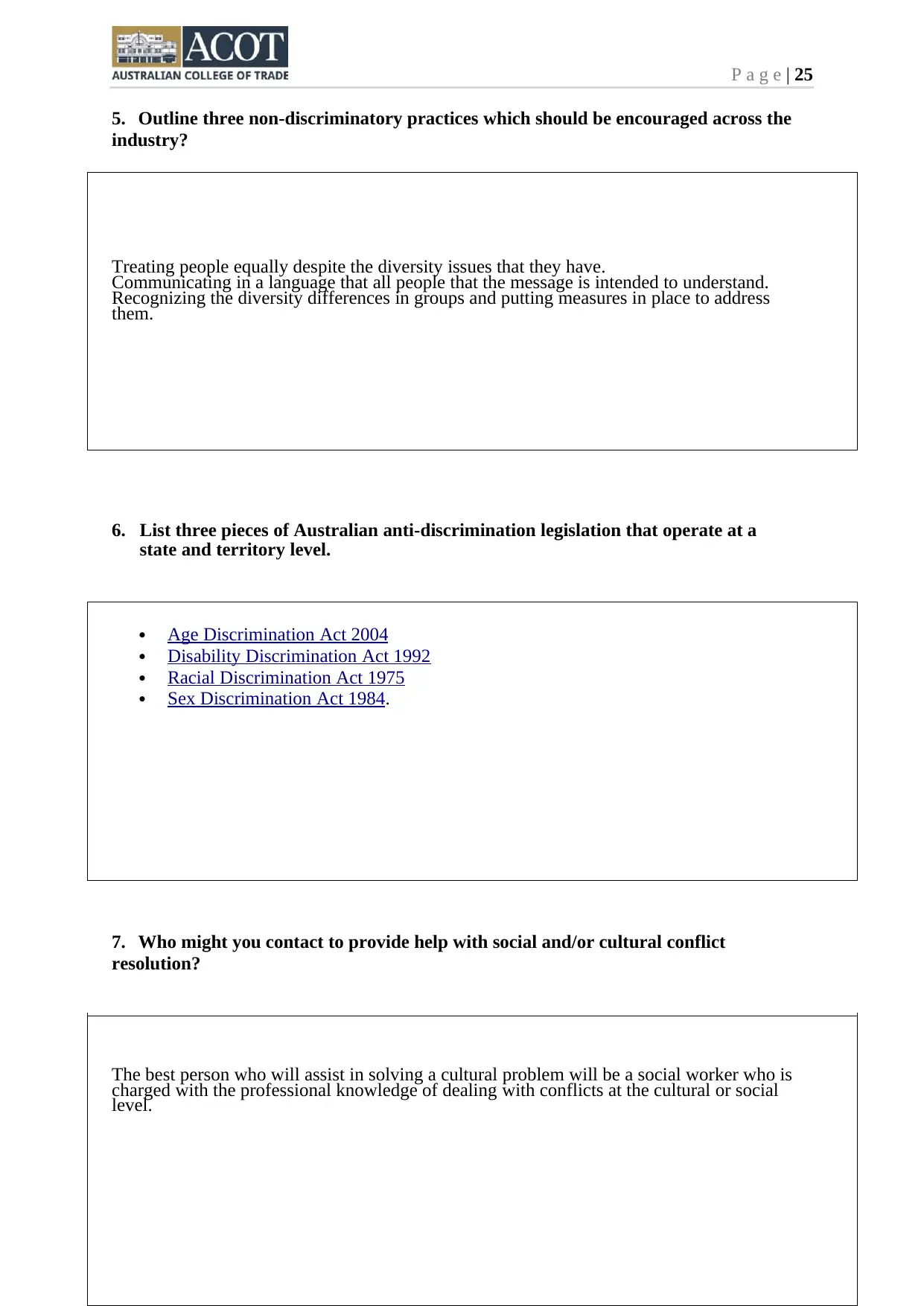
P a g e | 25
5. Outline three non-discriminatory practices which should be encouraged across the
industry?
Treating people equally despite the diversity issues that they have.
Communicating in a language that all people that the message is intended to understand.
Recognizing the diversity differences in groups and putting measures in place to address
them.
6. List three pieces of Australian anti-discrimination legislation that operate at a
state and territory level.
Age Discrimination Act 2004
Disability Discrimination Act 1992
Racial Discrimination Act 1975
Sex Discrimination Act 1984.
7. Who might you contact to provide help with social and/or cultural conflict
resolution?
The best person who will assist in solving a cultural problem will be a social worker who is
charged with the professional knowledge of dealing with conflicts at the cultural or social
level.
5. Outline three non-discriminatory practices which should be encouraged across the
industry?
Treating people equally despite the diversity issues that they have.
Communicating in a language that all people that the message is intended to understand.
Recognizing the diversity differences in groups and putting measures in place to address
them.
6. List three pieces of Australian anti-discrimination legislation that operate at a
state and territory level.
Age Discrimination Act 2004
Disability Discrimination Act 1992
Racial Discrimination Act 1975
Sex Discrimination Act 1984.
7. Who might you contact to provide help with social and/or cultural conflict
resolution?
The best person who will assist in solving a cultural problem will be a social worker who is
charged with the professional knowledge of dealing with conflicts at the cultural or social
level.

VCID. ACOT Training and Assessment/SITXCOM002/Learner Workbook/V1.2/July 2019
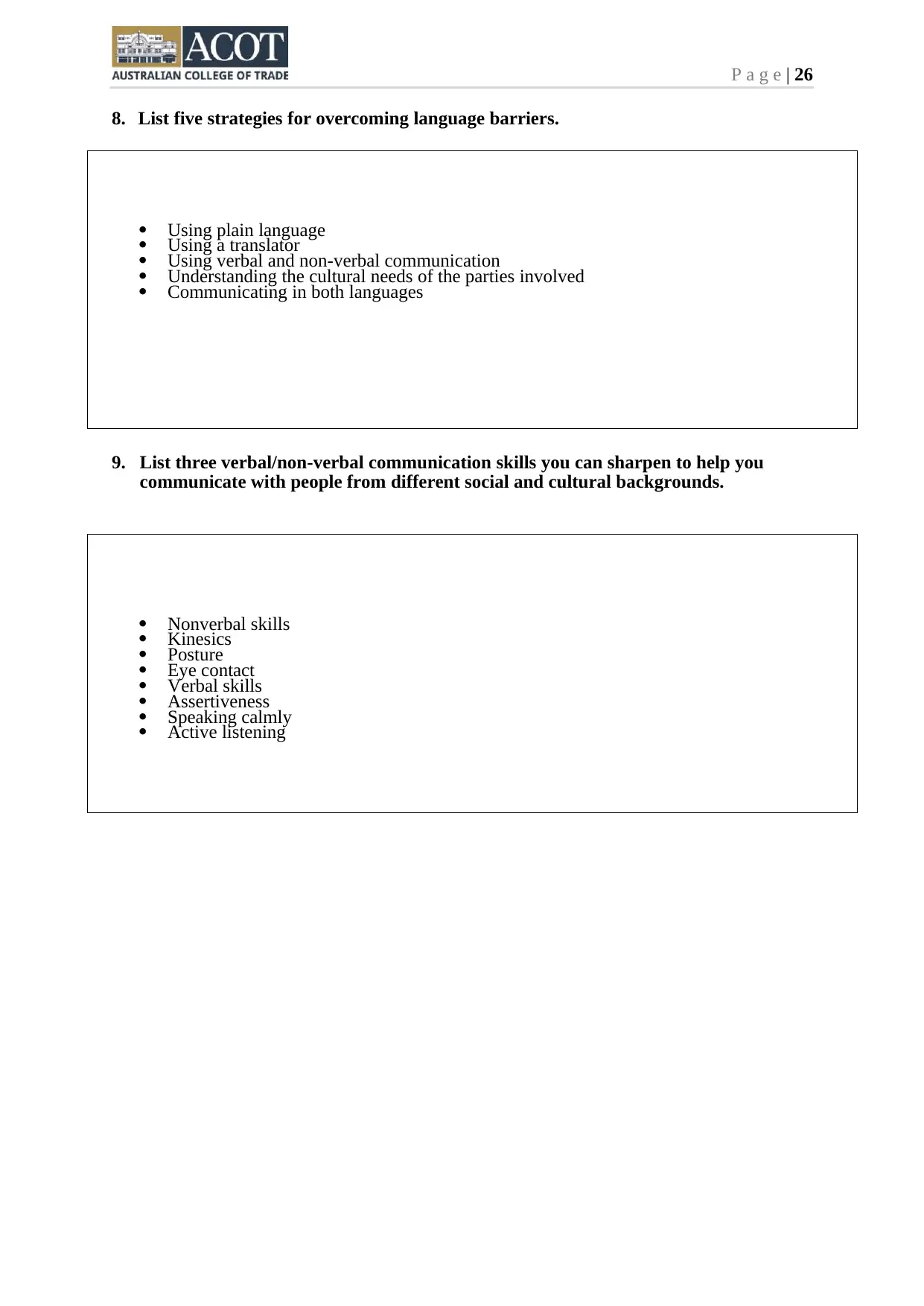
P a g e | 26
8. List five strategies for overcoming language barriers.
Using plain language
Using a translator
Using verbal and non-verbal communication
Understanding the cultural needs of the parties involved
Communicating in both languages
9. List three verbal/non-verbal communication skills you can sharpen to help you
communicate with people from different social and cultural backgrounds.
Nonverbal skills
Kinesics
Posture
Eye contact
Verbal skills
Assertiveness
Speaking calmly
Active listening
8. List five strategies for overcoming language barriers.
Using plain language
Using a translator
Using verbal and non-verbal communication
Understanding the cultural needs of the parties involved
Communicating in both languages
9. List three verbal/non-verbal communication skills you can sharpen to help you
communicate with people from different social and cultural backgrounds.
Nonverbal skills
Kinesics
Posture
Eye contact
Verbal skills
Assertiveness
Speaking calmly
Active listening
Secure Best Marks with AI Grader
Need help grading? Try our AI Grader for instant feedback on your assignments.

VCID. ACOT Training and Assessment/SITXCOM002/Learner Workbook/V1.2/July 2019
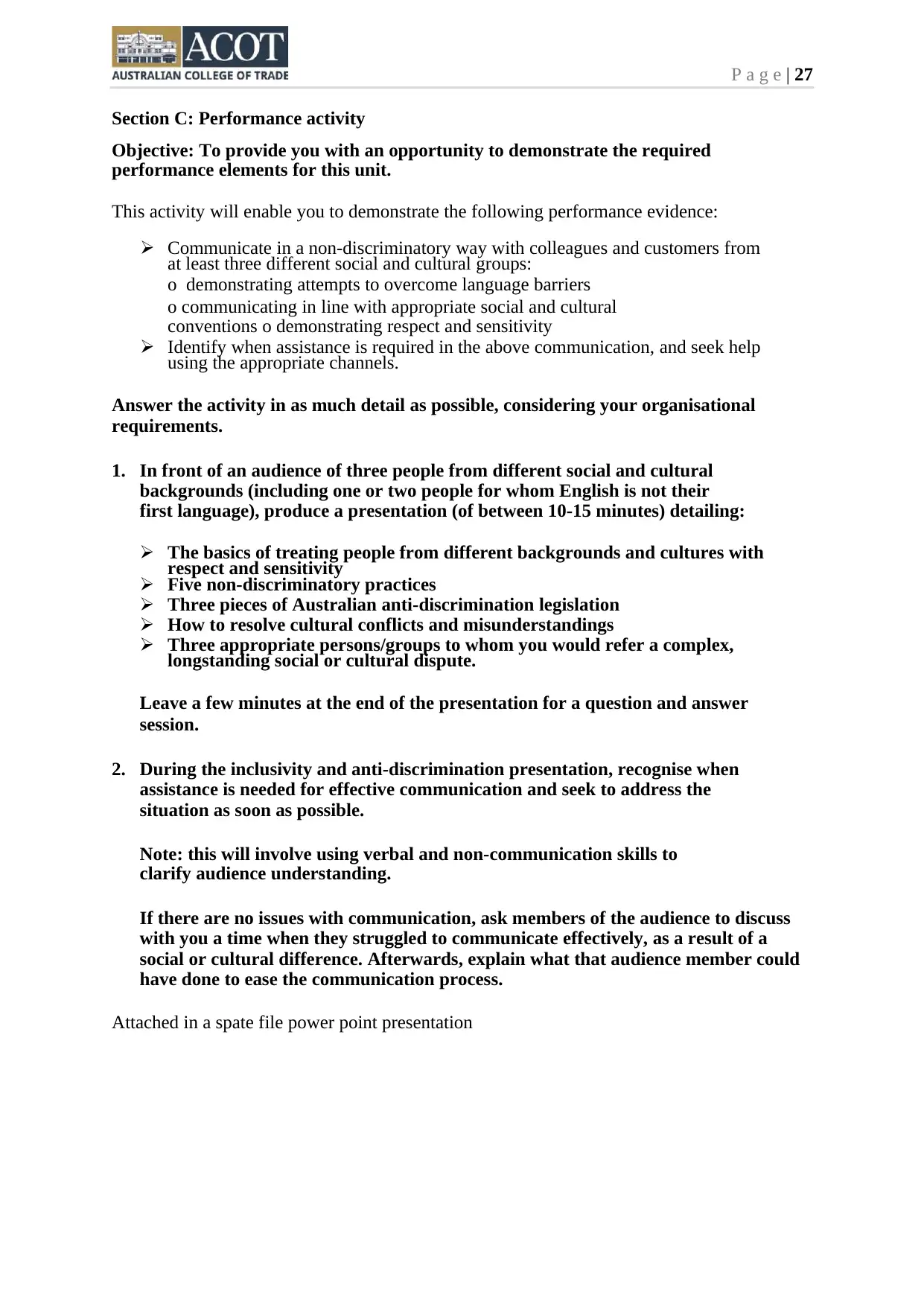
P a g e | 27
Section C: Performance activity
Objective: To provide you with an opportunity to demonstrate the required
performance elements for this unit.
This activity will enable you to demonstrate the following performance evidence:
➢ Communicate in a non-discriminatory way with colleagues and customers from
at least three different social and cultural groups:
o demonstrating attempts to overcome language barriers
o communicating in line with appropriate social and cultural
conventions o demonstrating respect and sensitivity
➢ Identify when assistance is required in the above communication, and seek help
using the appropriate channels.
Answer the activity in as much detail as possible, considering your organisational
requirements.
1. In front of an audience of three people from different social and cultural
backgrounds (including one or two people for whom English is not their
first language), produce a presentation (of between 10-15 minutes) detailing:
➢ The basics of treating people from different backgrounds and cultures with
respect and sensitivity
➢ Five non-discriminatory practices
➢ Three pieces of Australian anti-discrimination legislation
➢ How to resolve cultural conflicts and misunderstandings
➢ Three appropriate persons/groups to whom you would refer a complex,
longstanding social or cultural dispute.
Leave a few minutes at the end of the presentation for a question and answer
session.
2. During the inclusivity and anti-discrimination presentation, recognise when
assistance is needed for effective communication and seek to address the
situation as soon as possible.
Note: this will involve using verbal and non-communication skills to
clarify audience understanding.
If there are no issues with communication, ask members of the audience to discuss
with you a time when they struggled to communicate effectively, as a result of a
social or cultural difference. Afterwards, explain what that audience member could
have done to ease the communication process.
Attached in a spate file power point presentation
Section C: Performance activity
Objective: To provide you with an opportunity to demonstrate the required
performance elements for this unit.
This activity will enable you to demonstrate the following performance evidence:
➢ Communicate in a non-discriminatory way with colleagues and customers from
at least three different social and cultural groups:
o demonstrating attempts to overcome language barriers
o communicating in line with appropriate social and cultural
conventions o demonstrating respect and sensitivity
➢ Identify when assistance is required in the above communication, and seek help
using the appropriate channels.
Answer the activity in as much detail as possible, considering your organisational
requirements.
1. In front of an audience of three people from different social and cultural
backgrounds (including one or two people for whom English is not their
first language), produce a presentation (of between 10-15 minutes) detailing:
➢ The basics of treating people from different backgrounds and cultures with
respect and sensitivity
➢ Five non-discriminatory practices
➢ Three pieces of Australian anti-discrimination legislation
➢ How to resolve cultural conflicts and misunderstandings
➢ Three appropriate persons/groups to whom you would refer a complex,
longstanding social or cultural dispute.
Leave a few minutes at the end of the presentation for a question and answer
session.
2. During the inclusivity and anti-discrimination presentation, recognise when
assistance is needed for effective communication and seek to address the
situation as soon as possible.
Note: this will involve using verbal and non-communication skills to
clarify audience understanding.
If there are no issues with communication, ask members of the audience to discuss
with you a time when they struggled to communicate effectively, as a result of a
social or cultural difference. Afterwards, explain what that audience member could
have done to ease the communication process.
Attached in a spate file power point presentation

Paraphrase This Document
Need a fresh take? Get an instant paraphrase of this document with our AI Paraphraser
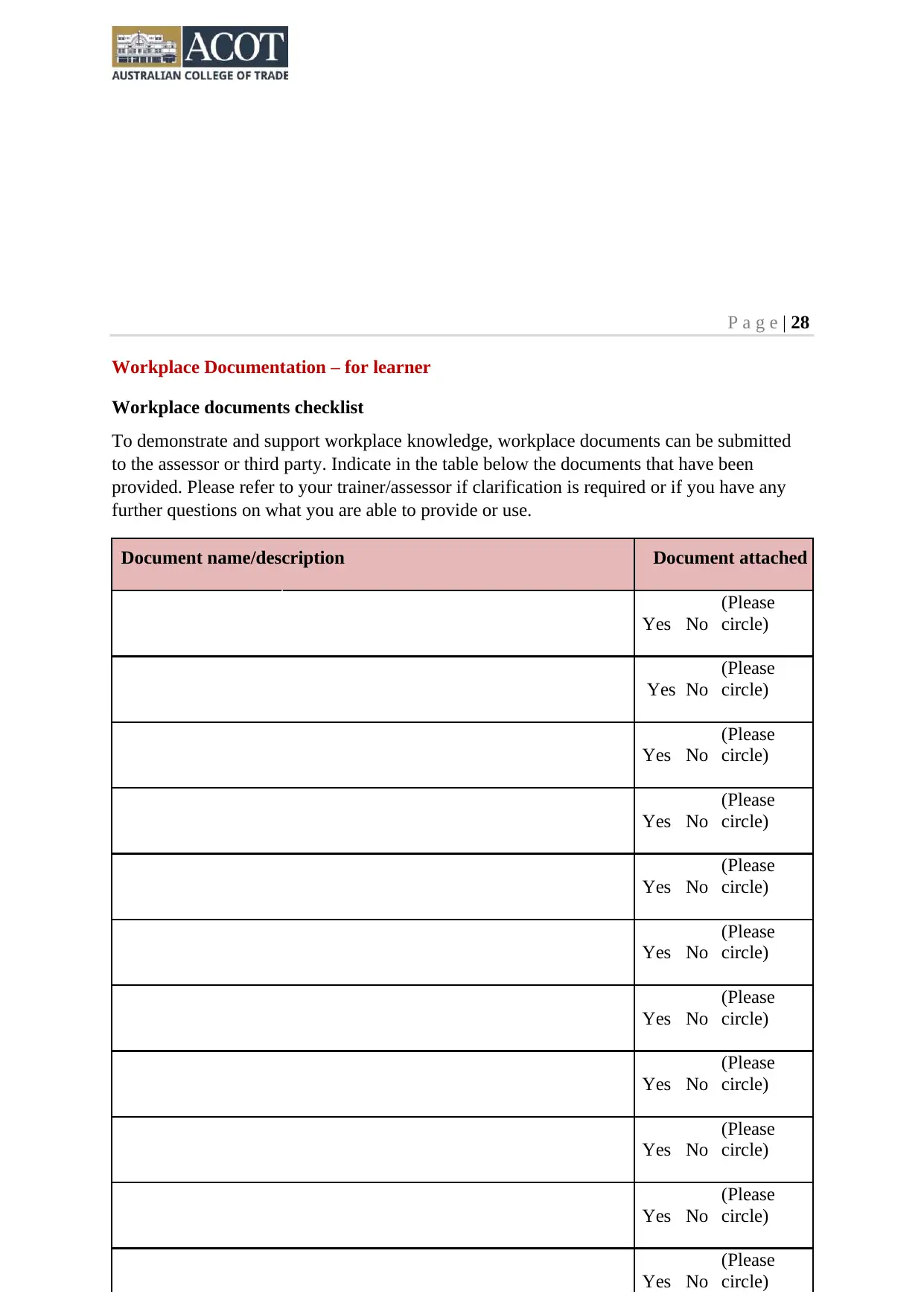
P a g e | 28
Workplace Documentation – for learner
Workplace documents checklist
To demonstrate and support workplace knowledge, workplace documents can be submitted
to the assessor or third party. Indicate in the table below the documents that have been
provided. Please refer to your trainer/assessor if clarification is required or if you have any
further questions on what you are able to provide or use.
Document name/description Document attached
Yes No
(Please
circle)
Yes No
(Please
circle)
Yes No
(Please
circle)
Yes No
(Please
circle)
Yes No
(Please
circle)
Yes No
(Please
circle)
Yes No
(Please
circle)
Yes No
(Please
circle)
Yes No
(Please
circle)
Yes No
(Please
circle)
Yes No
(Please
circle)
Workplace Documentation – for learner
Workplace documents checklist
To demonstrate and support workplace knowledge, workplace documents can be submitted
to the assessor or third party. Indicate in the table below the documents that have been
provided. Please refer to your trainer/assessor if clarification is required or if you have any
further questions on what you are able to provide or use.
Document name/description Document attached
Yes No
(Please
circle)
Yes No
(Please
circle)
Yes No
(Please
circle)
Yes No
(Please
circle)
Yes No
(Please
circle)
Yes No
(Please
circle)
Yes No
(Please
circle)
Yes No
(Please
circle)
Yes No
(Please
circle)
Yes No
(Please
circle)
Yes No
(Please
circle)
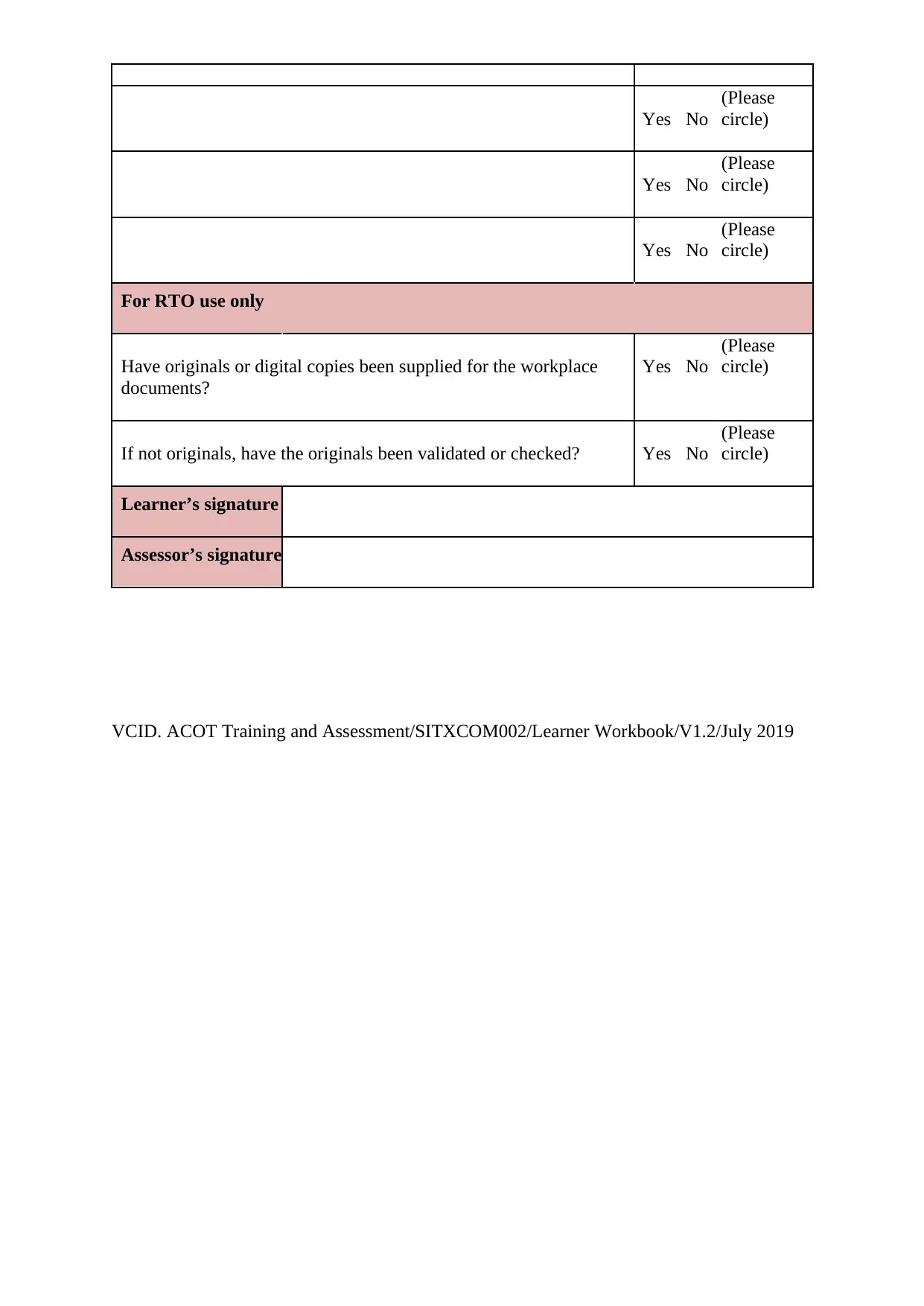
Yes No
(Please
circle)
Yes No
(Please
circle)
Yes No
(Please
circle)
For RTO use only
Have originals or digital copies been supplied for the workplace Yes No
(Please
circle)
documents?
If not originals, have the originals been validated or checked? Yes No
(Please
circle)
Learner’s signature
Assessor’s signature
VCID. ACOT Training and Assessment/SITXCOM002/Learner Workbook/V1.2/July 2019
(Please
circle)
Yes No
(Please
circle)
Yes No
(Please
circle)
For RTO use only
Have originals or digital copies been supplied for the workplace Yes No
(Please
circle)
documents?
If not originals, have the originals been validated or checked? Yes No
(Please
circle)
Learner’s signature
Assessor’s signature
VCID. ACOT Training and Assessment/SITXCOM002/Learner Workbook/V1.2/July 2019
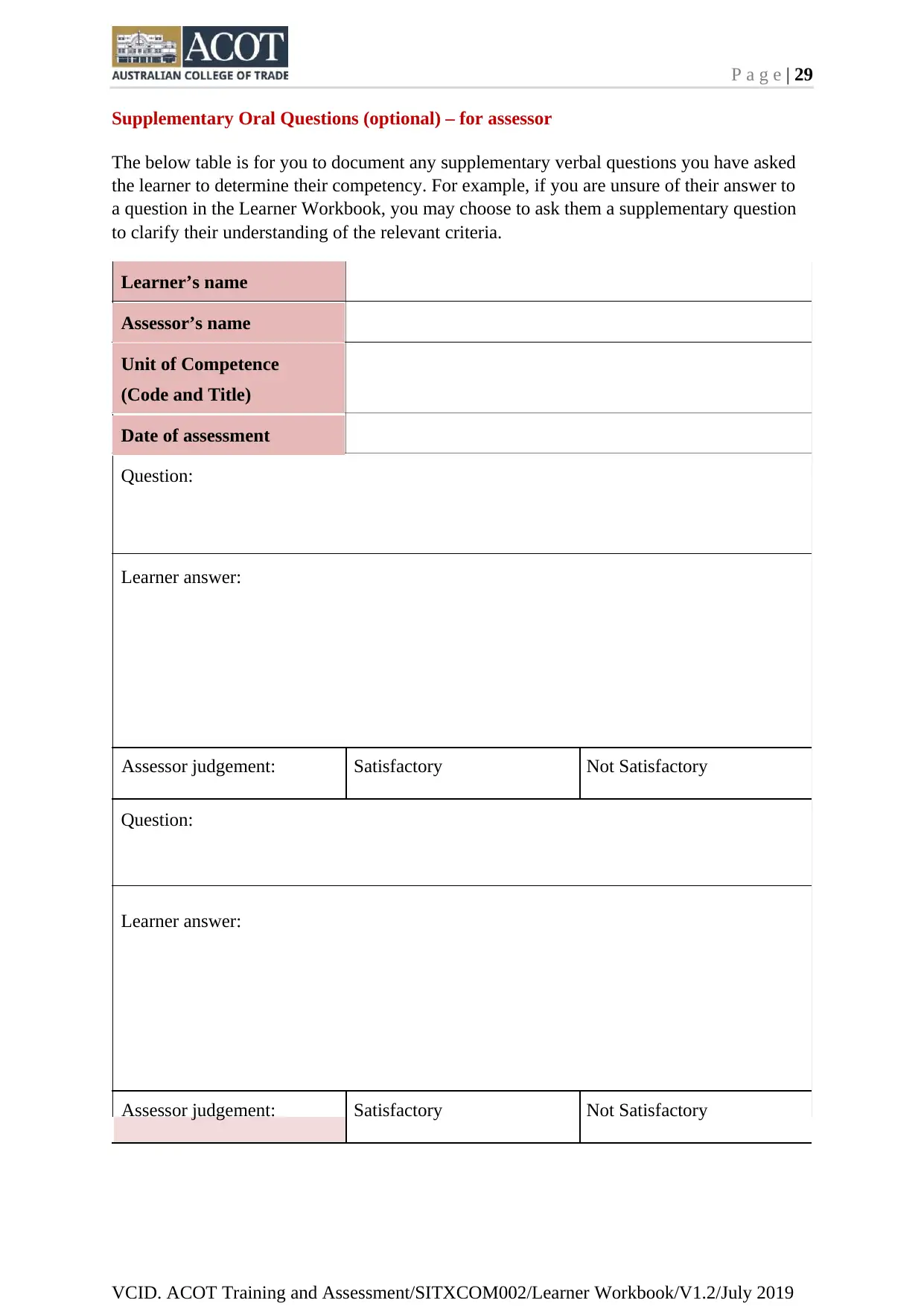
P a g e | 29
Supplementary Oral Questions (optional) – for assessor
The below table is for you to document any supplementary verbal questions you have asked
the learner to determine their competency. For example, if you are unsure of their answer to
a question in the Learner Workbook, you may choose to ask them a supplementary question
to clarify their understanding of the relevant criteria.
Learner’s name
Assessor’s name
Unit of Competence
(Code and Title)
Date of assessment
Question:
Learner answer:
Assessor judgement: Satisfactory Not Satisfactory
Question:
Learner answer:
Assessor judgement: Satisfactory Not Satisfactory
VCID. ACOT Training and Assessment/SITXCOM002/Learner Workbook/V1.2/July 2019
Supplementary Oral Questions (optional) – for assessor
The below table is for you to document any supplementary verbal questions you have asked
the learner to determine their competency. For example, if you are unsure of their answer to
a question in the Learner Workbook, you may choose to ask them a supplementary question
to clarify their understanding of the relevant criteria.
Learner’s name
Assessor’s name
Unit of Competence
(Code and Title)
Date of assessment
Question:
Learner answer:
Assessor judgement: Satisfactory Not Satisfactory
Question:
Learner answer:
Assessor judgement: Satisfactory Not Satisfactory
VCID. ACOT Training and Assessment/SITXCOM002/Learner Workbook/V1.2/July 2019
Secure Best Marks with AI Grader
Need help grading? Try our AI Grader for instant feedback on your assignments.
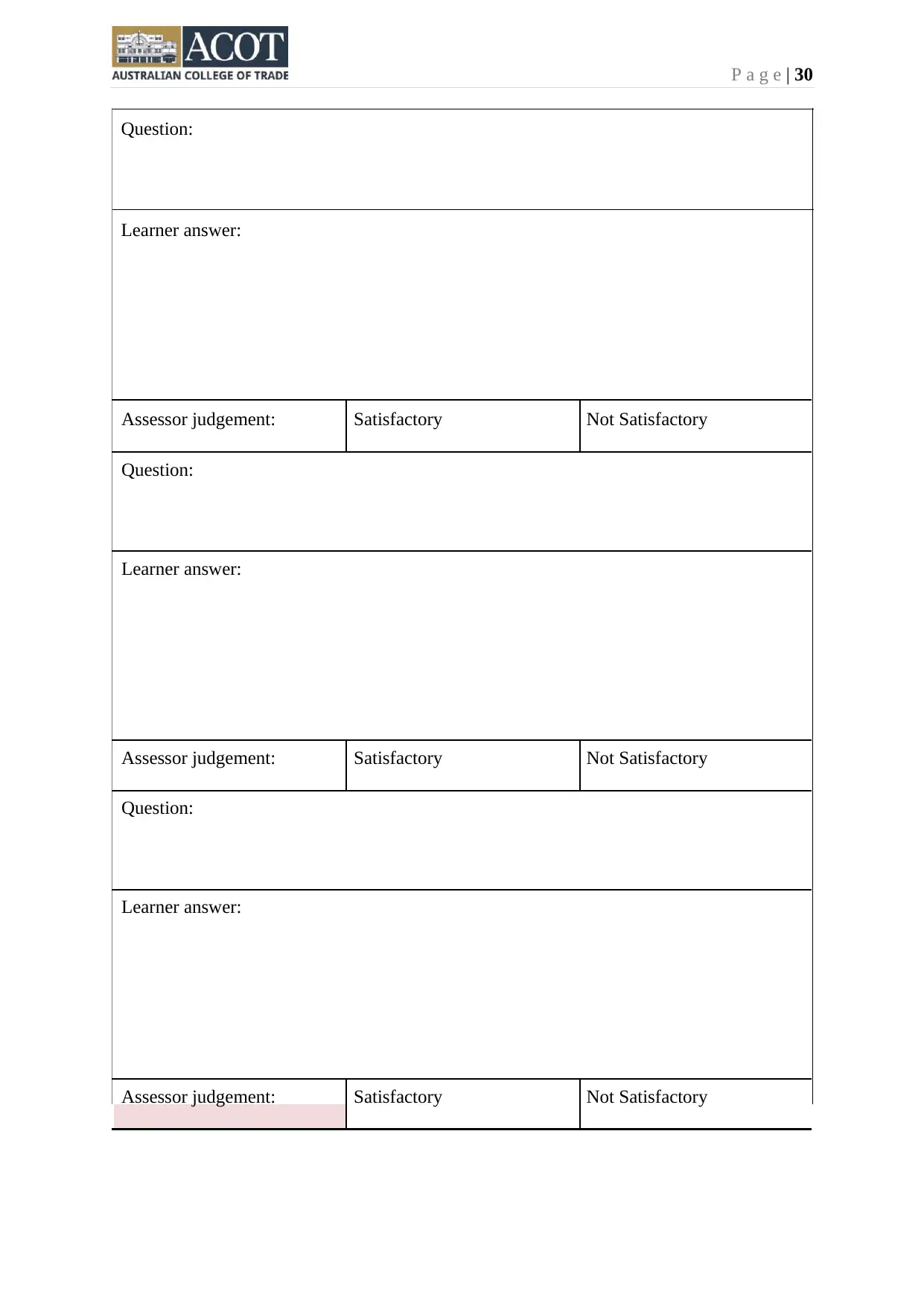
P a g e | 30
Question:
Learner answer:
Assessor judgement: Satisfactory Not Satisfactory
Question:
Learner answer:
Assessor judgement: Satisfactory Not Satisfactory
Question:
Learner answer:
Assessor judgement: Satisfactory Not Satisfactory
Question:
Learner answer:
Assessor judgement: Satisfactory Not Satisfactory
Question:
Learner answer:
Assessor judgement: Satisfactory Not Satisfactory
Question:
Learner answer:
Assessor judgement: Satisfactory Not Satisfactory

VCID. ACOT Training and Assessment/SITXCOM002/Learner Workbook/V1.2/July 2019
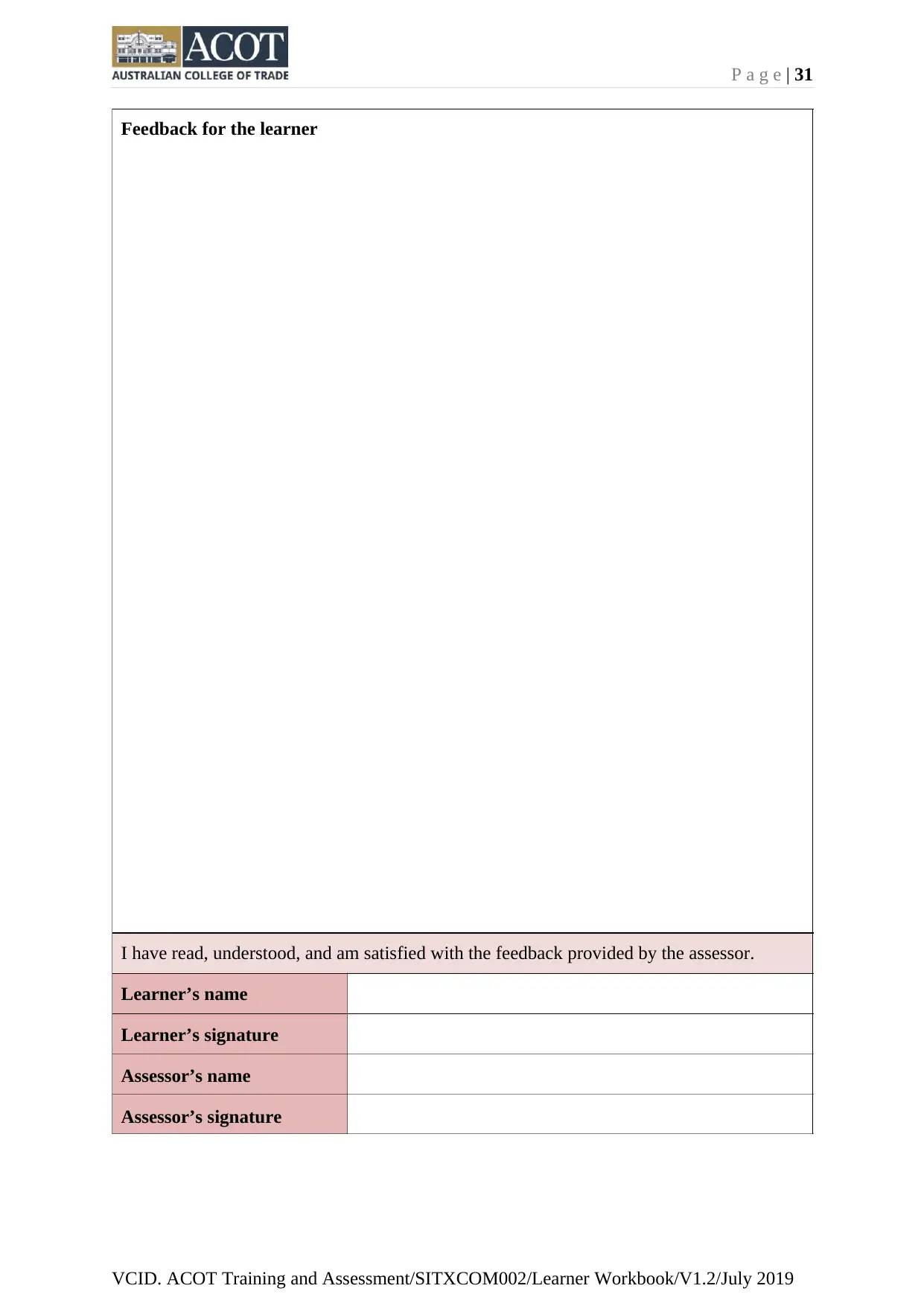
P a g e | 31
Feedback for the learner
I have read, understood, and am satisfied with the feedback provided by the assessor.
Learner’s name
Learner’s signature
Assessor’s name
Assessor’s signature
VCID. ACOT Training and Assessment/SITXCOM002/Learner Workbook/V1.2/July 2019
Feedback for the learner
I have read, understood, and am satisfied with the feedback provided by the assessor.
Learner’s name
Learner’s signature
Assessor’s name
Assessor’s signature
VCID. ACOT Training and Assessment/SITXCOM002/Learner Workbook/V1.2/July 2019
Paraphrase This Document
Need a fresh take? Get an instant paraphrase of this document with our AI Paraphraser
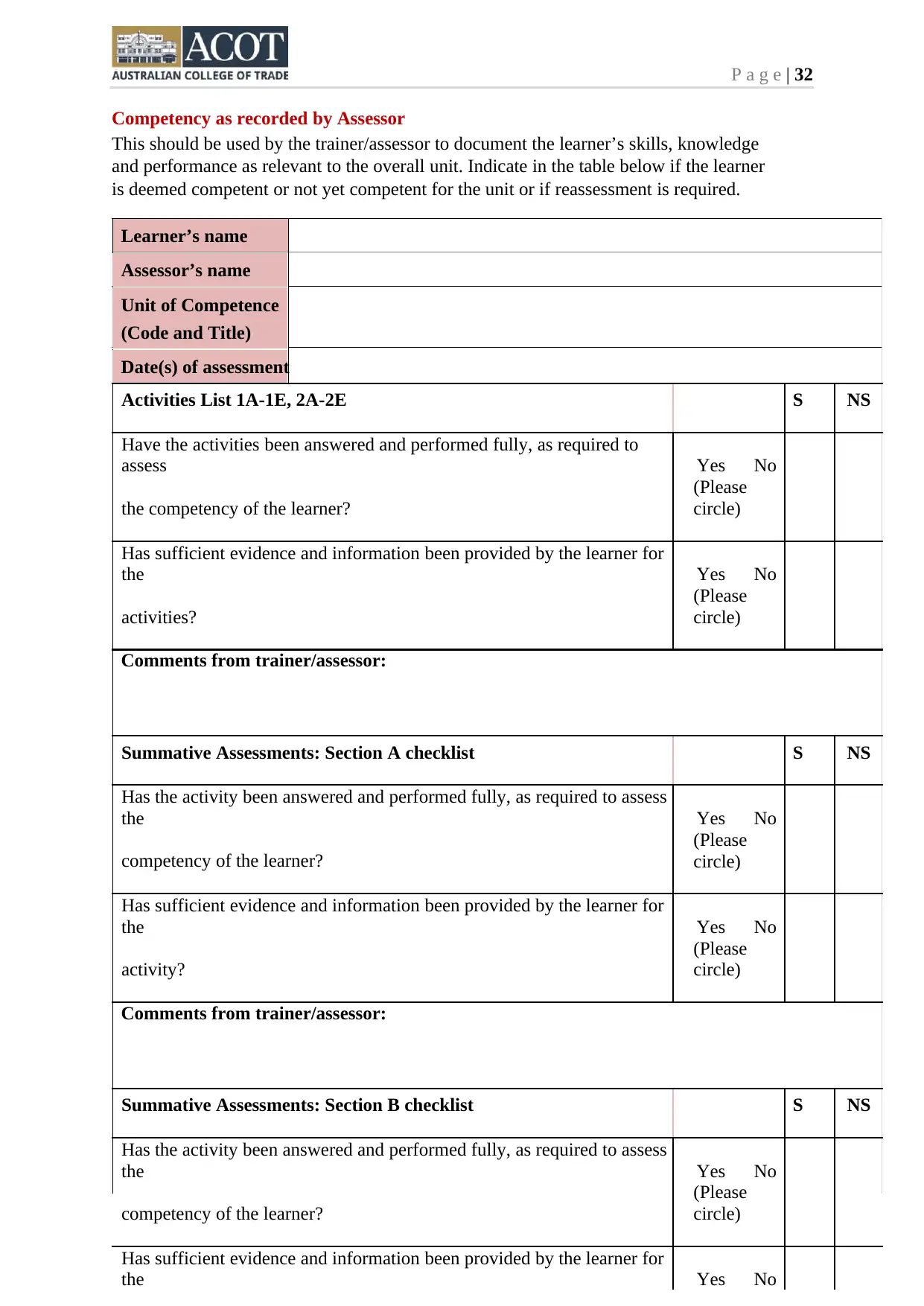
P a g e | 32
Competency as recorded by Assessor
This should be used by the trainer/assessor to document the learner’s skills, knowledge
and performance as relevant to the overall unit. Indicate in the table below if the learner
is deemed competent or not yet competent for the unit or if reassessment is required.
Learner’s name
Assessor’s name
Unit of Competence
(Code and Title)
Date(s) of assessment
Activities List 1A-1E, 2A-2E S NS
Have the activities been answered and performed fully, as required to
assess Yes No
the competency of the learner?
(Please
circle)
Has sufficient evidence and information been provided by the learner for
the Yes No
activities?
(Please
circle)
Comments from trainer/assessor:
Summative Assessments: Section A checklist S NS
Has the activity been answered and performed fully, as required to assess
the Yes No
competency of the learner?
(Please
circle)
Has sufficient evidence and information been provided by the learner for
the Yes No
activity?
(Please
circle)
Comments from trainer/assessor:
Summative Assessments: Section B checklist S NS
Has the activity been answered and performed fully, as required to assess
the Yes No
competency of the learner?
(Please
circle)
Has sufficient evidence and information been provided by the learner for
the Yes No
Competency as recorded by Assessor
This should be used by the trainer/assessor to document the learner’s skills, knowledge
and performance as relevant to the overall unit. Indicate in the table below if the learner
is deemed competent or not yet competent for the unit or if reassessment is required.
Learner’s name
Assessor’s name
Unit of Competence
(Code and Title)
Date(s) of assessment
Activities List 1A-1E, 2A-2E S NS
Have the activities been answered and performed fully, as required to
assess Yes No
the competency of the learner?
(Please
circle)
Has sufficient evidence and information been provided by the learner for
the Yes No
activities?
(Please
circle)
Comments from trainer/assessor:
Summative Assessments: Section A checklist S NS
Has the activity been answered and performed fully, as required to assess
the Yes No
competency of the learner?
(Please
circle)
Has sufficient evidence and information been provided by the learner for
the Yes No
activity?
(Please
circle)
Comments from trainer/assessor:
Summative Assessments: Section B checklist S NS
Has the activity been answered and performed fully, as required to assess
the Yes No
competency of the learner?
(Please
circle)
Has sufficient evidence and information been provided by the learner for
the Yes No
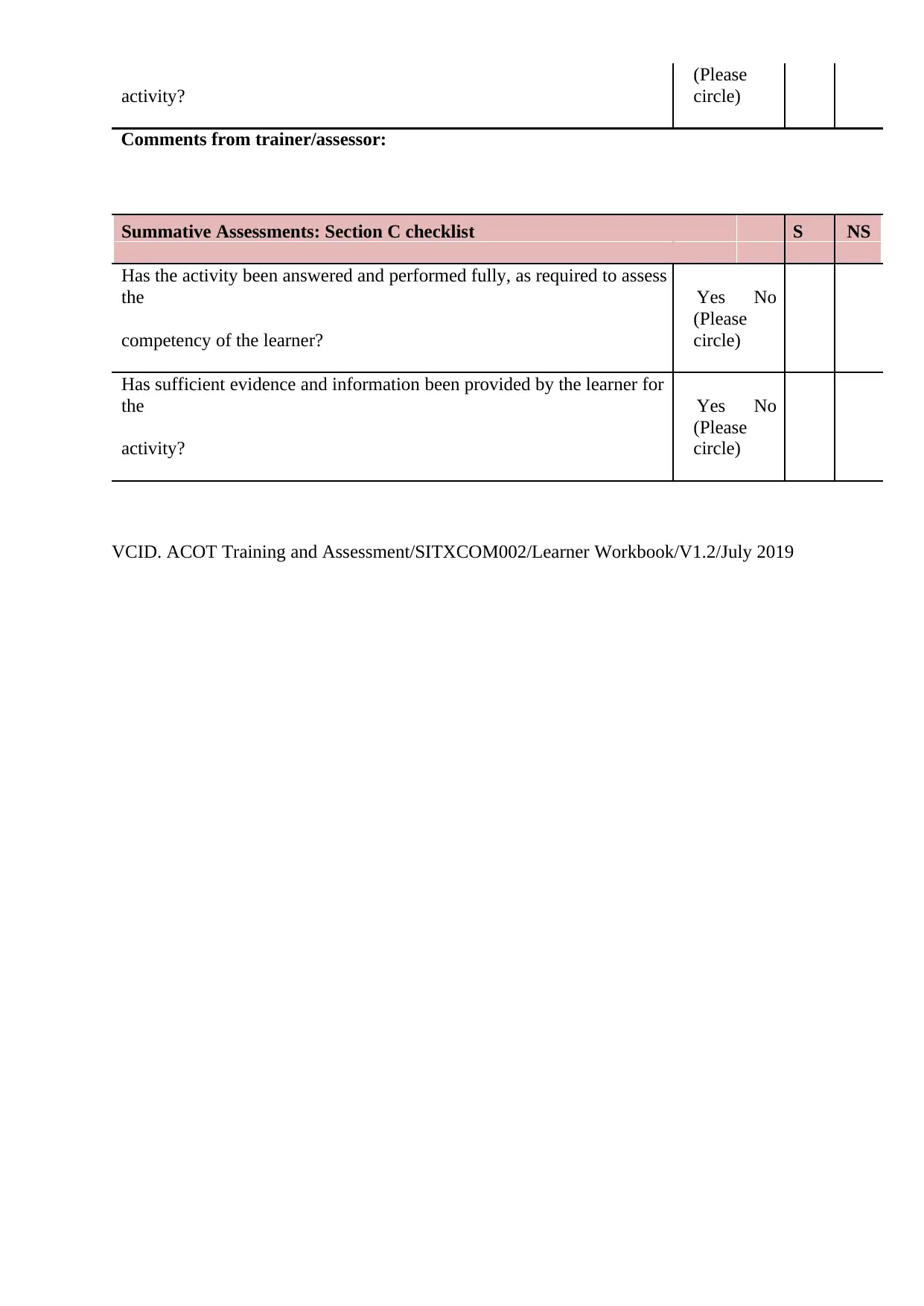
activity?
(Please
circle)
Comments from trainer/assessor:
Summative Assessments: Section C checklist S NS
Has the activity been answered and performed fully, as required to assess
the Yes No
competency of the learner?
(Please
circle)
Has sufficient evidence and information been provided by the learner for
the Yes No
activity?
(Please
circle)
VCID. ACOT Training and Assessment/SITXCOM002/Learner Workbook/V1.2/July 2019
(Please
circle)
Comments from trainer/assessor:
Summative Assessments: Section C checklist S NS
Has the activity been answered and performed fully, as required to assess
the Yes No
competency of the learner?
(Please
circle)
Has sufficient evidence and information been provided by the learner for
the Yes No
activity?
(Please
circle)
VCID. ACOT Training and Assessment/SITXCOM002/Learner Workbook/V1.2/July 2019
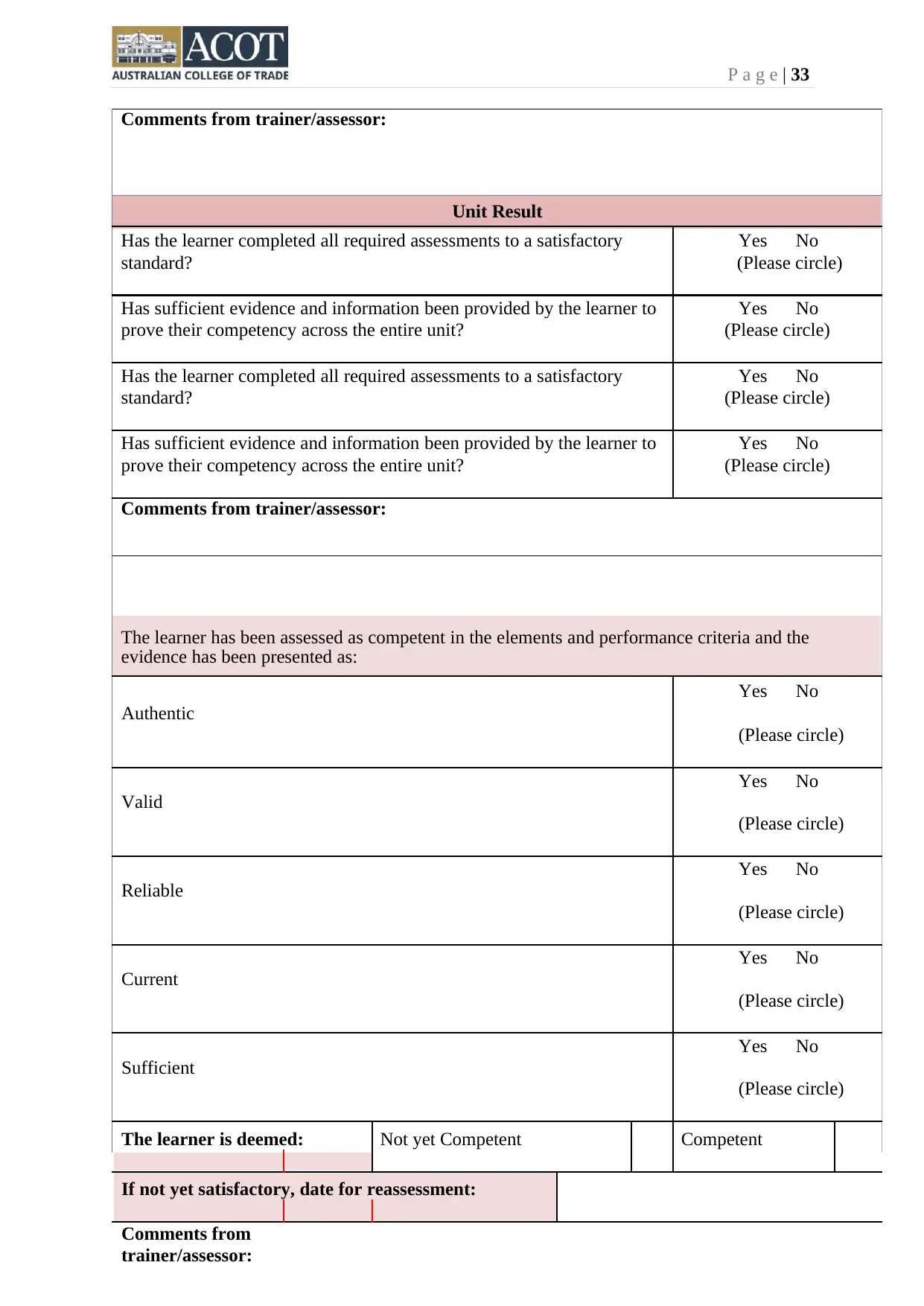
P a g e | 33
Comments from trainer/assessor:
Unit Result
Has the learner completed all required assessments to a satisfactory Yes No
standard? (Please circle)
Has sufficient evidence and information been provided by the learner to Yes No
prove their competency across the entire unit? (Please circle)
Has the learner completed all required assessments to a satisfactory Yes No
standard? (Please circle)
Has sufficient evidence and information been provided by the learner to Yes No
prove their competency across the entire unit? (Please circle)
Comments from trainer/assessor:
The learner has been assessed as competent in the elements and performance criteria and the
evidence has been presented as:
Authentic
Yes No
(Please circle)
Valid
Yes No
(Please circle)
Reliable
Yes No
(Please circle)
Current
Yes No
(Please circle)
Sufficient
Yes No
(Please circle)
The learner is deemed: Not yet Competent Competent
If not yet satisfactory, date for reassessment:
Comments from
trainer/assessor:
Comments from trainer/assessor:
Unit Result
Has the learner completed all required assessments to a satisfactory Yes No
standard? (Please circle)
Has sufficient evidence and information been provided by the learner to Yes No
prove their competency across the entire unit? (Please circle)
Has the learner completed all required assessments to a satisfactory Yes No
standard? (Please circle)
Has sufficient evidence and information been provided by the learner to Yes No
prove their competency across the entire unit? (Please circle)
Comments from trainer/assessor:
The learner has been assessed as competent in the elements and performance criteria and the
evidence has been presented as:
Authentic
Yes No
(Please circle)
Valid
Yes No
(Please circle)
Reliable
Yes No
(Please circle)
Current
Yes No
(Please circle)
Sufficient
Yes No
(Please circle)
The learner is deemed: Not yet Competent Competent
If not yet satisfactory, date for reassessment:
Comments from
trainer/assessor:
Secure Best Marks with AI Grader
Need help grading? Try our AI Grader for instant feedback on your assignments.
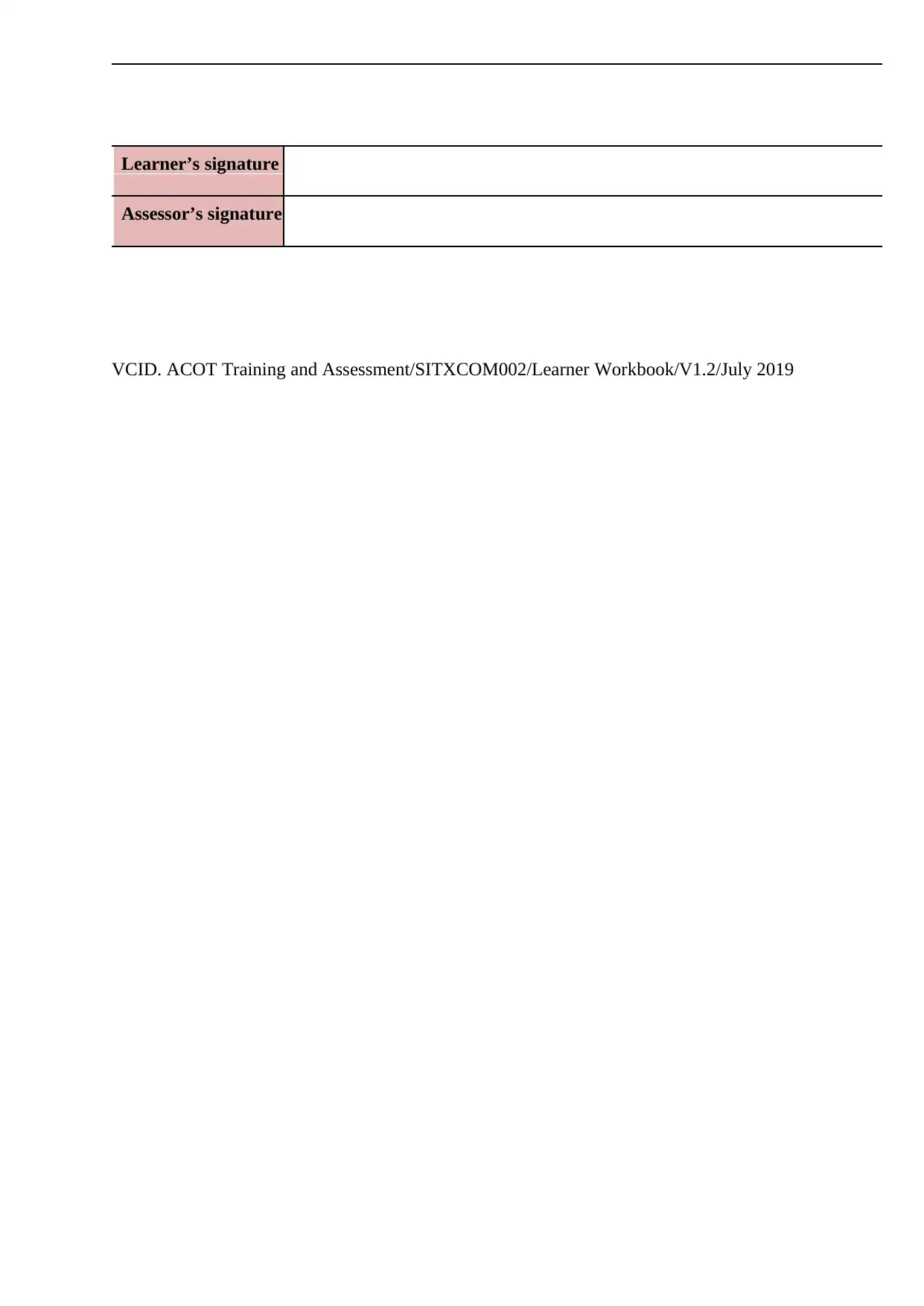
Learner’s signature
Assessor’s signature
VCID. ACOT Training and Assessment/SITXCOM002/Learner Workbook/V1.2/July 2019
Assessor’s signature
VCID. ACOT Training and Assessment/SITXCOM002/Learner Workbook/V1.2/July 2019
1 out of 53
Your All-in-One AI-Powered Toolkit for Academic Success.
+13062052269
info@desklib.com
Available 24*7 on WhatsApp / Email
![[object Object]](/_next/static/media/star-bottom.7253800d.svg)
Unlock your academic potential
© 2024 | Zucol Services PVT LTD | All rights reserved.

